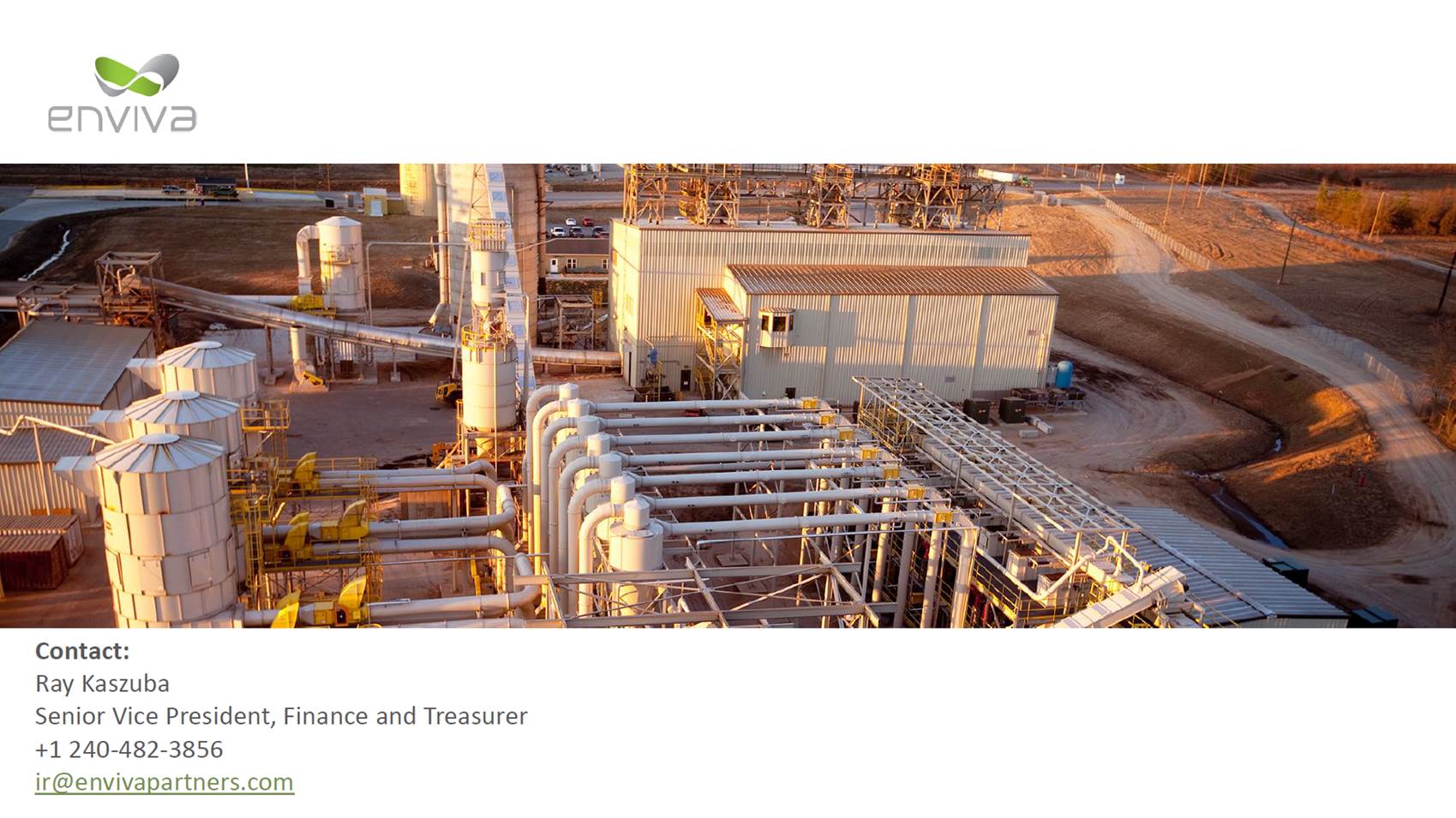env1va ----Enviva Partners, LP (NYSE: EVA) Business Overview Last Updated: August 12, 2019

FORWARD-LOOKING AND CAUTIONARY STATEMENTS Forward-looking statements This presentation contains “forward-looking statements” within the meaning of the securities laws. All statements, other than statements of historical fact, included in this presentation that address activities, events or developments that Enviva Partners, LP (NYSE: EVA) (“Enviva,” the “Partnership,” “we,” or “us”) expects, believes or anticipates will or may occur in the future are forward-looking statements. The words “believe,” “expect,” “may,” “estimates,” “will,” “anticipate,” “plan,” “intend,” “foresee,” “should,” “would,” “could,” or other similar expressions are intended to identify forward-looking statements, which are generally not historical in nature. However, the absence of these words does not mean that the statements are not forward-looking. These statements are based on certain assumptions made by Enviva based on management’s expectations and perception of historical trends, current conditions, anticipated future developments, and other factors believed to be appropriate. Although Enviva believes that these assumptions were reasonable when made, because assumptions are inherently subject to significant uncertainties and contingencies that are difficult or impossible to predict and are beyond its control, Enviva cannot give assurance that it will achieve or accomplish these expectations, beliefs or intentions. A number of the assumptions on which these forward-looking statements are based are subject to risks and uncertainties, many of which are beyond the control of Enviva, and may cause actual results to differ materially from those implied or expressed by the forward-looking statements. These risks and uncertainties include the factors discussed or referenced in our filings with the Securities and Exchange Commission (the “SEC”), including the Annual Report on Form 10-K and the Quarterly Reports on Form 10-Q most recently filed with the SEC, including those risks relating to financial performance and results, economic conditions and resulting capital restraints, availability of sufficient capital to execute Enviva’s business plan, the ability of Enviva to complete acquisitions and realize the anticipated benefits of such acquisitions, impact of compliance with legislation and regulations and other important factors that could cause actual results to differ materially from those projected. When considering the forward-looking statements, you should keep in mind the risk factors and other cautionary statements in such filings. You are cautioned not to place undue reliance on forward-looking statements, which speak only as of the date on which such statement is made, and Enviva undertakes no obligation to correct or update any forward-looking statement, whether as a result of new information, future events or otherwise, except as required by applicable law. All forward-looking statements attributable to Enviva are qualified in their entirety by this cautionary statement. Industry and market data This presentation has been prepared by Enviva and includes market data and other statistical information from third-party sources, including independent industry publications, government publications or other published independent sources. Although Enviva believes these third-party sources are reliable as of their respective dates, Enviva has not independently verified the accuracy or completeness of this information. Some data is also based on Enviva’s good faith estimates, which are derived from its review of internal sources as well as the third-party sources described above. 2
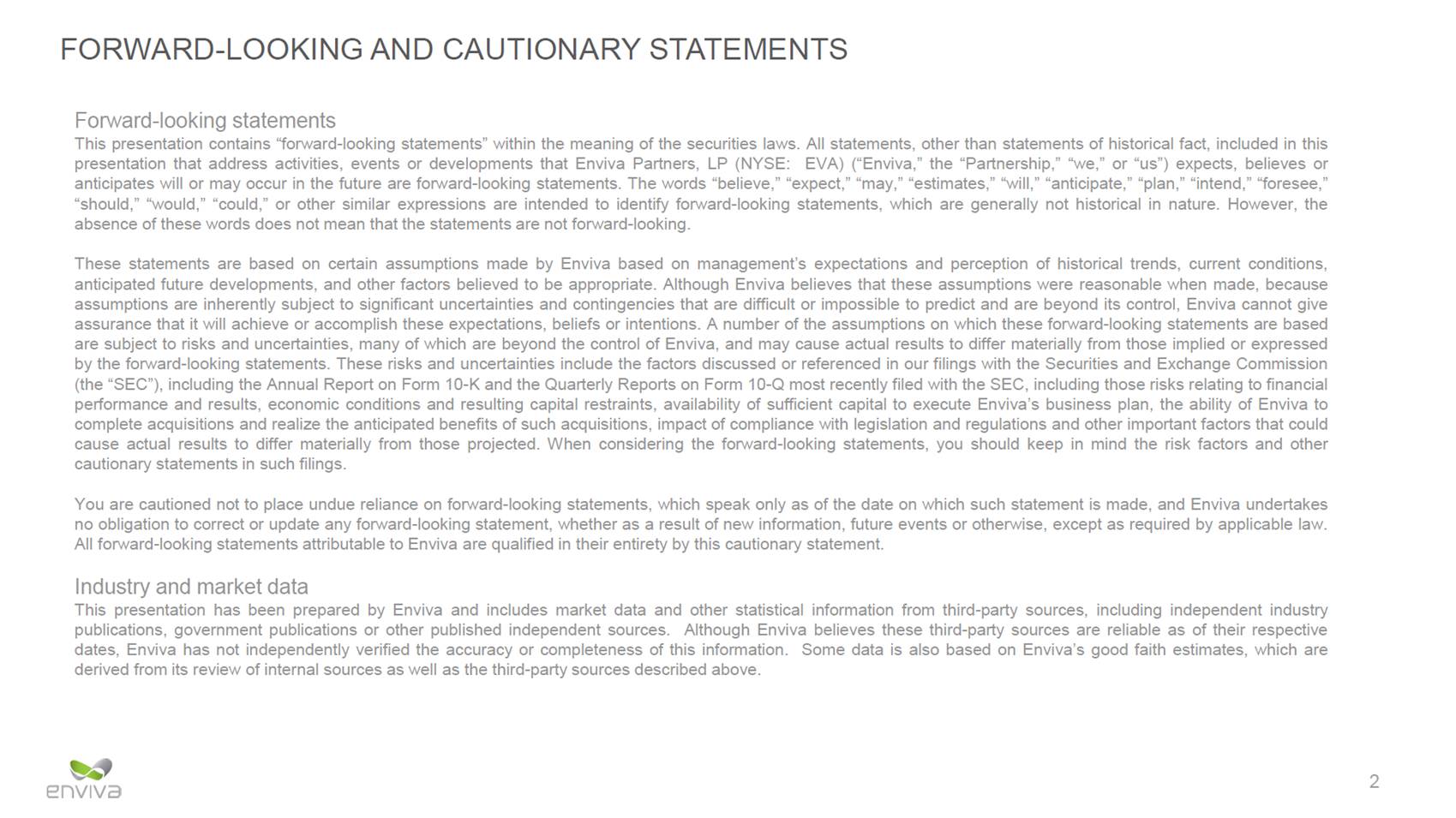
COMPANY HIGHLIGHTS: HIGH-GROWTH, “DROP-DOWN” MLP Strong fiber baskets deliver low-cost, growing natural resource, and stable pricing and $2.87 to $2.97 for full-year 2020.7 Targeted annual distribution coverage ratio for the full years of 2019 and 2020 is at least 1.20 times, on a forward MANAGEMENT 1) Hawkins Wright: The Outlook for Wood Pellets – Demand, Supply, Costs and Prices; 2nd Quarter 2019. Worldwide demand for industrial pellets is expected to reach approximately 33 million MTPY by 2028; 2) As of August 5, 2019, excluding firm and contingent contracts between our long-term off-take customers and Enviva Holdings, LP (our “Sponsor”) and the Second JV; 3) References to the “First JV” refer to Enviva Wilmington Holdings, LLC, the Partnership’s joint venture. References to the “Second JV” refers to Enviva JV Development Company, LLC, our Sponsor’s joint venture; 4) Includes contracts between our long-term off-take customers and the Partnership, our Sponsor, and the Second JV. See slide 23 for additional details. We expect to have the opportunity to acquire customer contracts from our Sponsor or the Second JV in the future; 5) On March 25, 2019, provided full-year 2021 guidance for net income in the range of $87.7 million to $117.7 million and adjusted EBITDA in the range of $210.0 million to $240.0 million; 6) Initial public offering of the Partnership’s common units representing limited partner interests; 7) On August 8, 2019, reaffirmed distribution guidance per common unit of at least $2.65 for full-year 2019 and $2.87 to $2.97 for full-year 2020; 8) Additional details are available as part of our press release as of March 25, 2019; 9) The Second JV is progressing development of its deep-water marine terminal in Pascagoula, Mississippi (the “Pascagoula terminal”) and its wood pellet production plant in Lucedale, Mississippi (the “Lucedale plant”) and continues to invest incremental capital in its wood pellet production plant in Greenwood, South Carolina (the “Greenwood plant”) 3 EXPERIENCED Management team led by industry founders and seasoned public company executives Demonstrated expertise acquiring, building, operating, and contracting / re-contracting platform assets Management rewarded for sustained growth in per-unit distributable cash flow Expect to exit 2020 with run-rate adjusted EBITDA well in excess of $200 million annually.5 Potential to more than double the Partnership’s 2019 adjusted EBITDA in a few years with drop-downs, expansions, and 7-10% anticipated annual organic growth 16 consecutive distribution increases since the Partnership’s IPO in 2015.6 Expect aggregate per-unit distributions of at least $2.65 for full-year 2019 looking basis8 Consistent track record of development of production plants and terminal assets by the Sponsor and subsequent drop-down into the Partnership Our Sponsor and the Second JV’s long-term contracts, with weighted-average remaining term of 16.7 years and contracted revenue backlog of $8.3 billion, underwrite the Greenwood plant, the Lucedale plant, and two additional plants around the Pascagoula terminal9 Sales strategy is to fully contract our production capacity under long-term, take-or-pay contracts Contracts carry a weighted-average remaining term of 10.4 years and a contracted revenue backlog of $9.6 billion2, increasing to 13.2 years and $17.9 billion, respectively, if volumes held by the Partnership, our Sponsor and the Second JV are included3 Approximately 3 million MTPY of long-term contracts with Japanese counterparties, including Marubeni, Mitsubishi, Sumitomo, and Toyota Tsusho4 Fully-contracted, strategically located production plants exporting through multiple deep-water marine terminals Embedded low cost to-port logistics and favorable long-term fixed-rate shipping contracts COMPELLING INDUSTRY FUNDAMENTALS ADVANTAGED ASSETS LONG-TERM OFF-TAKE CONTRACTS SUBSTANTIAL GROWTH OPPORTUNITIES Critical supply chain partner for major power generators worldwide Binding European renewables obligations under the Renewable Energy Directives (“RED I/II”) and regulatory phase-out of coal in the UK, the Netherlands, and Germany driving substantial expected long-term demand increases Emerging demand in Japan and Asia expected to double worldwide market size1 Supply not adequate for demand with few providers of scale WORLD’S LARGEST SUPPLIER OF UTILITY-GRADE WOOD PELLETS TO MAJOR POWER GENERATORS WITH ALMOST 3.5 MILLION METRIC TONS PER YEAR (“MTPY”) OF FULLY CONTRACTED PRODUCTION CAPACITY
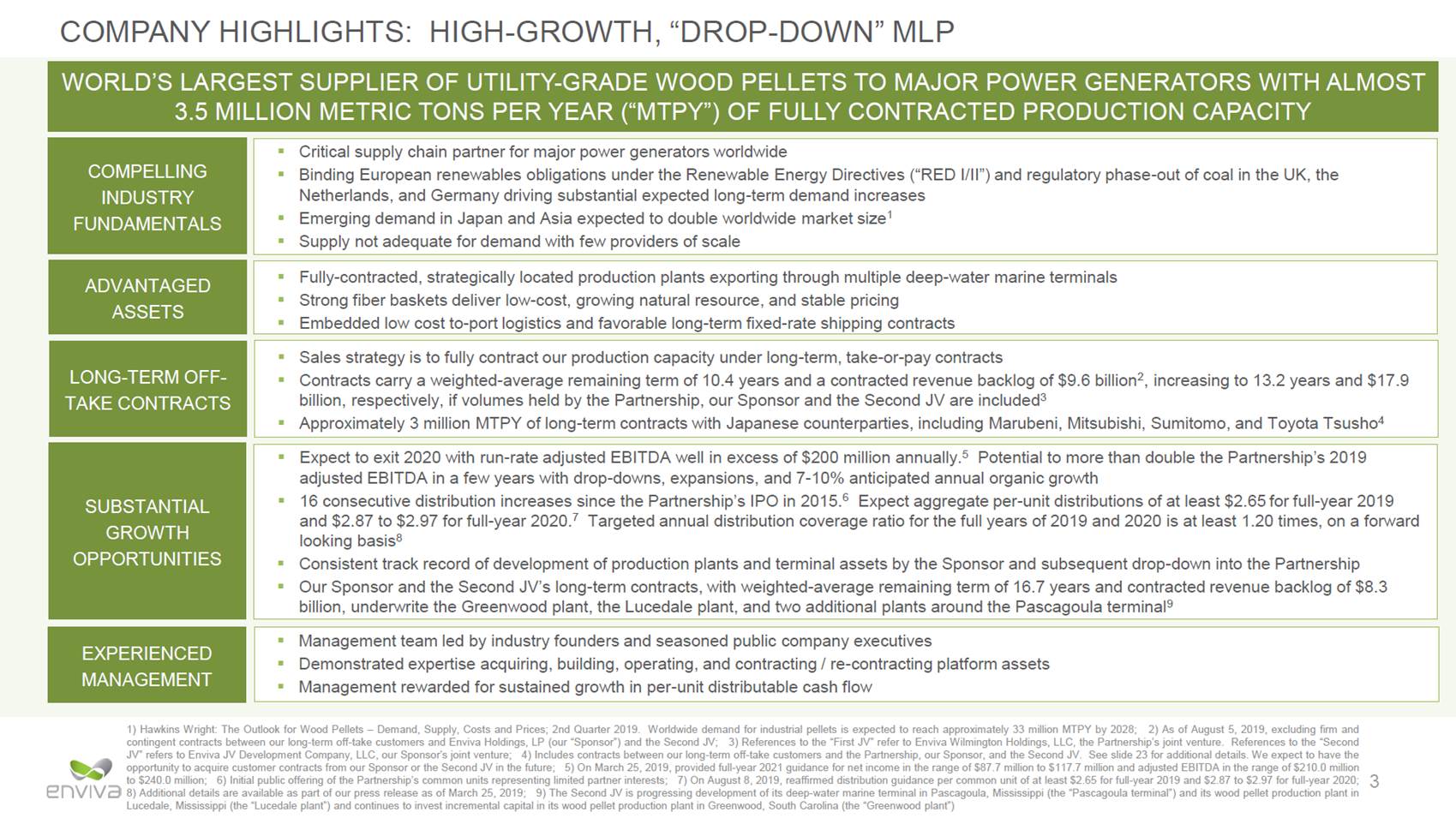
ENVIVA IMPROVES THE ENVIRONMENT BY DISPLACING COAL1 AND GROWING MORE TREES2 1) Increasing the share of biomass on the global energy grid is critical to the global energy transition. International Renewable Energy Agency’s Global Energy Transformation: A Roadmap to 2050 (2019 Edition) report calls for the share of modern biomass for electricity generation to increase from 5% in 2016 to 16% in 2050, and the share of coal for electricity generation to decrease from 14% to 3% over the same period Landowners in the US South respond to strong markets for forest products by making investments in their forests and there is a clear positive relationship between rates of forest harvest and forest acreage, growth, and inventory. Based on FIA data for the US South covering the 70-year period since 1953, Forest2Market concluded that “Increased demand for wood … encouraged landowners to invest in productivity improvements that dramatically increased the amount of wood fiber, and therefore the amount of carbon, contained in the South’s forests.” Source: Forest2Market report, Historical Perspective on the Relationship between Demand and Forest Productivity in the US South, July 2017 Eurostat. Inland coal consumption in key European countries that Enviva serves Industrial wood pellet demand for Belgium, Denmark, Netherlands and United Kingdom. Hawkins Wright: The Outlook for Wood Pellets – Demand, Supply, Costs and Prices; 1st Quarter 2019 FIA Data. Enviva’s primary sourcing regions consist of the Chesapeake (NC, VA); Sampson (NC); Greenwood (SC, GA); and Gulf (AL, FL and GA) regions 2) 3) 4) 5) 4 Million MT Million MT Million MT Through 2018, wood pellets supplied by the Partnership and our Sponsor have effectively displaced 14 million metric tons (“MT”) of coal. With existing contracts running through 2044, the Partnership and our Sponsor are on track to displace another 80 million MT of coal Strong Forest Inventory Growth in Enviva’s Sourcing Regions5 2,350 2,300 2,250 2,200 2,150 2,100 2,050 2,000 1,950 201220132014201520162017 Wood Pellet Consumption Doubled4 12 10 8 6 4 2 0 201220132014201520162017 Coal Consumption Declined by More than Half3 120 100 80 60 40 20 0 201220132014201520162017 BelgiumDenmarkNetherlandsUK
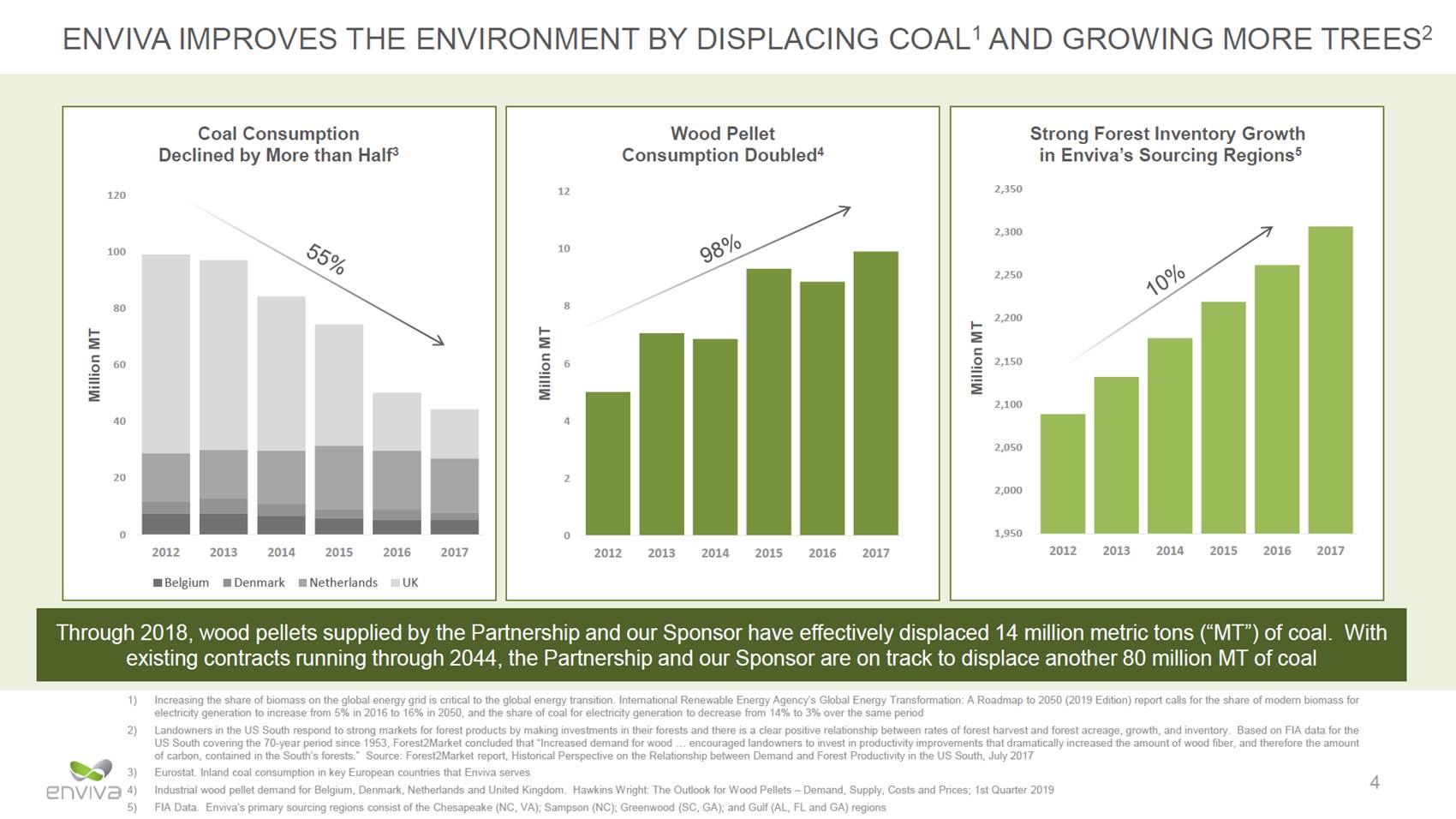
ENVIVA SOLVES A GROWING, UNMET CHALLENGE FOR GENERATORS Wood pellets provide the low-cost, drop-in solution for coal Enviva is only enterprise supplier of scale Market growing rapidly to 31.3 million MTPY in 2023 Expected 12% CAGR5 Forecasted 2023 Industrial Pellet Volume (Millions MTPY)5 Asia Europe Demand Supply 1) Japan’s 2030 renewable energy target is 22% - 24% per the 5th Strategic Energy Plan. Japan’s current renewable energy makes up 18% of the overall energy mix, per Japan’s Ministry of Economic, Trade and Industry (“METI”). Source for European data: European Environmental Agency (EEA) Report No. 16/2018: Trends and Projections in Europe 2018. Based on 2017 data. Share of renewables in energy consumption in the EU reached 17.4%; 2) Source: Enviva; 3) Source: CME Group; 4) Source: Union5 Pacific; 5) Hawkins Wright: The Outlook for Wood Pellets – Demand, Supply, Costs and Prices; 2nd Quarter 2019. North American industrial pellet demand forecasted to be 90,000 MTPY in 2023 Wood Pellet vs. Coal Attributes Wood Pellets(2)NYMEX CAPP Coal(3) Southern PRB Coal(4) Heat Content (BTU/lb)8,00012,0008,600 Moisture4 – 10%< 10%26 – 30% Ash0 – 2%< 13.5%4.6 – 5.7% Sulfur0 – 0.15%< 1.0%< 1.0% 13.5 17.8 Current Supply Gap 7.5 Existing Supply 23.8 Major industrial economies in Europe and Asia are far short of binding, national-level 2030 renewable targets Japan is also addressing capacity shortage issues following the Fukushima nuclear disaster Progress to Binding 2030 Renewables Targets1 % Short % of Target NLUKBELFRGERDKJP 70% 66% 54% 52% 55% 44% 25%
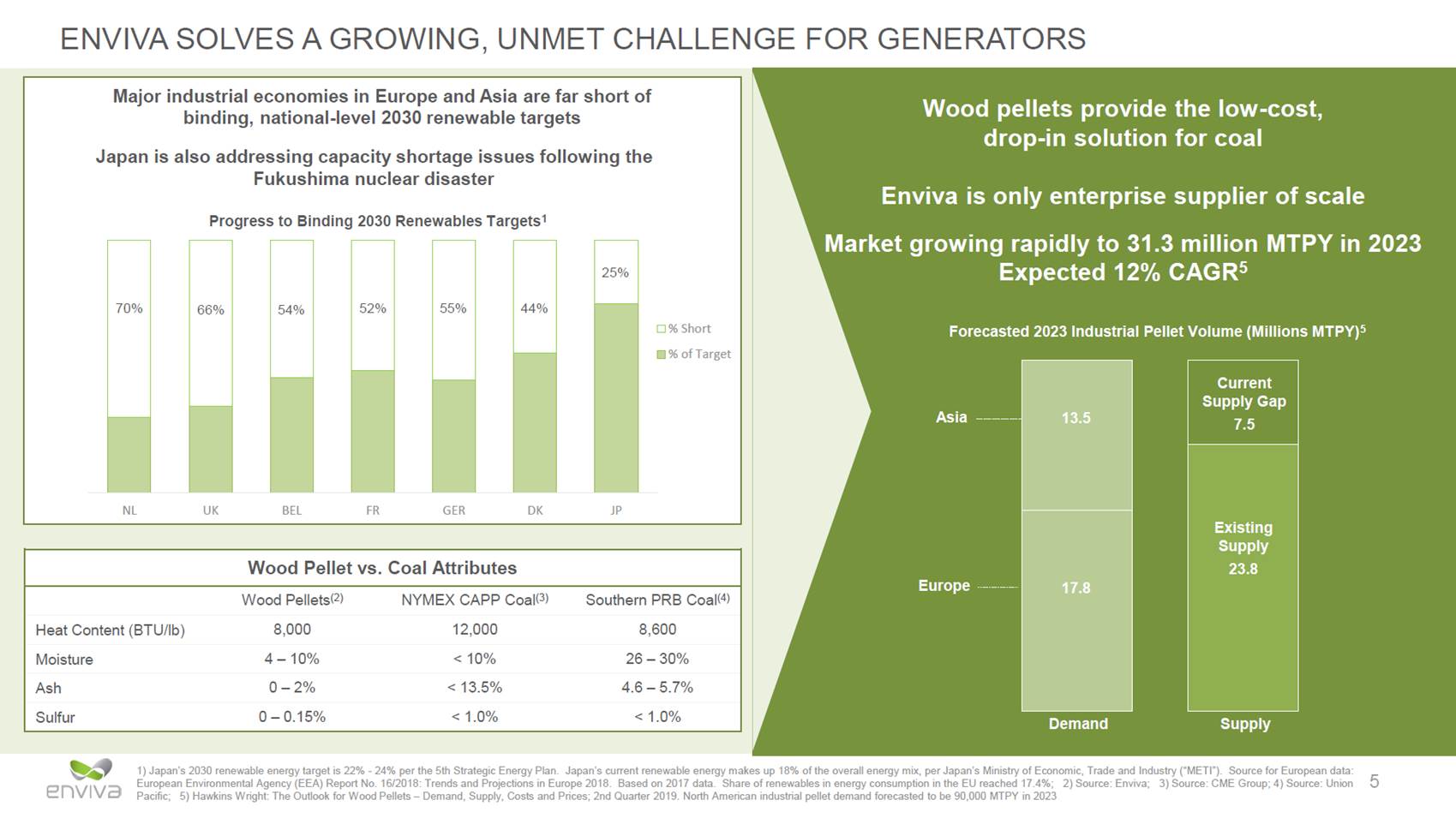
FAMILIAR MIDSTREAM ACTIVITIES Ørsted Rail Drying Processing ro Pipeline PBF Energy Fractionating 6 CONVENTIONAL RENEWABLE GATHERING GATHERING STORAGE STORAGE Enviva performs activities similar to midstream MLPs without direct exposure to crude oil or natural gas prices Qualifying income generated by aggregating a natural resource (timber), processing it into fuel, transporting pellets to deep-water marine storage terminals, and delivering ratably to utility customers UpstreamMidstreamDownstream Drax ENGIE Lynemouth Marubeni MGT ProcessingTruckMitsubishi DensifyingVesseltomo ta Tsusho Wood Fiber Truck WashingRailps 66 Vessel Coal, Gas, Oil RWE Sumi Toyo MPC Vale Philli
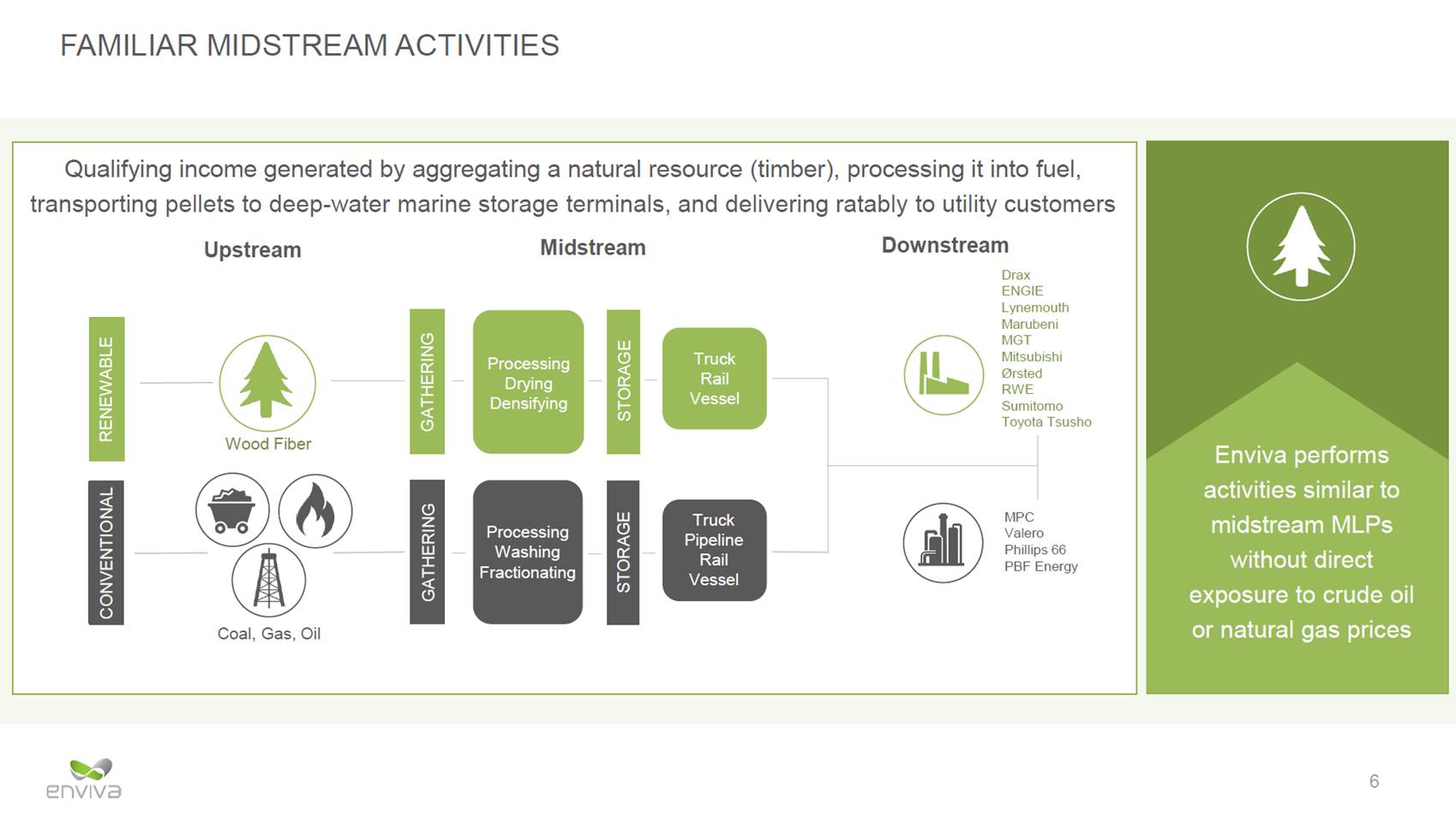
EVA TOTAL RETURNS1 1)As of July 31, 2019. Based on Bloomberg’s total return data, which assumes reinvestment of distributions/dividends. Normalized for comparison purposes 7 220 200101% 180 16058% 14042% 120 100 80 (24%) 60 EVAAlerian MLP IndexMSCI USA IMI ESGS&P 500 40 Apr-15Jul-15Oct-15 Jan-16 Apr-16Jul-16Oct-16 Jan-17 Apr-17Jul-17Oct-17 Jan-18 Apr-18Jul-18Oct-18 Jan-19 Apr-19Jul-19 Since IPO in 2015, EVA has outperformed the Alerian MLP Index by 125%
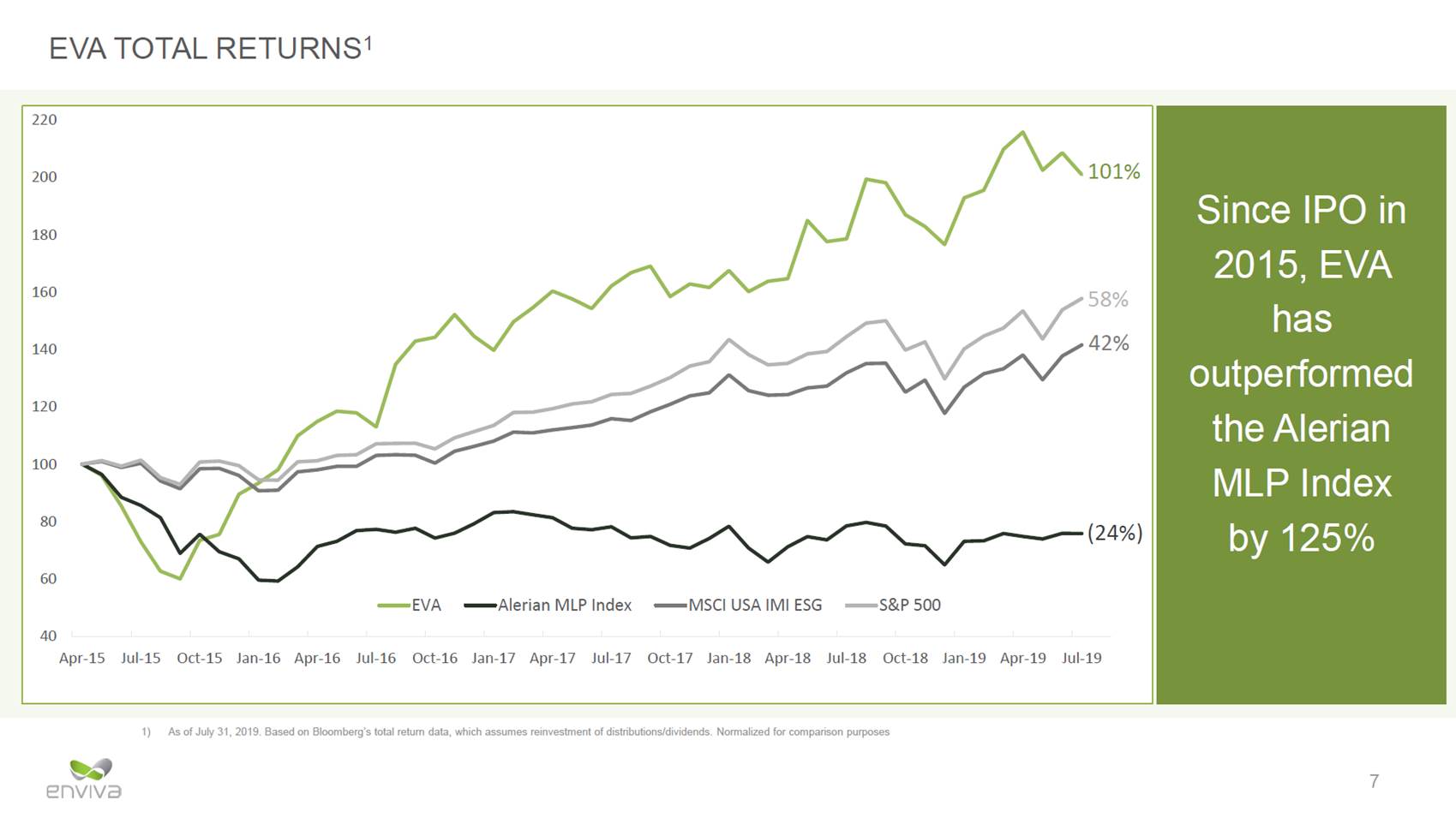
Enviva’s Port of Chesapeake Marine terminal Compelling Industry Fundamentals
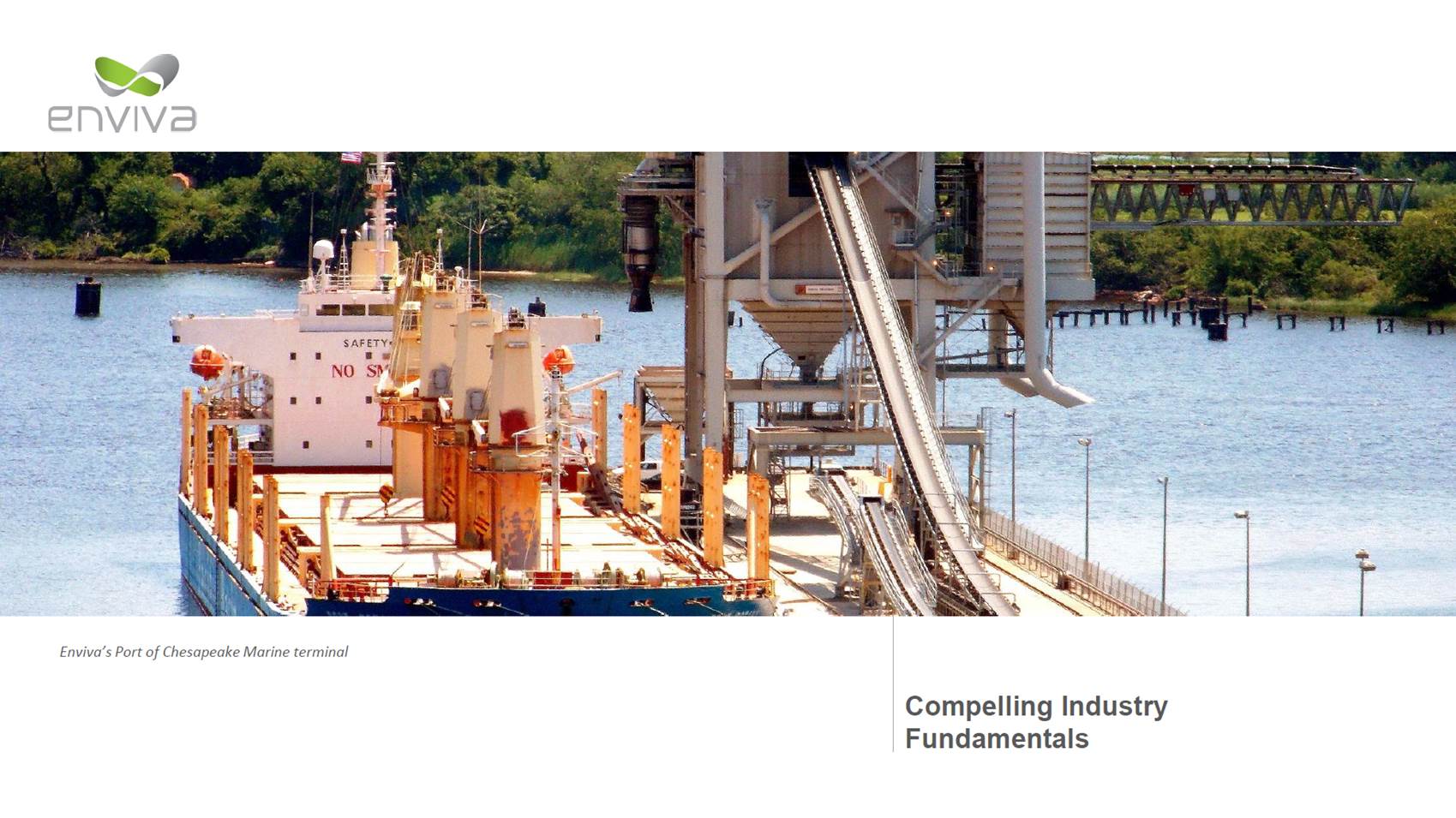
ECONOMIC ADVANTAGE AND REGULATORY STABILITY DRIVE ORDERLY GROWTH and grid stability as regulators continue to phase out coal-fired power generation systems are placed under strain competition among renewables, where biomass can prevail (“GHG”) emissions to net zero by 2050, which the UK government’s advisory Committee on Climate in Japan in 2020 (US$ / MWh)2 supplied from the Southeastern U.S. 1)Aurora Energy Research – Biomass conversions & the system cost of renewables (November 2016). Total System Cost of Electricity (TSCE) is the per-megawatt hour cost of building and operating a generating plant over an assumed financial life including intermittency, security of supply, balancing, grid expansion, and heat adjustment (applicable for CHP only). Data is for Germany and may not be representative of all the markets in which we or our customers operate. CHP is Combined Heat & Power. Expansion costs are related to the electricity grid only. New build CCGT could require gas grid expansions, the cost of which is not included here 2)IHS Markit: Levelized Cost of Power Generation in Japan, May 8, 2017. Costs are presented in real terms, as of 2020. In contrast to TSCE, Levelized Cost of Electricity (LCOE) does not include the intermittency costs associated with wind and solar power. LCOE for Dedicated Biomass assumes biomass wood-burning power plants with 112 MW of capacity and 40% efficiency 9 Levelized Cost of Electricity GT s Co-Firing $0$50$100$150$200$250 Solar Wind Dedicated Biomass CC Biomas Policy Characteristics for Enviva’s Target Markets 1Biomass energy providing a compelling solution to the “trilemma” of energy cost, decarbonization, 2Baseload / dispatchable characteristics of biomass power seen as a major advantage as electricity 3Policy-makers focused on improving financial discipline on a “total cost” basis, leading to more 4In June 2019, the UK became the first major economy to pass a law to bring greenhouse gas Change estimated would require that 15% of the energy mix come from biomass, up from approximately 7% today 5Asian market maturing towards long-term supply contract structure, and can be cost-competitively 6In Japan, most nuclear reactors remain offline, creating capacity constraints due to lack of baseload generation. World’s highest feed-in tariff incenting renewable power generation 7Biomass co-firing of U.S. coal fleet can extend plant lives, preserve jobs, and benefit rural economies Total System Cost of Electricity in Germany (€ / MWh)1 Solar Wind Biomass C 0 €50 €100 €150 € Onshore onversion CCGT Biomass Conversion with CHP
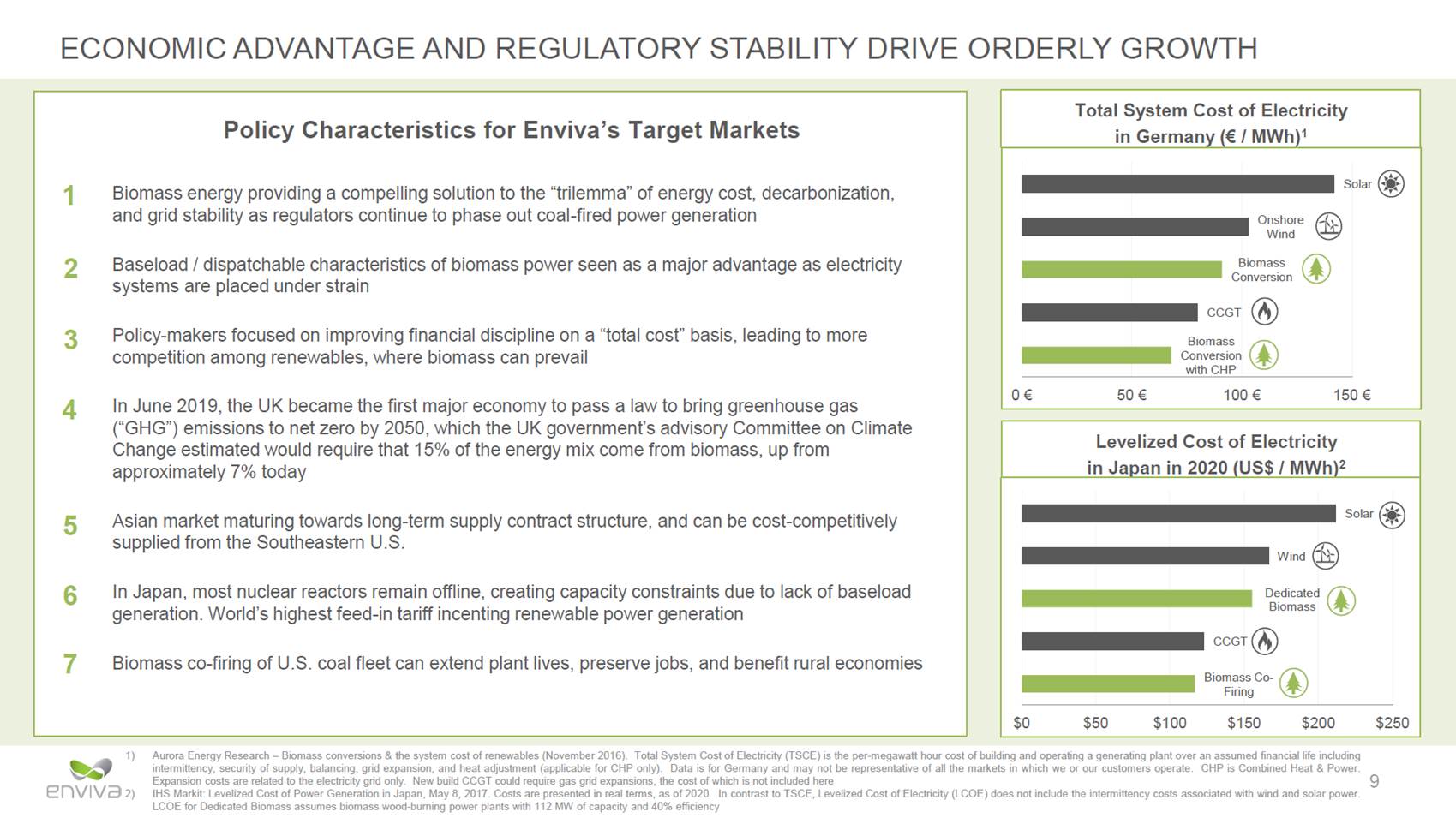
LIFECYCLE GREENHOUSE GAS EMISSIONS REDUCTION United Nations: “In fact, using biomass for electricity and heat, for example, co-firing of woody biomass with coal in the near term and large heating systems coupled with networks for district heating…are among the most cost-efficient and effective biomass applications for GHG emission reduction in modern pathways.”2 International Energy Agency: “Modern bioenergy plays an essential role in the International Energy Agency (IEA) 2C scenario, providing nearly 17% of final energy demand in 2060 compared to 4.5% in 2015.”3 European Union: “The reinforced EU sustainability criteria on bioenergy aim to continue guaranteeing the sustainability of forest biomass used in the energy sector.”4 U.S. EPA / USDA / DOE: “A stronger bioenergy market helps America achieve a variety of forest management and sustainability goals, including: reducing wildfire risks, improving forest health, increasing restoration, watershed improvements, creating new wildlife habitat, timber stand improvement, aesthetics, and more.”5 1) 2) 3) 4) 5) UK Environment Agency: Minimising greenhouse gas emissions from biomass energy generation (2009) IPCC, 2014: Climate Change 2014: Mitigation of Climate Change. Contribution of Working Group III to the Fifth Assessment Report of the Intergovernmental Panel on Climate Change International Energy Agency: Technology Roadmap – Delivering Sustainable Bioenergy European Commission: Proposal for a Directive of the European Parliament and of the Council on the promotion of the use of energy from renewable sources, June 21, 2018 EPA News Release: EPA Acting Administrator Wheeler, USDA Secretary Perdue, and DOE Secretary Perry Send Letter to Congress on Biomass Carbon Neutrality, November 1, 2018 10 Switching from coal to biomass reduces emissions of carbon dioxide by between 74% and 90% on a lifecycle basis1
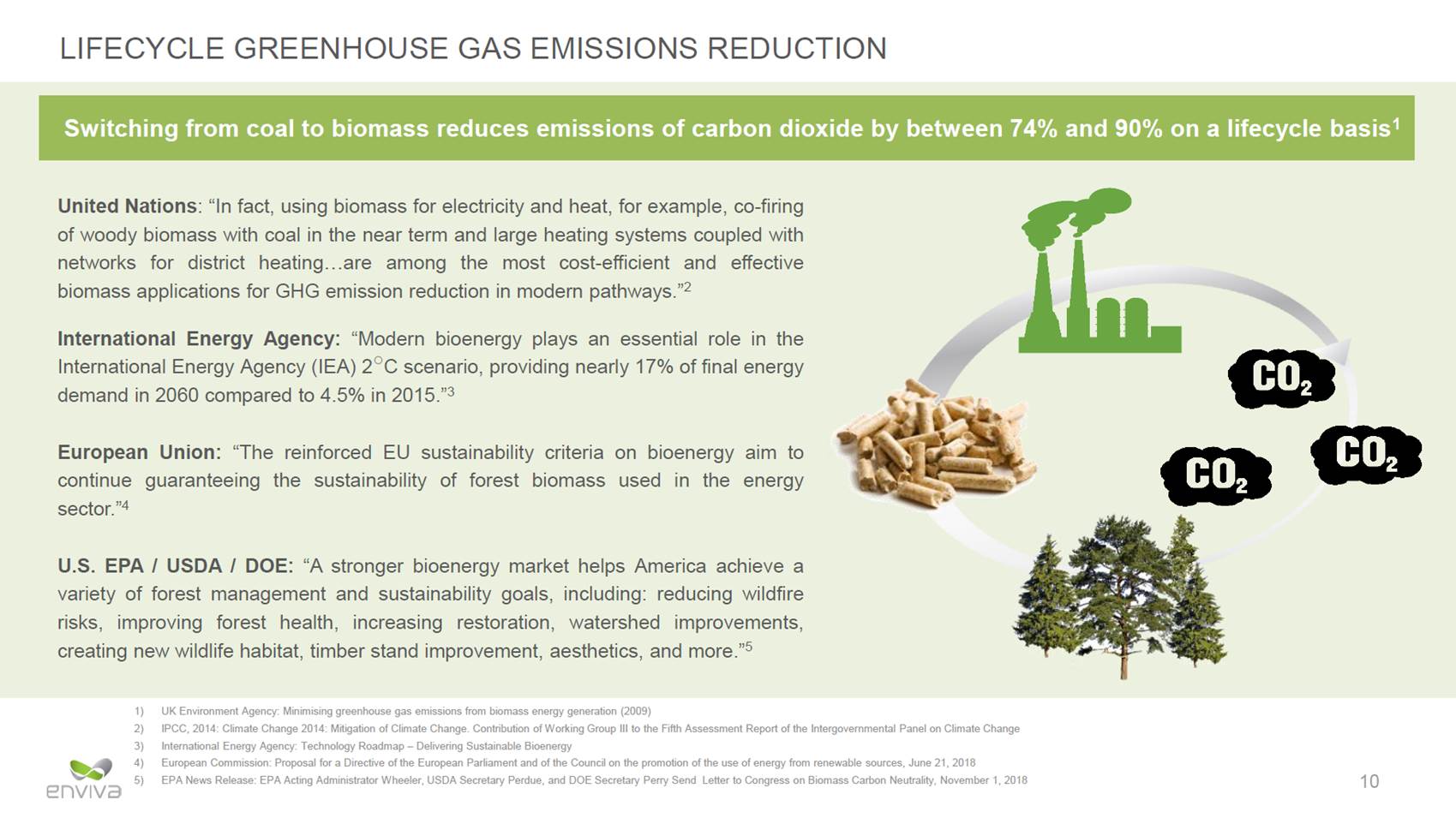
OUR ACTIVITIES SUSTAIN THRIVING, HEALTHY FORESTS Since Enviva opened its first U.S. mill in 2011 Between 2011 and 2018, forest inventory in our supply base increased by more than 270 million metric tons1 Pine/Hardwood and Other 38% 1) 2) 3) 4) 5) 2018 Forest2Market report of USFS FIA data in Enviva’s sourcing regions USDA - http://blogs.usda.gov/2015/06/08/study-finds-increasing-wood-pellet-demand-boosts-forest-growth-reduces-greenhouse-gas-emissions-creates-jobs/ 2015 The information in this panel is based on wood supplied to current Enviva facilities during the 3rd Quarter and the 4th Quarter of 2018 This wood consists of undersized or “understory” wood that was removed as part of a larger harvest; tops and limbs; brush and “thinnings” that were removed to make additional room for planted pines to grow We can identify the individual production facilities that provided these materials 11 “An industry that can reduce greenhouse gas emissions, increase forest growth, and create jobs sounds too good to be true. But that is the reality of the emerging wood pellet market in the Southern U.S.”2 -USDA Chief Economist Robert Johansson Certifications and Ongoing Audits by Independent Agencies: PEFC/29-31-238SFI-01203 Our Wood Came from These Sources:3 0.1% Arboricultural40% Mixed Forests4 2% Bottomland Hardwood Forests4 3% Upland Hardwood Forests4 17%Southern Yellow Sawdust &Pine Forests4 Industry Residues5 Our Track & Trace® Program, a first-of-its-kind system, is an important element of our responsible wood supply program and provides unprecedented transparency into our procurement activities

SUPPLY GAP CREATED BY MULTIPLE HURDLES TO ENTRY Limited Supply Chain Infrastructure with reputable Fragmented Natural Resource Base term margin stability and Deep Process Capabilities Required Wood Aggregation Truck / Rail Loading Debarking & Chipping Size Reduction Wood Receiving & Storage Shipping Port Storage Drying Pelleting Commitment to Excellence in Safety, Sustainability & Reliability 12 Long-term, fixed-price shipping contracts logistics providers Off-take contract pricing escalators enable long-mitigate exposure to uncontrollable changes to cost position Plants strategically located in one of the most attractive wood fiber regions in the world Proximity to terminals results in low “to-port” transportation costs Cost-effective transportation due to ownership and/or control of ports
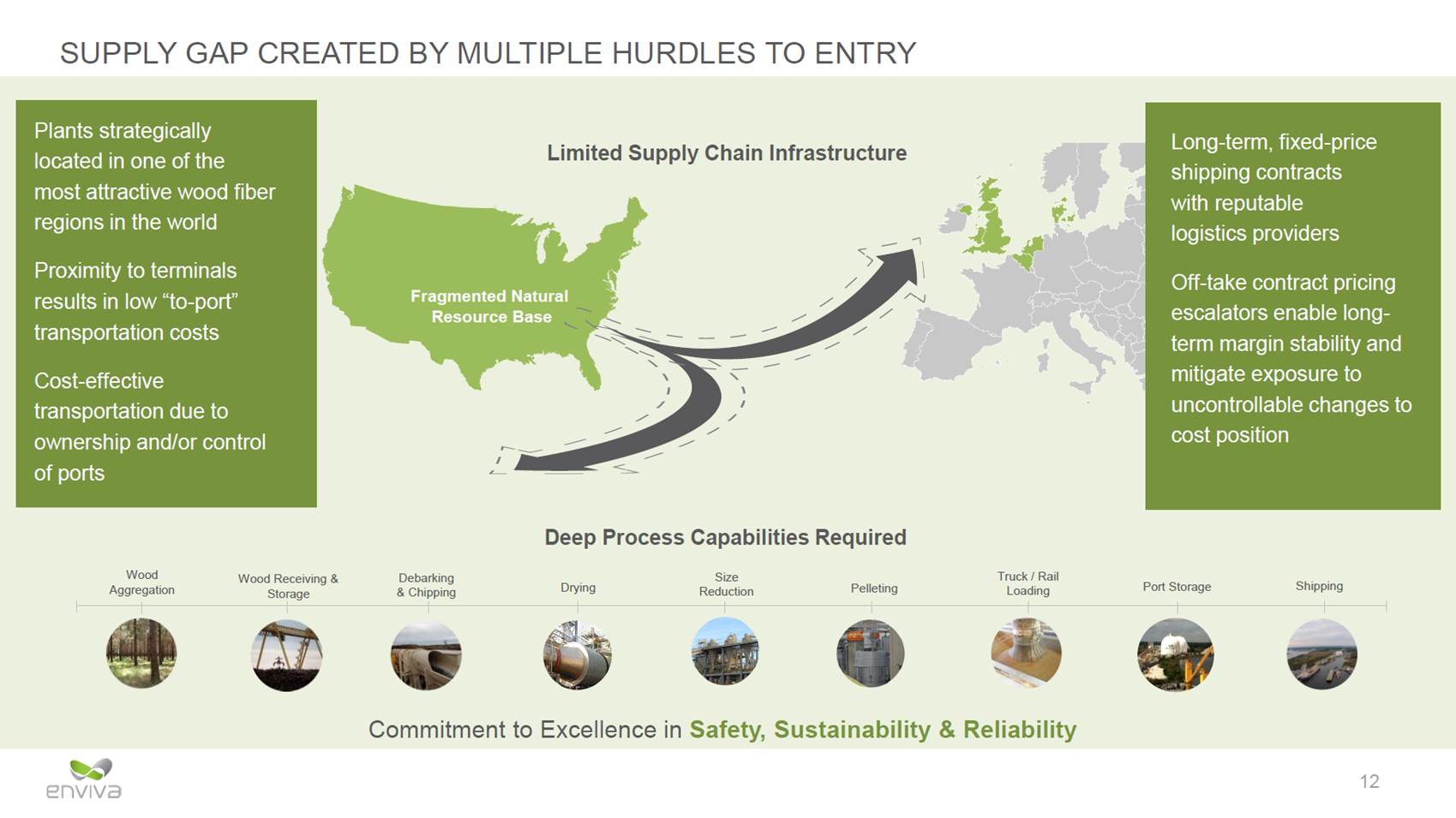
DURABLE COMPETITIVE ADVANTAGE Plants1 Enviva VERTICALLY-INTEGRATED source supplier for our customers 1)Enviva’s total production capacity and number of plants are based on nameplate capacities of existing operating plants, planned capacity expansions at Southampton and Northampton plants and the estimated capacity of the Greenwood plant, which is owned by the Second JV. We expect to have the opportunity to acquire assets or completed development projects from our Sponsor or the Second JV in the future. Production capacity and number of plants for other pellet producers are based on Hawkins Wright: The Outlook for Wood Pellets – Demand, Supply, Costs and Prices; 2nd Quarter 2019 2)Although the Greenwood plant is included in the category of “under development/construction,” it is currently operational 13 Production Capacity1 (Thousand MTPY)05001,0001,5002,0002,5003,0003,5004,0004,500# ofLocation 8U.S. GLOBAL ENTERPRISE SUPPLIERSGraanul Invest Pinnacle Renewable Energy 13Baltics 9Canada 3U.S. 1U.S. 1Vietnam 3U.S. As the world’s largest supplier of industrial1U.S. wood pellets, Enviva is frequently the sole-3Canada 1Brazil Current CapacityUnder development/construction or financed for completion by 20202 An Viet Phat FRAM Renewable Fuels SMALL & REGIONAL SUPPLIERSHighland Pellets Pacific Bioenergy Tanac SA Drax Biomass SUPPLIERSGeorgia Biomass (RWE) Enviva is the world’s largest publicly traded global enterprise supplier in a highly fragmented industry with numerous small, single-plant operators A “build and copy” approach allows for highly efficient, large-scale production facilities and creates operating leverage Multi-plant profile and global scale translate into superior reliability and opportunities for optimization Access to robust fiber baskets allows for reliable raw material supply and a flat marginal cost curve for incremental production
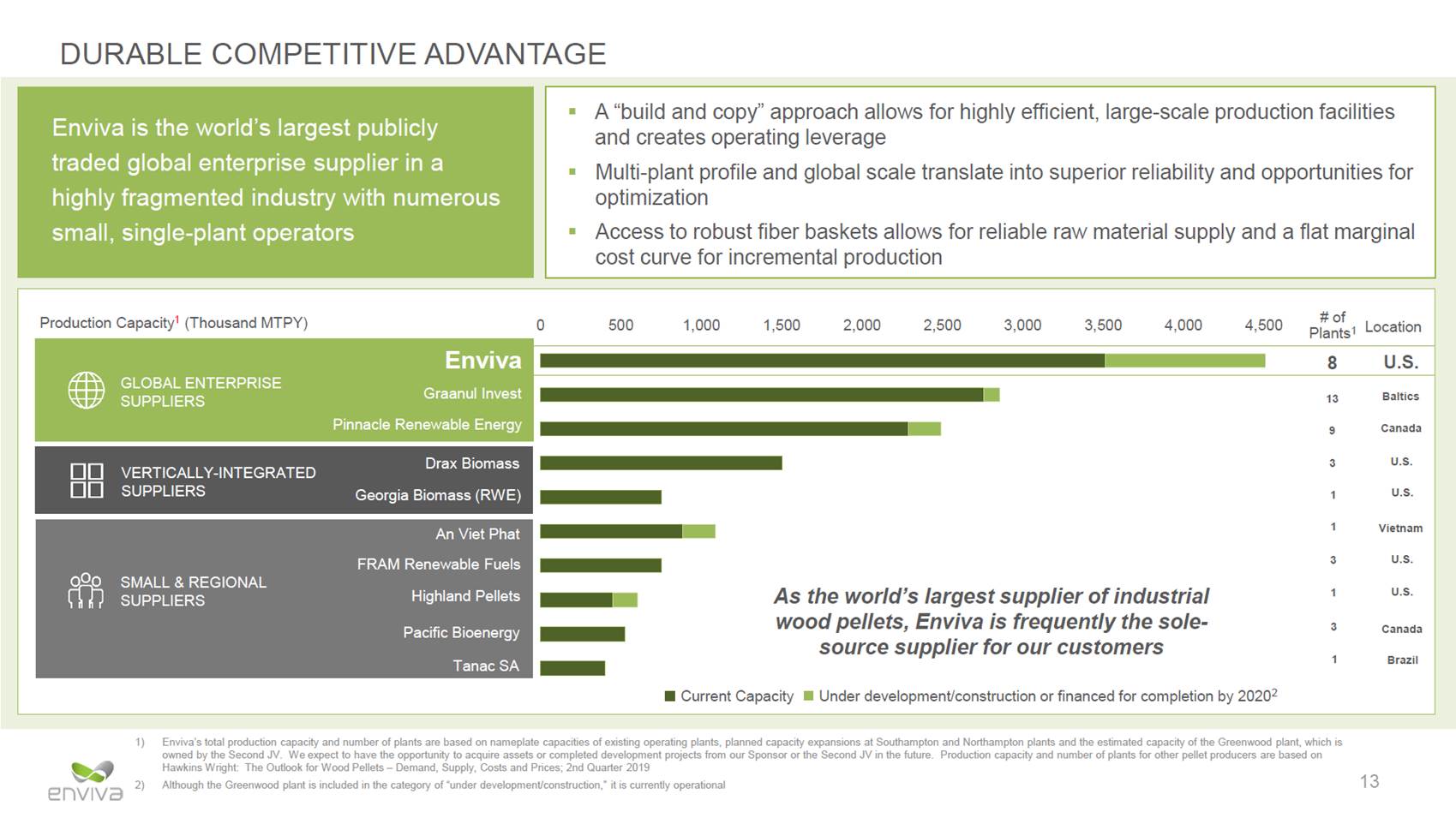
Enviva’s Production Facility in Northampton, NC Advantaged Assets
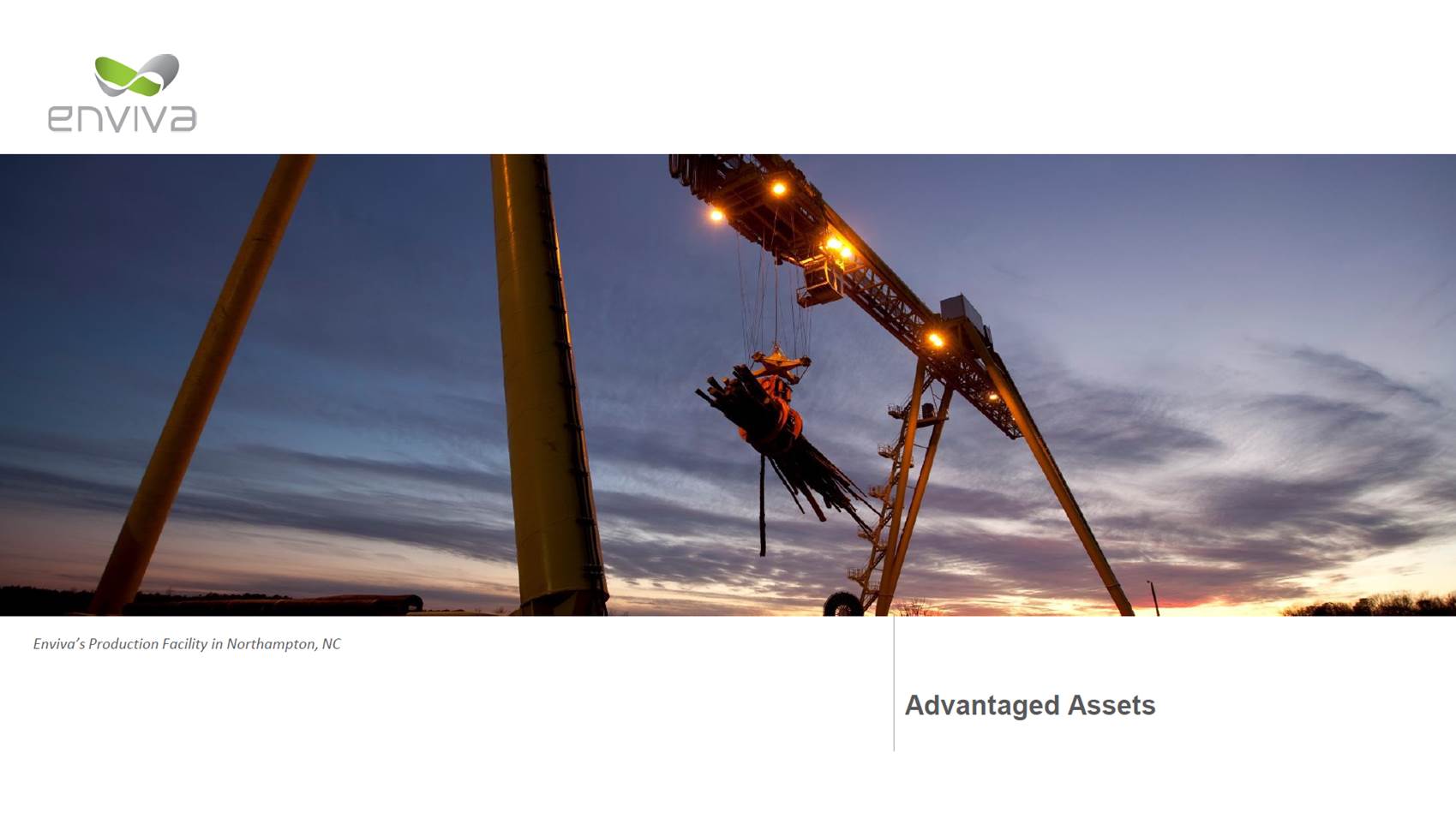
ENVIVA PARTNERS, LP: PRODUCTION PLANTS AND TERMINAL ASSETS metric tons of capacity Startup: November 2011 tons of capacity metric tons of capacity by Enviva Plants Ports 1)Does not include production capacity expansions announced as part of our earnings release as of November 8, 2018 2)The Hamlet plant is now operating, and the Partnership expects the plant to exit 2019 with a production run-rate of approximately 500,000 MTPY and to reach its nameplate production capacity of approximately 600,000 MTPY in 2021 15 Port of Panama City, FL Port of Mobile, AL Cottondale, FL Port of Wilmington, NC Sampson, NC Hamlet, NC Amory, MS Port of Chesapeake, VA Ahoskie, NC Port of Mobile Location: Mobile, AL Startup: 3rd Party Agreement Storage: Flex barge storage with 45K+ Port of Chesapeake Location: Chesapeake, VA, wholly-owned by Enviva Storage: Dome storage with 90K metric Port of Panama City Location: Panama City, FL Startup: 3rd Party Agreement Storage: Warehouse storage with 32K Port of Wilmington Location: Wilmington, NC, wholly-owned Startup: 2016 Storage: Dome storage with 90K metric tons of capacity Amory Location: Amory, MS Startup: August 2010 (acquired) Annual Production: 120K MTPY Ahoskie Location: Ahoskie, NC Startup: November 2011 Annual Production: 415K MTPY Sampson Location: Sampson, NC Startup: November 2016 Annual Production: 555K MTPY, expected to increase to 600K MTPY in 2019 Cottondale Location: Cottondale, FL Startup: May 2008 (acquired) Annual Production: 730K MTPY Northampton1 Location: Northampton, NC Startup: April 2013 Annual Production: 550K MTPY Southampton1 Location: Southampton, VA Startup: October 2013 Annual Production: 545K MTPY Hamlet2 Location: Hamlet, NC Startup: June 2019 Annual Production: 600K MTPY Northampton, NC Southampton, VA Storage and Terminaling Assets Production Plants – 3.5 million MTPY
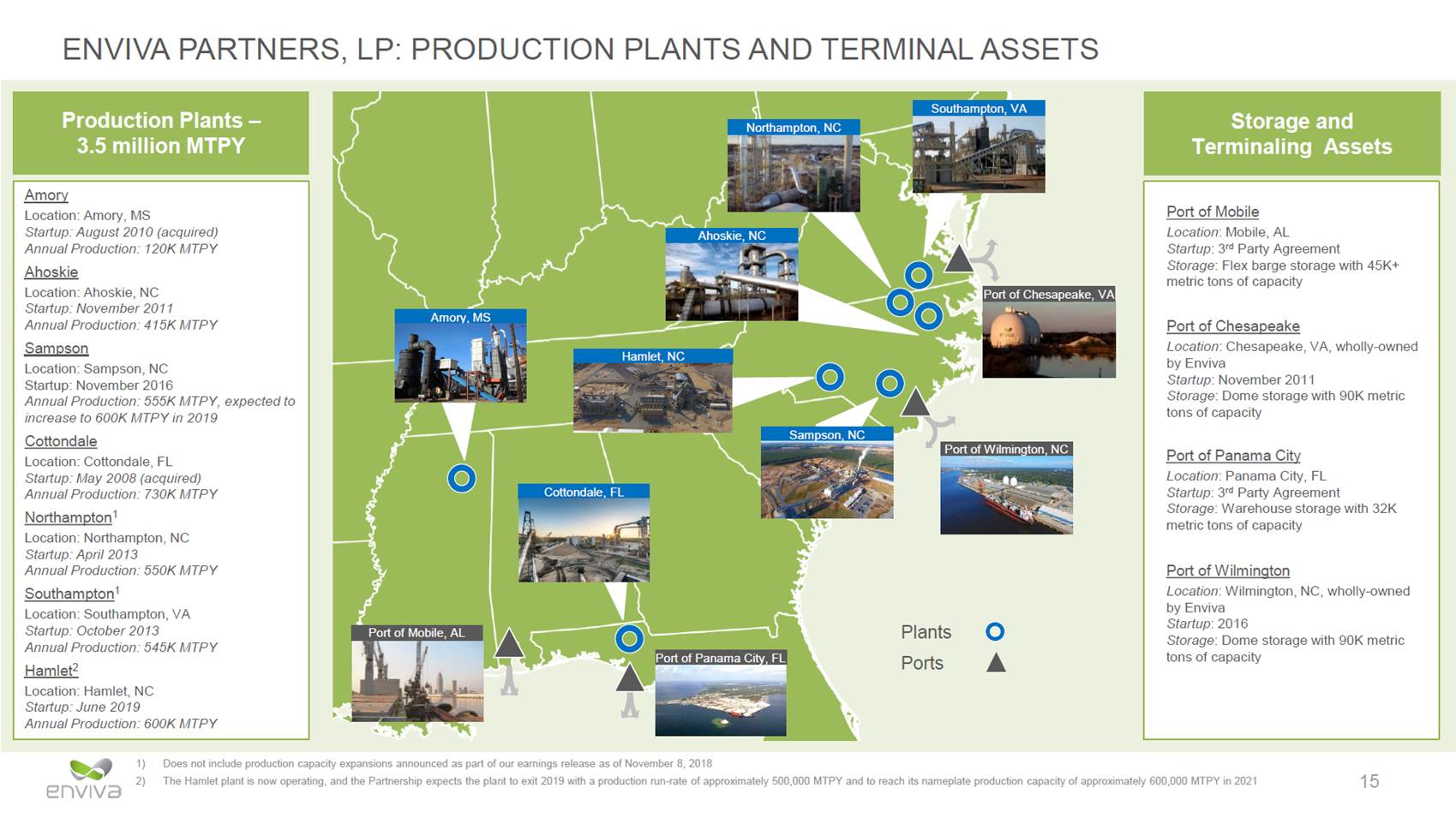
NEGATIVE DEPLETION RESOURCE PLAY 1) FIA Data (EVALIDator; 2017) In the last year where state forest inventory data is available, total wood fiber within the fiber sourcing area for the Partnership’s Northampton plant grew by approximately 29.6 million tons and total harvest removals were approximately 15.2 million tons, resulting in 14.4 million tons of excess fiber FIA Data, from 2000 through 2016, in Virginia, North Carolina, Mississippi and Florida, the four primary areas Enviva sources its wood fiber, total wood fiber volume grew by approximately 39.1 billion cubic feet and total wood fiber drain was approximately 29.2 billion cubic feet. As the result, net fiber volume grew by approximately 9.9 billion cubic feet, a net increase of 24% from 2000 U.S. Crude Oil and Natural Gas Proved Reserve, Year-end 2017, U.S. Energy Information Administration. As of 12/31/2017, proved oil and natural gas reserves of the U.S. were approximately 122.0 billion barrels of oil equivalent with approximately 16.6 billion barrels of oil equivalents in the Permian Basin 2) 16 3) Wood Fiber (in billion cubic feet) Advantaged Resource Availability ’00 ’01 ’02 ’03 ’04 ’05 ’06 ’07 ’08 ’09 ’10 ’11 ’12 ’13 ’14 ’15 ‘16 Annual FiberAnnual Fiber GrowthDrain Wood fiber analog to conventional oil and gas would be adding the proved reserves of nearly two additional Permian Basins in the U.S.3 24% net growth in volume of wood fiber in Enviva’s procurement areas2 Robust Resource with Fragmented Supplier Base Hardwood RoundwoodPine RoundwoodOpen / Farmland 65,000+ private landowners14 million+ tons net annual fiber excess1 860 million+ tons of fiber1 million tons annual facility demand Northampton 75 mi.

REGIONS1 NET FIBER GROWTH ACROSS ALL ENVIVA’S SOURCING CHESAPEAKE SOURCING REGION 1)FIA Data 17 Million MT of Wood Inventory Million MT of Wood Inventory Million MT of Wood Inventory Million MT of Wood Inventory 640WILMINGTON 620 600 580 56015% 540 2010 2011 2012 2013 2014 2015 2016 2017 2018 590GULF SOURCING REGION 570 550 530 14% 510 2010 2011 2012 2013 2014 2015 2016 2017 2018 1,050 1,000SOURCING REGION 950 900 85020% 800 2010 2011 2012 2013 2014 2015 2016 2017 2018 420GREENWOOD SOURCING REGION 410 400 390 9% 380 2010 2011 2012 2013 2014 2015 2016 2017 2018
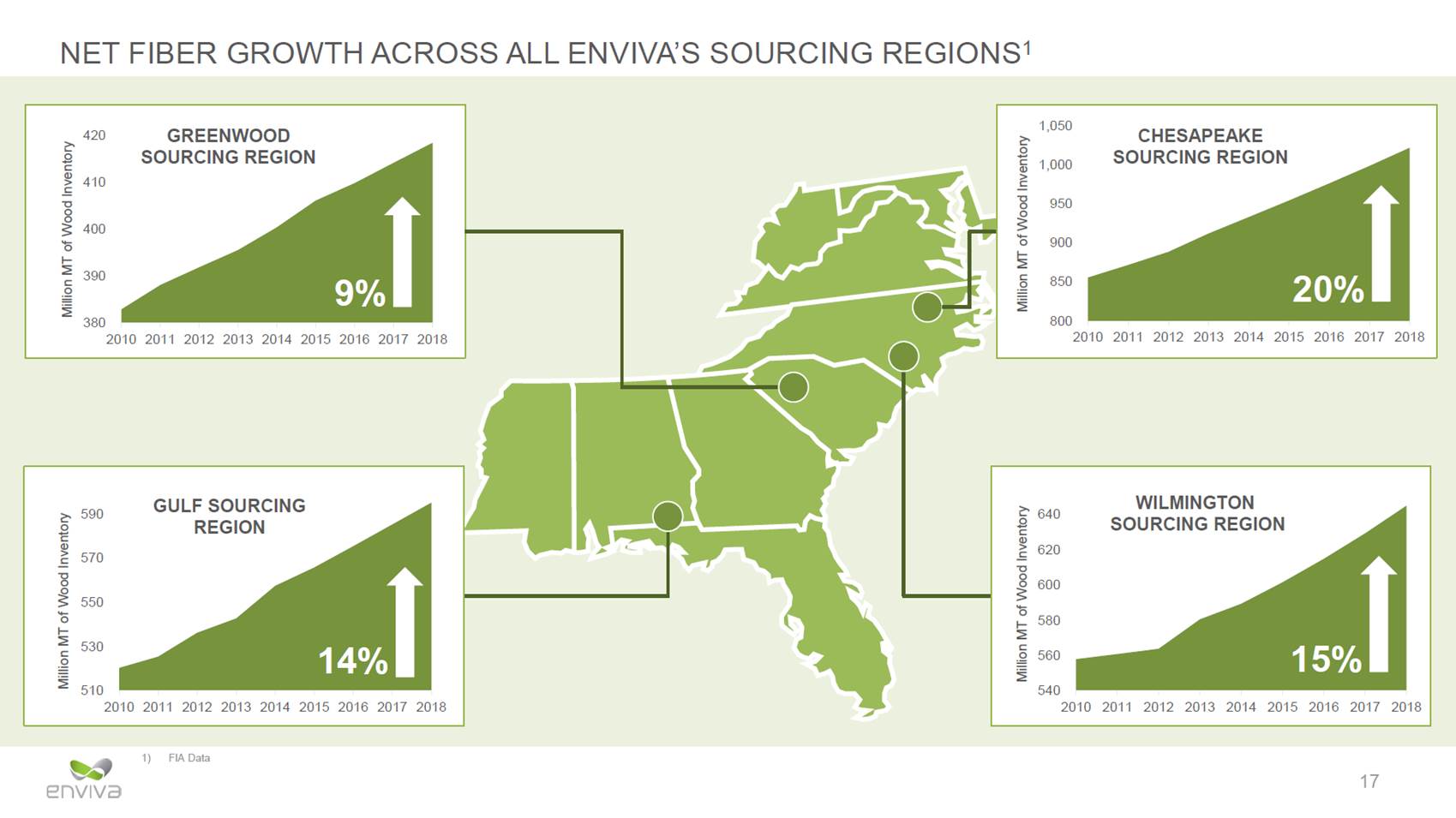
Barge-to-Ship Loading at Enviva’s Operations in Mobile, AL Contracted Position & Risk Mitigation

BUSINESS MODEL MITIGATES RISK Off-take Contracts1 Long-term, take-or-pay, price determinant with make-whole and market-based damages Predominantly U.S. Dollar denominated Cost pass-throughs and escalators protect against inflation, cost of fiber, and fuel costs Provisions to protect against changes in laws, import duties, and taxes Operations & Fiber Geographically dispersed fleet of production plants located in strong fiber baskets Strategically located portfolio of ports providing optimal to-port logistics “Build and copy” approach facilitates common processes and operational knowledge DURABLE CASH FLOWS Markets & Financials Conservative balance sheet and financial policy No direct exposure to crude oil or natural gas prices Insurance program tailored for operations and scale of business Currency hedges in place to mitigate foreign currency risk $350 million expanded revolver provides significant financial flexibility Shipping Long-term, fixed-rate shipping contracts matching off-take tenor and volume Multiple shipping partners Cost of bunker fuel passed through to customer 1) Note: off-take contract terms are examples of various provisions within our portfolio of contracts; no single contract in our portfolio contains every provision listed above 19
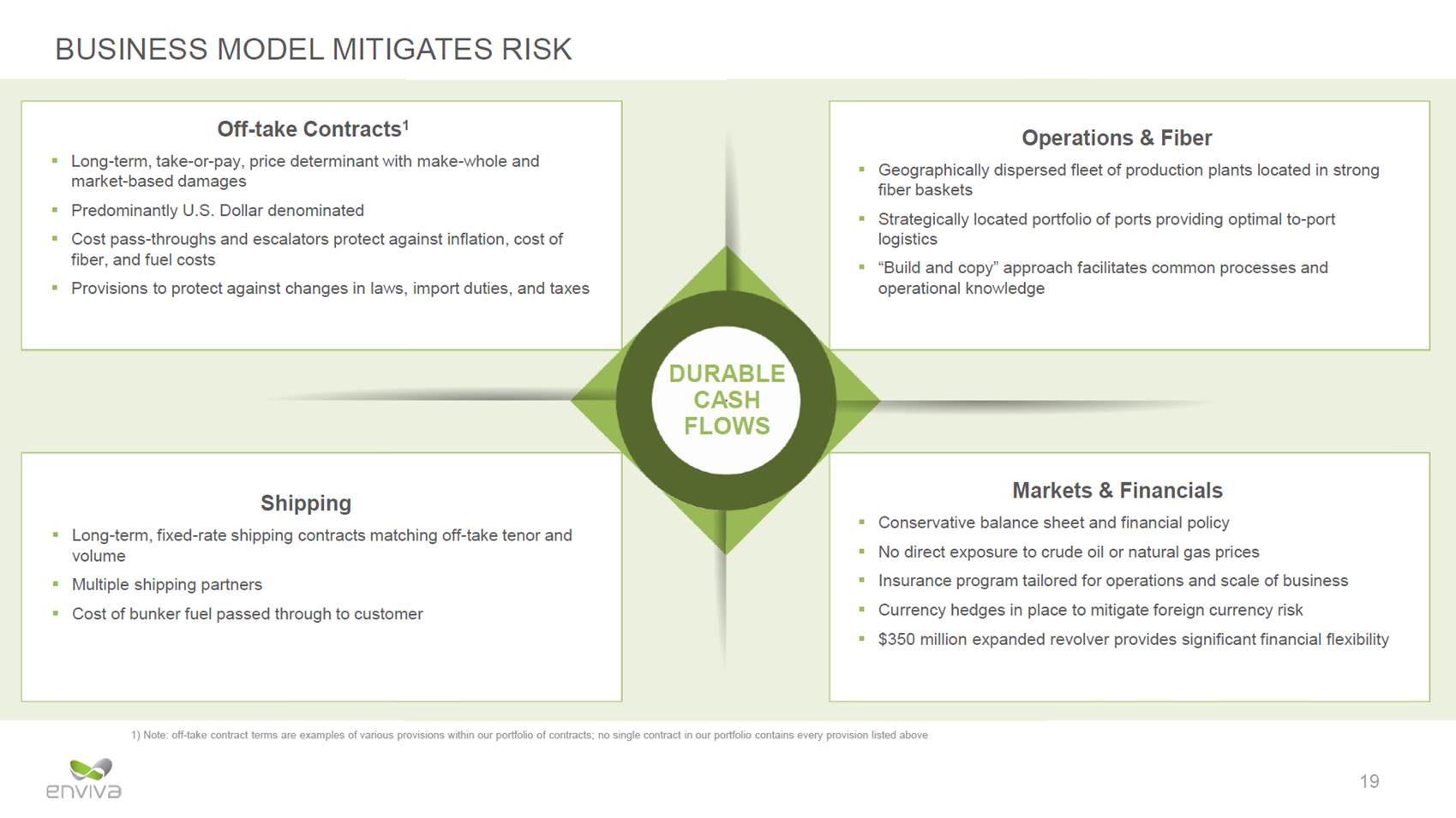
FULLY CONTRACTED PRODUCTION PROFILE EVA Production Firm Off-Take Contracts4 1) 2) As of August 5, 2019, excluding contracts between our long-term off-take customers and our Sponsor and the Second JV Does not take into account other opportunities the Partnership expects to have to increase production capacity, except planned production capacity expansions totaling 400,000 MTPY at the Partnership’s Southampton and Northampton plants, subject to receiving the necessary permits, as announced as part of our earnings release as of November 8, 2018 Represents the estimated volumes the Partnership is expected to purchase from the Second JV under the off-take contract for the Greenwood plant’s production and volumes sourced from third parties under existing agreements Contracted volumes in the graph above include only contracts of Enviva Partners, LP or its subsidiaries and do not include volumes under our Sponsor and the Second JV’s contracts 3) 4) 20 Sales strategy is to fully contract our production capacity under long-term agreements $9.6 Billion Contracted revenue backlog1 10.4 Years Partnership’s weighted-average remaining term of off-take contracts1 Fully contracted through 2025 Thousand MTPY 2 EVA Purchases3 6,000 5,000 4,000 3,000 2,000 1,000 0 20192020202120222023
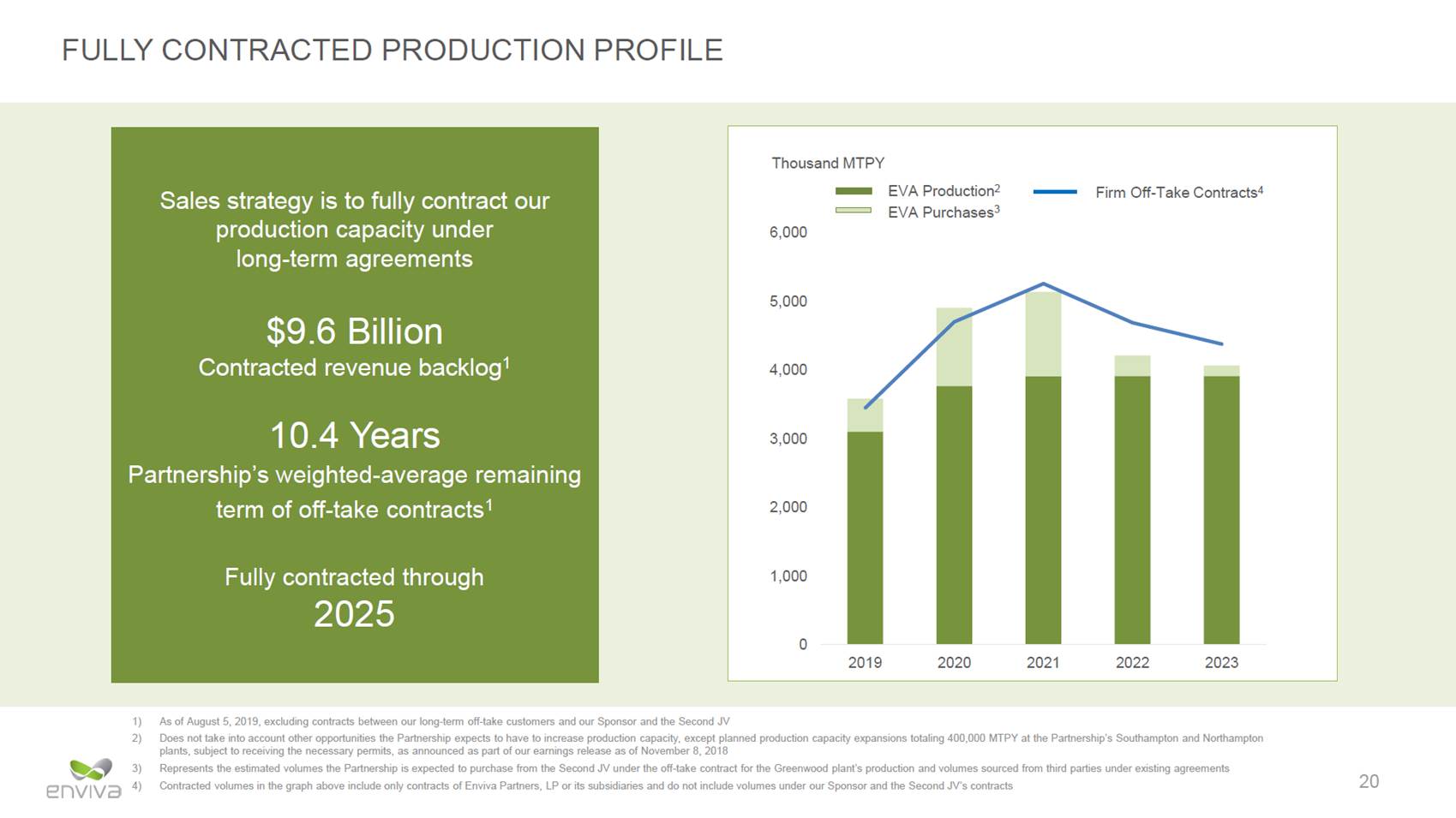
INCREASINGLY DIVERSE CUSTOMER BASE Mitsubishi Lynemouth Engie Orsted 1)Includes base volume only 2)As of August 5, 2019. Includes all volumes under the firm and contingent off-take contracts held by the Partnership, our Sponsor and the Second JV. The Partnership expects to have the opportunity to acquire these contracts from our Sponsor and the Second JV 21 2018 Off-Take Contract Mix1 2025 Off-Take Contract Mix2 Other Creditworthy Japanese Customers OrstedDrax Toyota Tsusho Marubeni Drax Lynemouth MGT Engie Sumitomo ~3.0 million MTPY1 ~6.5 million MTPY2 ~ 47% from Japanese Customers by 2025 13.2 Years2 weighted-average remaining term $17.9 Billion2 contracted revenue backlog
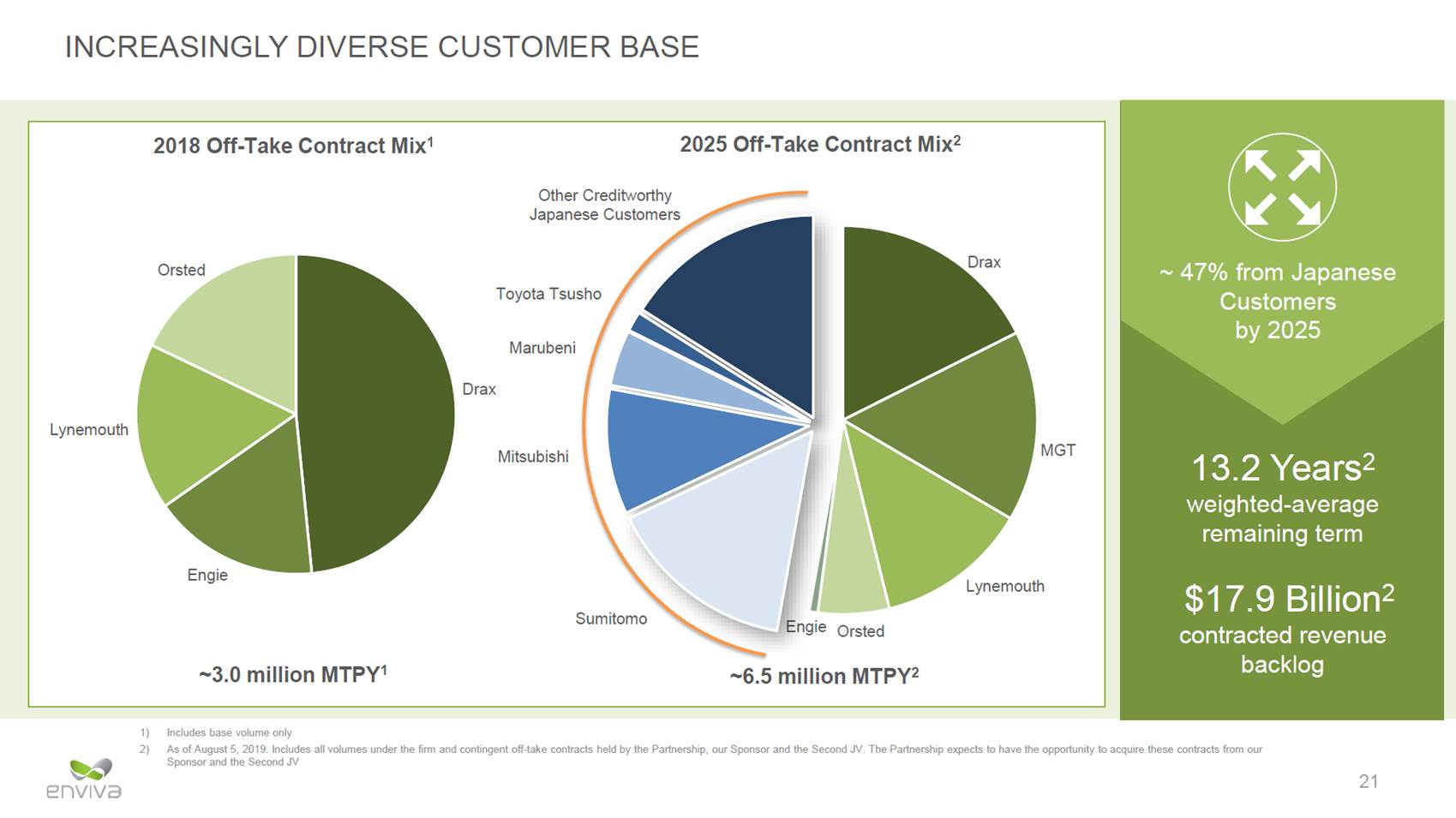
CONTRACT AND MARKET UPDATE – EUROPE The Renewable Energy Directive II (RED II) was finalized in December 2018. The directive dictates that, by 2030, the share of energy from renewable sources must account for at least 32 percent of the European Union’s gross consumption. Furthermore, the European Commission is required to re-evaluate and potentially increase the 32 percent target by 2023. European Union (“EU”) Member States now have until June 2020 to adopt it into national law through integrated National Energy and Climate Plans. The resulting national policies are expected to provide further impetus for new biomass demand across the EU. The newly elected President of the EU Commission has announced the goal to make Europe the first climate-neutral continent by 2050. To make this happen, she has committed to propose, in her first 100 days in office, a European Green Deal, which is expected to include the first European Climate Law that will set the 2050 climate-neutrality target into legislation. This enhanced EU climate goal could lead to increased carbon pricing over time and improve the competitive position of biomass, especially in countries such as Germany, where coal continues to form a significant portion of the electricity and heat generation mix. Pursuant to its final report published in late January 2019, Germany’s Commission on Growth, Structural Economic Change and Employment, (“Coal Commission”), established the goal of decommissioning 12.5 gigawatts (“GWs”) of coal-fired power generation capacity by 2022 and more than 25.0 GWs by 2030. Germany’s Federal Minister for Economic Affairs and Energy expects the law adopting the Coal Commission’s goal to come into force by early 2020. The law is expected to provide specific dates for the shut-down of coal-and lignite-fired power plants. In June 2019, the UK became the first major economy in the world to pass a law to bring GHG emissions to net zero by 2050, compared with its previous target of at least an 80 percent reduction from 1990 levels. The government’s advisory Committee on Climate Change estimated that, in order for the country to achieve the net zero emissions target, 15 percent of the UK energy mix would need to come from biomass, up from approximately 7 percent today. In June 2019, Poland’s government published the draft amendment to its Renewable Energy Sources Act as the government seeks to accelerate renewable energy development to avoid the cost of missing the renewable energy targets set by the EU’s Renewable Energy directives. During the first quarter of 2019, over 100 megawatts of new biomass generation capacity was launched in Poland, bringing total biomass capacity in the country to more than 1.4 gigawatts. 22 European industrial wood pellet demand continues to grow
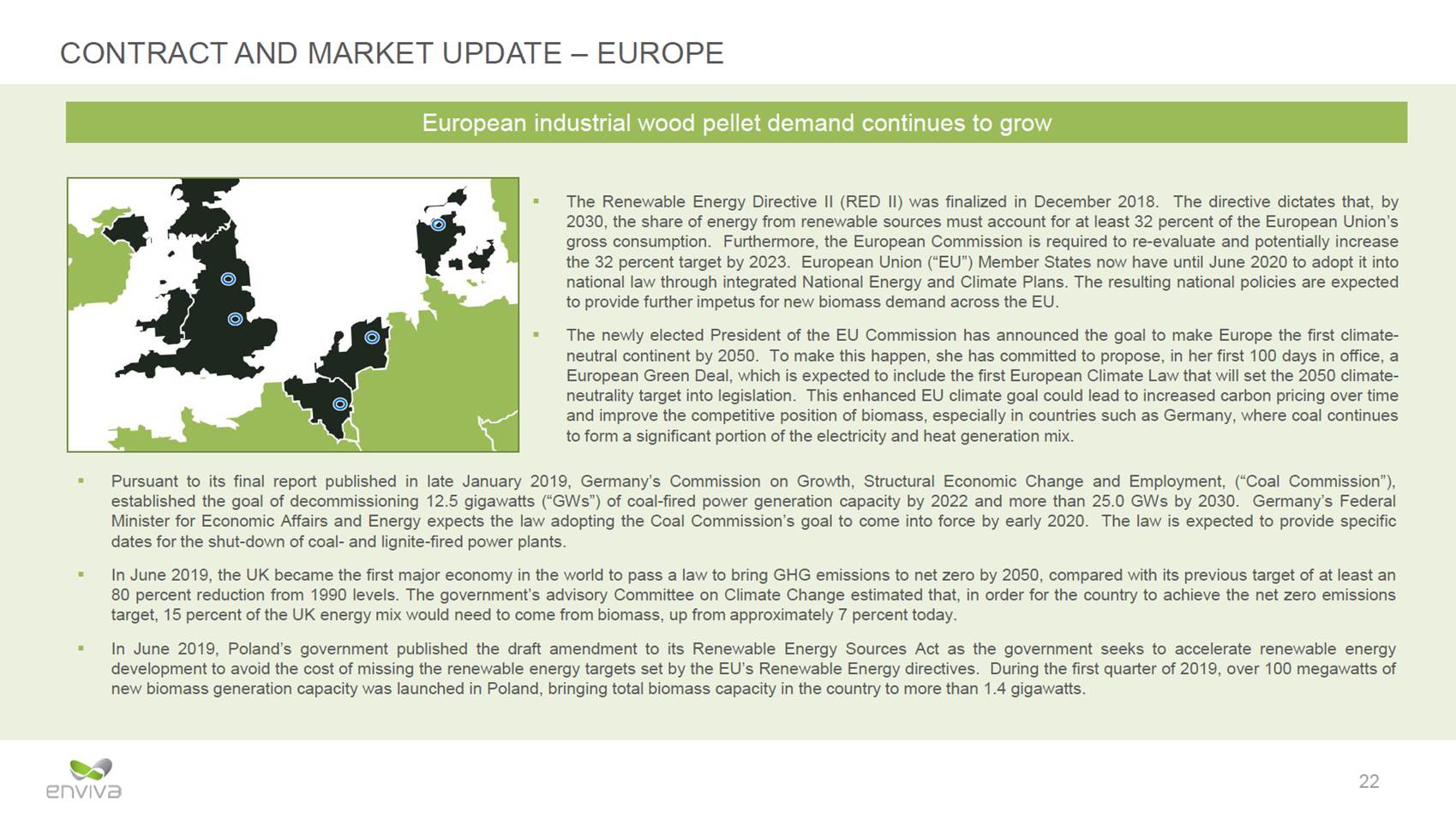
CONTRACT AND MARKET UPDATE – ASIA AND REST OF WORLD On December 12, 2018, Japan’s METI announced that, as of June 2018, Japan’s operating biomass power generation capacity under its FiT scheme reached approximately 2.4 GWs. Coupled with additional FiT-approved biomass power generation capacity of 8.6 GWs, total biomass generation capacity under the FiT scheme is now 11.0 GWs. Although some approved capacity may be cancelled if developers fail to meet certain project development milestone requirements, the approved capacity is significantly above the country’s target of 6.0 to 7.5 GWs of biomass power by 2030. For reference, it would take at least 25.0 to 30.0 million metric tons of wood pellets annually to generate 10.0 GWs of biomass power. The Japanese government approved the country’s fifth Strategic Energy Plan prepared by METI. In addition to confirming renewable energy’s target share of 22 to 24 percent in Japan’s 2030 energy mix, the plan designated renewables, including biomass, as a main source of power generation, indicating a major shift in government policy that recognizes renewable energy’s role as a baseload power source. As of August 5, 2019, the Partnership and our Sponsor have now entered into firm and contingent long-term off-take contracts totaling over 3 million MTPY with major Japanese trading houses and power generators. These include a 15-year, 180,000 MTPY contract between Mitsubishi Corporation and the Partnership, a 15-year, 450,000 MTPY contract between Mitsubishi Corporation and our Sponsor, three 15-18 year contracts totaling 960,000 MTPY between Sumitomo Corporation and our Sponsor, a 10-year, 100,000 MTPY contract between Marubeni Corporation and the Partnership, a 15-year, 180,000 MTPY contract between Marubeni Corporation and the Partnership, a 17-year contract between the Partnership and Toyota Tsusho Corporation with initial volumes of 100,000 MTPY for the first five years, increasing to 175,000 MTPY, and four 10-20 year contracts between major Japanese trading houses and power generators and our Sponsor totaling 1,010,000 MTPY.2 All contracts are expected to commence between 2021 and 2024. The South Korean government adopted its Third Basic Energy plan in June 2019, which called for increase in the share of renewable power generation to 30 to 35 percent by 2040, up from its previous goal of 20 percent by 2030. The government also confirmed its policy to no longer approve coal-fired or nuclear power plants or grant extensions of nuclear reactor licenses, which implies the ultimate phase-out of the country’s two largest existing energy sources. The Partnership executed a firm 2-year take-or-pay off-take contract with Albioma Le Moule (“Albioma”), a leading renewable energy generator in Guadeloupe, to supply a power plant currently being converted from coal-fired to biomass-fired, which Albioma reports will increase the share of renewable energy on the island from 20 percent to 35 percent. Deliveries under the contract are expected to commence in 2020 with volumes of 130,000 MTPY of wood pellets. 1)Hawkins Wright: The Outlook for Wood Pellets – Demand, Supply, Costs and Prices; 2nd Quarter 2019. Worldwide demand for industrial pellets is expected to reach approximately 33 million MTPY by 2028 2)Subject to certain conditions precedent, which the Sponsor expects to be met during the second half of 2019 and first half of 2020 23 By 2026, emerging demand in Asia expected to double worldwide market size1
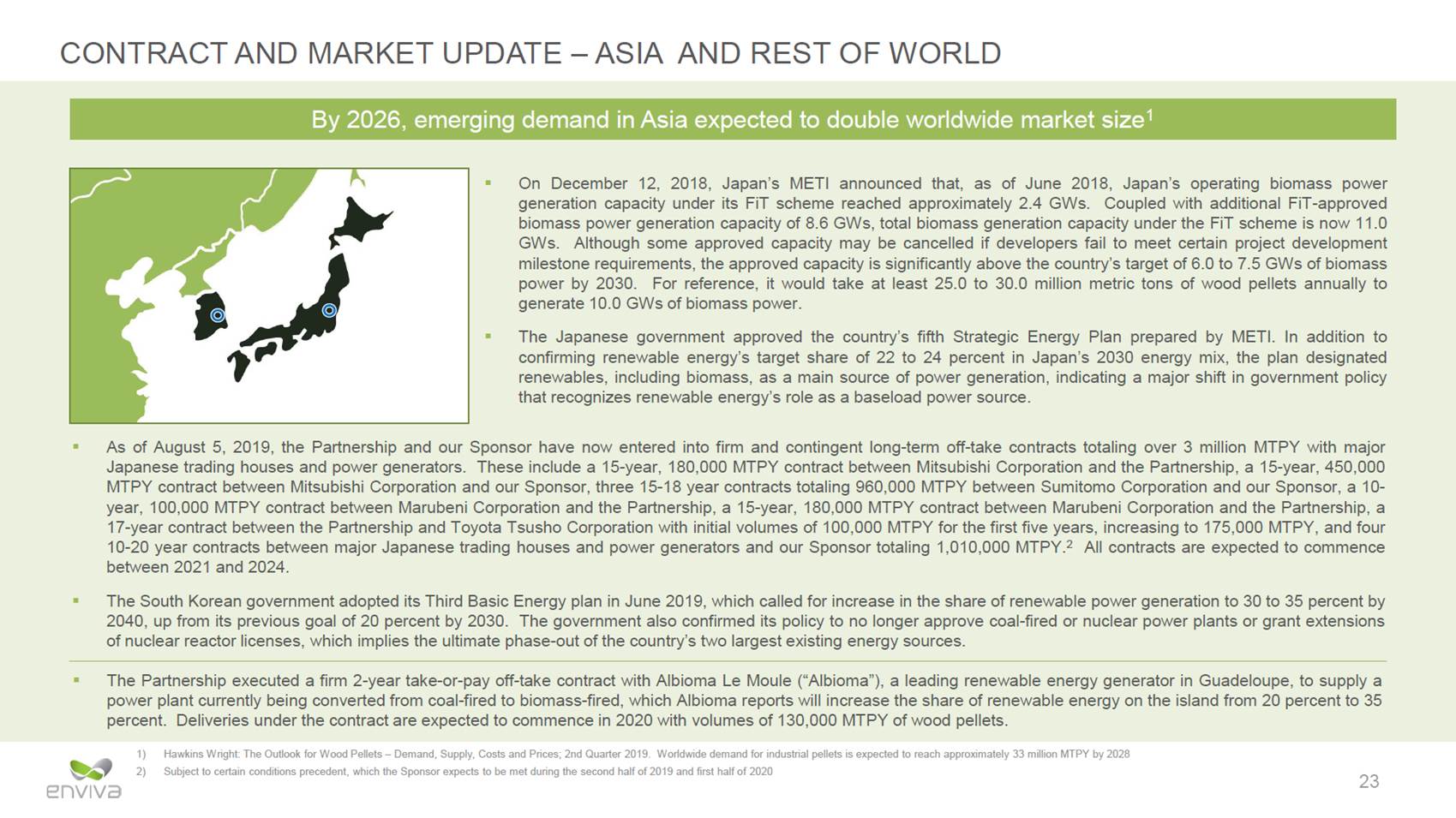
env1va . ... Enviva's Port of Chesapeake terminal Substantial Growth Opportunities
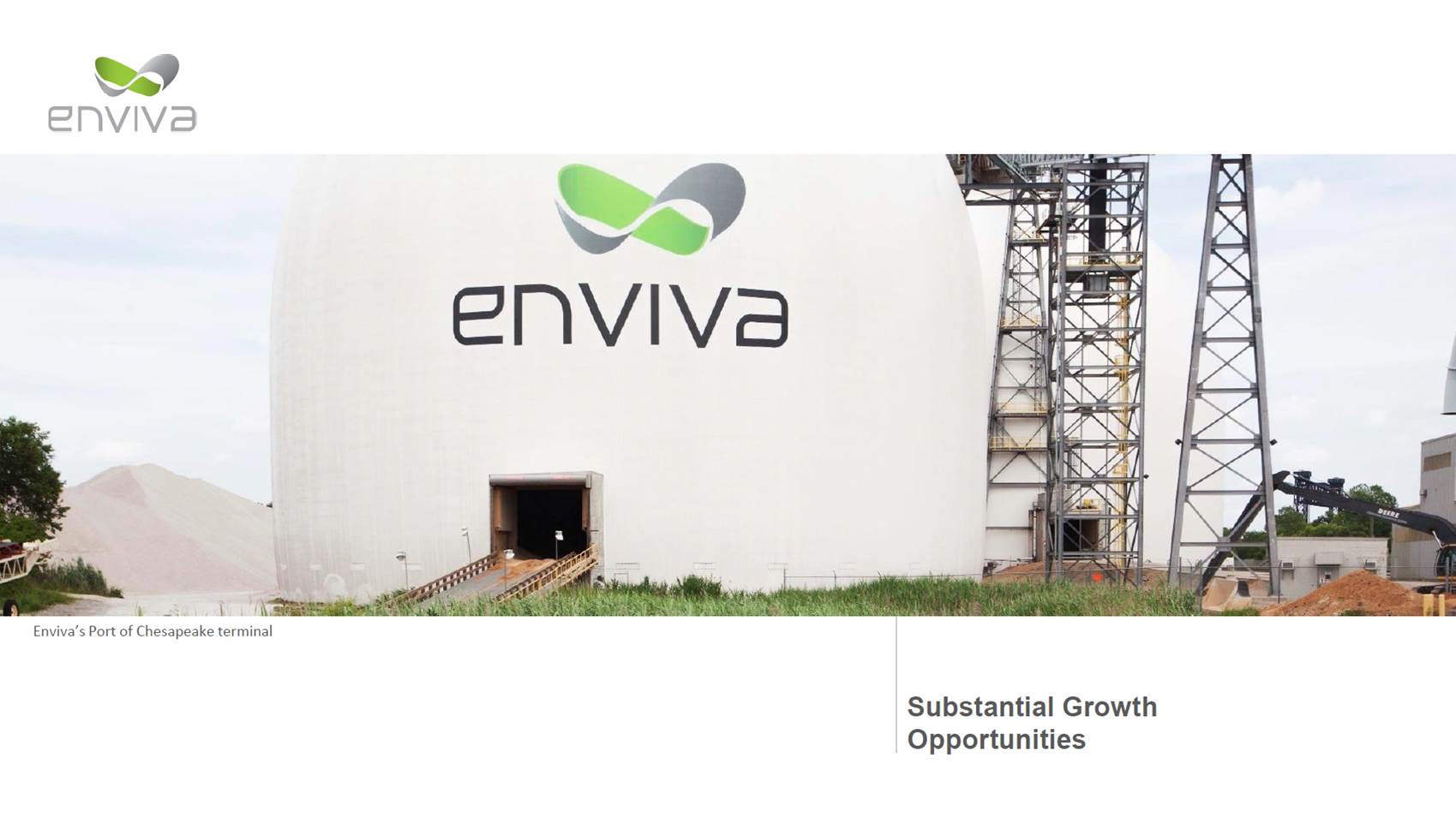
THREE PILLARS OF GROWTH Alabama, along with other sites in Alabama pellets through Pascagoula terminal5 1) Subject to receiving the necessary permits. Additional details are available as part of our earnings release as of November 8, 2018; 2) The estimated incremental adjusted EBITDA that can be expected from the expansions is based on an internal financial analysis of the anticipated benefit from the incremental production capacity at the Northampton and Southampton production plants. For an explanation of why we are unable to reconcile the estimated adjusted EBITDA for the expansions to the most directly comparable GAAP financial measures, please see slide 47; 3) Based on increases in nameplate capacity at the Amory, Ahoskie, Southampton, Northampton, Cottondale, and Sampson plants from 2016 to 2017; 4) Based on decreases in delivered fiber costs for Amory, Ahoskie, Southampton, Northampton, and Cottondale plants from 2016 to 2017 (the Sampson plant is not included as it was not owned by the Partnership for the full year of 2016) and for the Amory, Ahoskie, Southampton, Northampton, Sampson, and Cottondale plants from 2017 to 2018; 5) Subject to receiving necessary permits 25 Third-Party Acquisition Opportunities Proven, successful, and selective acquirer Acquisitions must compare favorably to Sponsor development pipeline and drop-down economics Target opportunities must be core to the business and bring new customer set, strategic capability, and/or geographic diversification Accretive Drop-Downs from Sponsor Four drop-downs since IPO including 1.7 million MTPY of production capacity and 3 million MTPY of terminaling capacity 3+ million MTPY development pipeline at our Sponsor, including: The Greenwood plant The Pascagoula terminal The Lucedale plant Potential pellet production plant in Epes, and Mississippi, which would export wood Locations near the Partnership’s existing terminals in the Port of Chesapeake and Port of Wilmington Organic Growth within the Partnership Pricing increases and escalators under existing contracted position 400,000 MTPY aggregate production capacity expansion underway at Northampton and Southampton1 ~$130.0 million expected investment and ~$30.0 million in expected incremental adjusted EBITDA annually2 Expected completion of construction in the first half of 2020 with startup and commercial operation shortly thereafter5 7 - 10% anticipated annual organic growth driven by contract price escalations, cost reduction, and productivity improvements 5% increase in nameplate production capacity achieved in 2017 over 20163 Reduced delivered fiber costs by approximately 5% in 2017 from 2016 and approximately 2% in 2018 from 20174
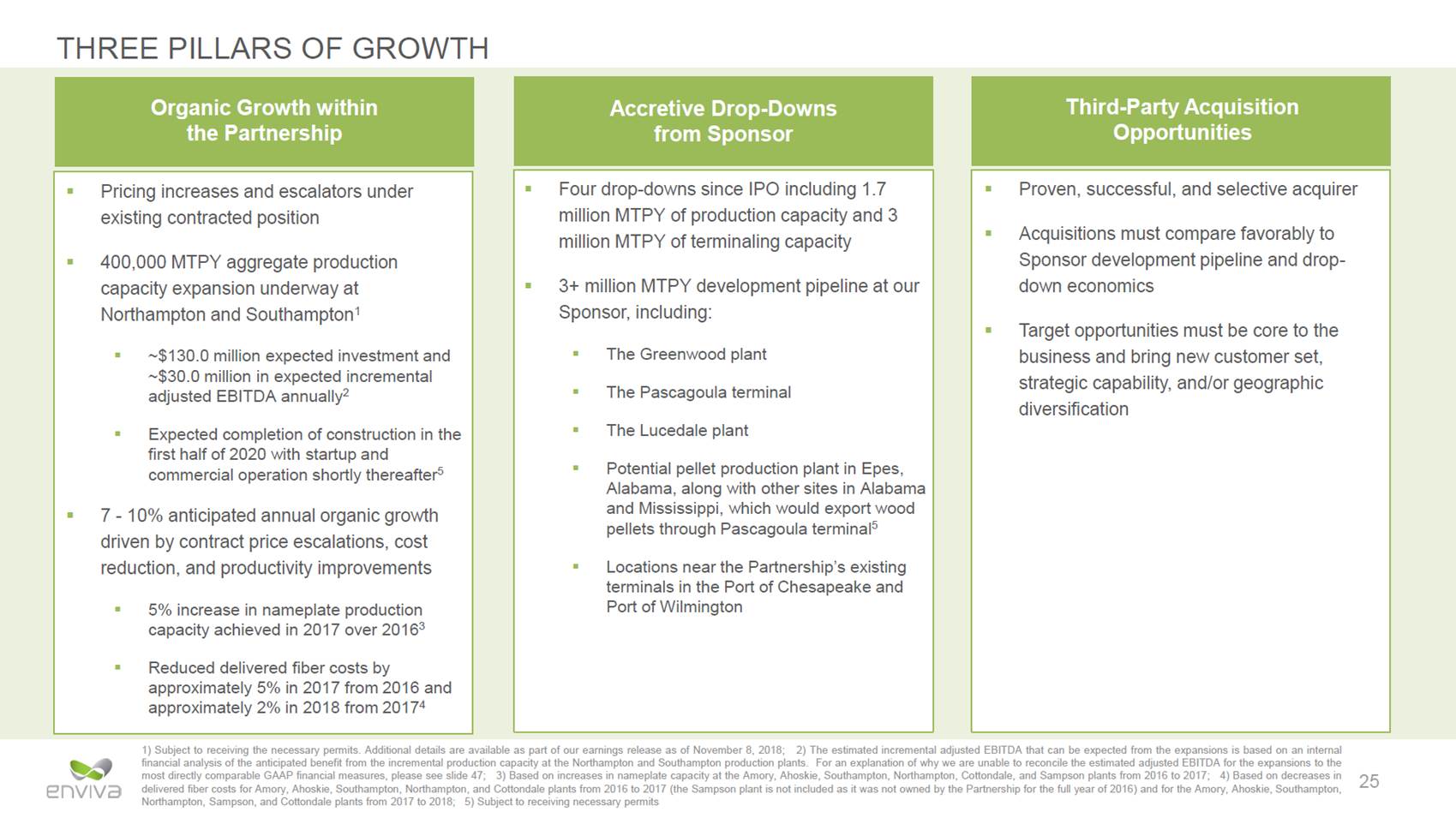
THE WILMINGTON CLUSTER term contract with Ørsted Plant Sites under Control Port 1) 2) 3) The Hamlet plant is now operating, and the Partnership expects the plant to exit 2019 with a production run-rate of approximately 500,000 MTPY and to reach its nameplate production capacity of approximately 600,000 MTPY in 2021 Currently owned by the Second JV The Second JV expects to increase production capacity of the Greenwood plant to 600,000 MTPY, after production ramp and incremental capital investments have been completed, subject to receiving the necessary permits 26 The Sponsor continues to evaluate development locations near the Partnership’s existing terminals 3 million MTPY throughput capacity Drop-down acquisition completed in October 2017 and April 2019 in tranched payments / Assessment PORT OF WILMINGTON, NC GREENWOOD, SC2 500,000 MTPY production capacity, expected to increase to 600,000 MTPY3 The Partnership currently purchases wood pellets produced by the Greenwood plant Plants SAMPSON, NC 600,000 MTPY upon achieving full production capacity Drop-down acquisition completed in December 2016 and included a long-HAMLET, NC 600,000 MTPY capacity1 Commenced operations and expected to exit 2019 with a 500,000 MTPY run-rate Production supporting off-take contract to supply the Macquarie MGT Teesside project in the UK

THE PASCAGOULA CLUSTER1 Plant Sites under Control / Assessment 1)The Pascagoula terminal, the Lucedale plant, and a potential production plant in Epes, Alabama are currently being developed by the Sponsor and the Second JV 27 The Sponsor’s existing contracts underwrite two production plants around the Pascagoula terminal, in addition to the Lucedale plant “Build-and-copy” production plant Robust fiber basket ~50 miles to Port of Pascagoula PlantsPort LUCEDALE, MS EPES, AL “Build-and-copy” deep-water marine terminal Multi-modal access by rail, truck and barge Deep berth capable of supporting Ultramax ships PORT OF PASCAGOULA, MS “Build-and-copy” production plant Robust fiber basket Connected to Port of Pascagoula by barge and rail EPES, AL
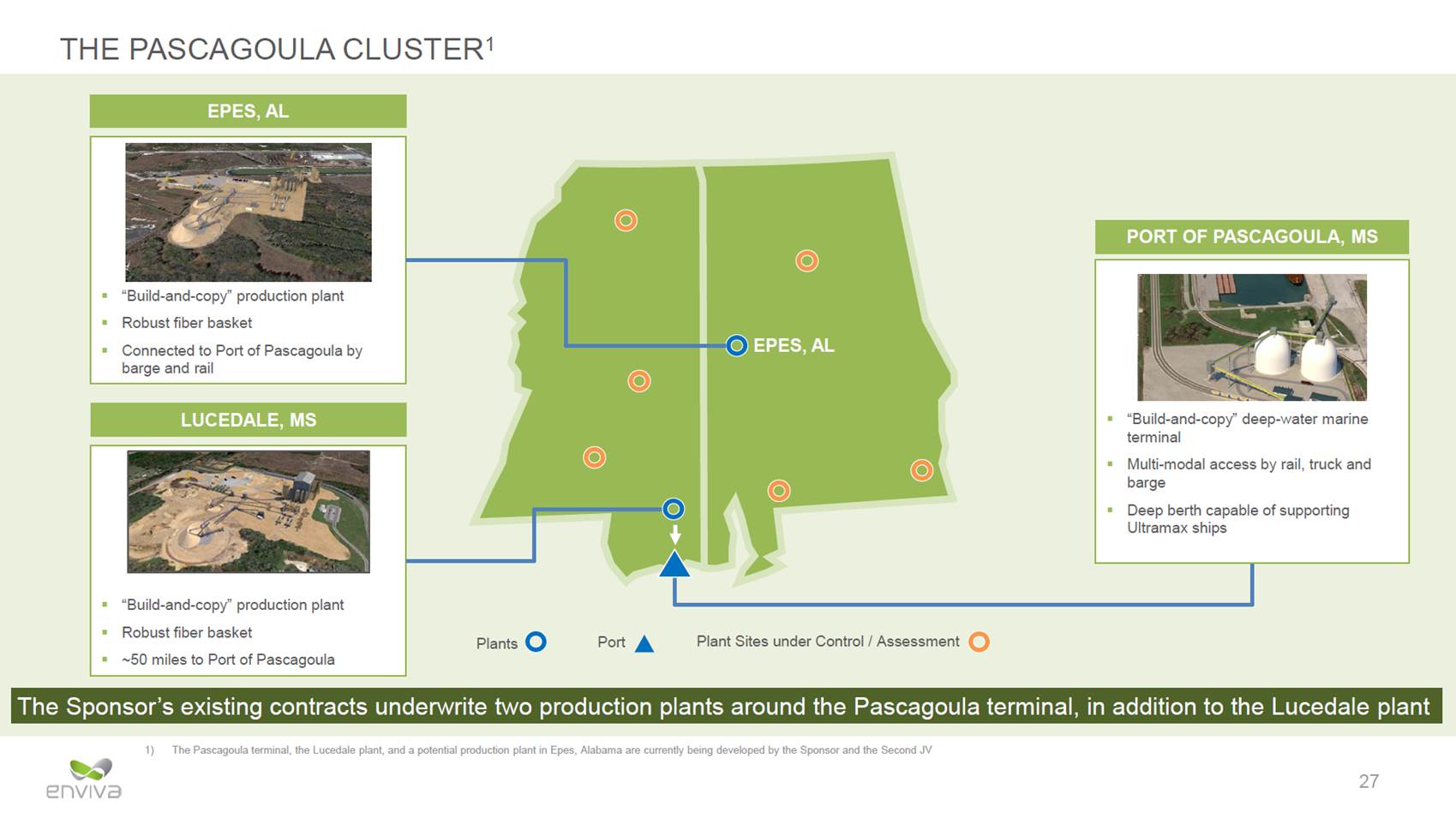
DEVELOPMENT AND EXPANSION OPPORTUNITIES 1)Assets under control / assessment are shown at approximate locations 2)The estimated incremental adjusted EBITDA is based on an internal financial analysis of the anticipated benefit from the incremental production capacity at the Northampton and Southampton production plants. For an explanation of why we are unable to reconcile the estimated adjusted EBITDA for the expansions to the most directly comparable GAAP financial measures, please see slide 47 28 Production Capacity Expansion Underway at Southampton and Northampton Plants ~400,000 MTPY expected aggregate capacity expansion ~$30.0 million in expected incremental adjusted EBITDA annually2 ~$130.0 million expected investment in additional production assets and emissions control equipment Expected completion of expansion activities in the first half of 2020 with startup and commercial operation shortly thereafter Sponsor’s Development Pipeline – “Build and Copy” Approach Greenwood, SC Lucedale, MSPort of Jacksonville, FL Port of Pascagoula, MS Plants in the PartnershipPorts in or leased by the Partnership Plants under construction / expansionPort sites under control / assessment1 Plant sites under control / assessment1
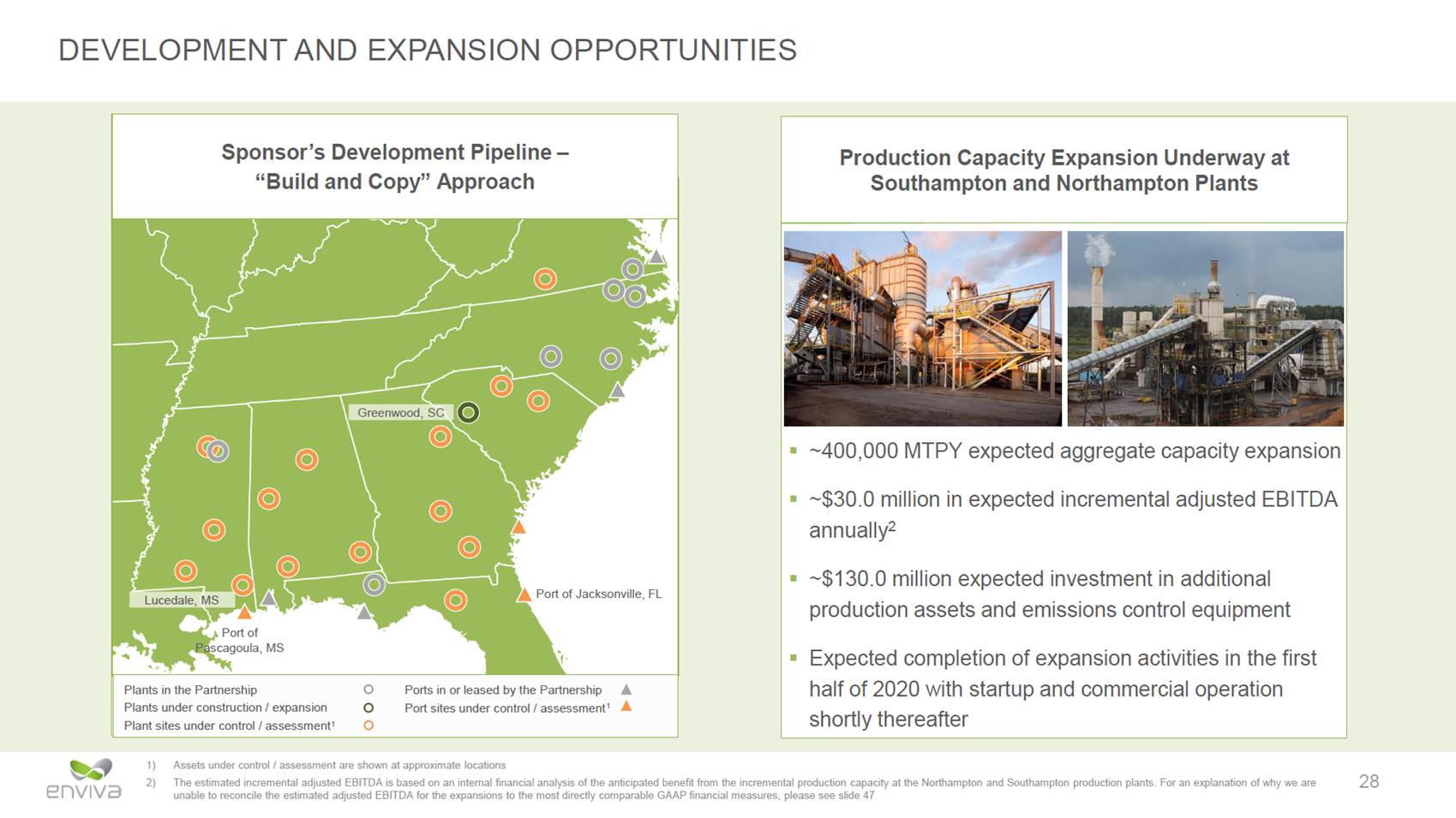
VISIBLE GROWTH 1) On February 20, 2019, provided full-year 2019 guidance for net income in a range of $31.0 to $39.0 million and adjusted EBITDA in the range of $127 to $135 million. See slide 44 for additional details; 2) On August 7, 2019, reaffirmed full-year 2019 guidance for net income in a range of $18.9 to $26.9 million and adjusted EBITDA in the range of $140.7 to $148.7 million, as previously provided on May 8, 2019. The $13.7 million increase in the estimated range for adjusted EBITDA for full-year 2019 is attributable to incremental adjusted EBITDA associated with the Partnership’s purchase of the Sponsor’s interest the First JV, which owns the Hamlet plant, in April 2019 (the “Hamlet Transaction”) and the benefit of the terminal services agreement to handle contracted volumes from the Hamlet plant at the Wilmington terminal during the second quarter of 2019. See slide 44 for additional details; 3) See slide 46 for reconciliation of estimated adjusted EBITDA to estimated net (loss) income; 4) The estimated incremental adjusted EBITDA that can be expected from the Southampton/Northampton expansions is based on an internal financial analysis of the anticipated benefit from the incremental production capacity at these plants; 5) The estimated incremental adjusted EBITDA that can be expected from a drop-down of a wood pellet production plant or a marine terminal is based on similar plants and terminals in our portfolio and the sequence of the drop-down transactions is for illustrative purposes only and subject to change. Although we expect to have the opportunity to acquire assets or completed development projects, including the Greenwood plant and the Lucedale plant, from our Sponsor or the Second JV in the future, we cannot assure you that our Sponsor or the Second JV will be successful in completing their development/improvement projects or that we will successfully negotiate an agreement with our Sponsor or the Second JV to acquire such assets or projects; 6) On March 25, 2019, provided full-year 2021 guidance for net income in the range of $87.7 million to $117.7 million and adjusted EBITDA in the range of $210.0 million to $240.0 million. See slide 45 for reconciliation of estimated adjusted EBITDA to estimated net (loss) income; 7) For an explanation of why we are unable to reconcile the estimated adjusted EBITDA for the Southampton/Northampton expansions to the most directly comparable GAAP financial measures, please see slide 47 29 PascagoulaCluster Pascagoula Southampton / HamletExpansions4,7The Partnership expects to exit 2020 Plant3excess of $200 million annually6 + 7 – 10% anticipated annual organic growth expected in underlying base business without drop-down acquisitions Sponsor’s contracts underwrite two additional production plants and a terminal in the Pascagoula cluster Potential to double expected 2019 adj. EBITDA in a few years2021 Plant Drop5 - Greenwood or 2020 Plant Drop5Lucedale Plant - Greenwood or Lucedale Plant $140.7 - $148.7Northampton with run-rate adjusted EBITDA well in 2019 Guidance, Updated2 Pascagoula Terminal5Plant 35 Cluster Plant 25 $127 – $135 2019 Guidance1 $26 - $27 ~ $30 $25 $25 $25 $15+ $25
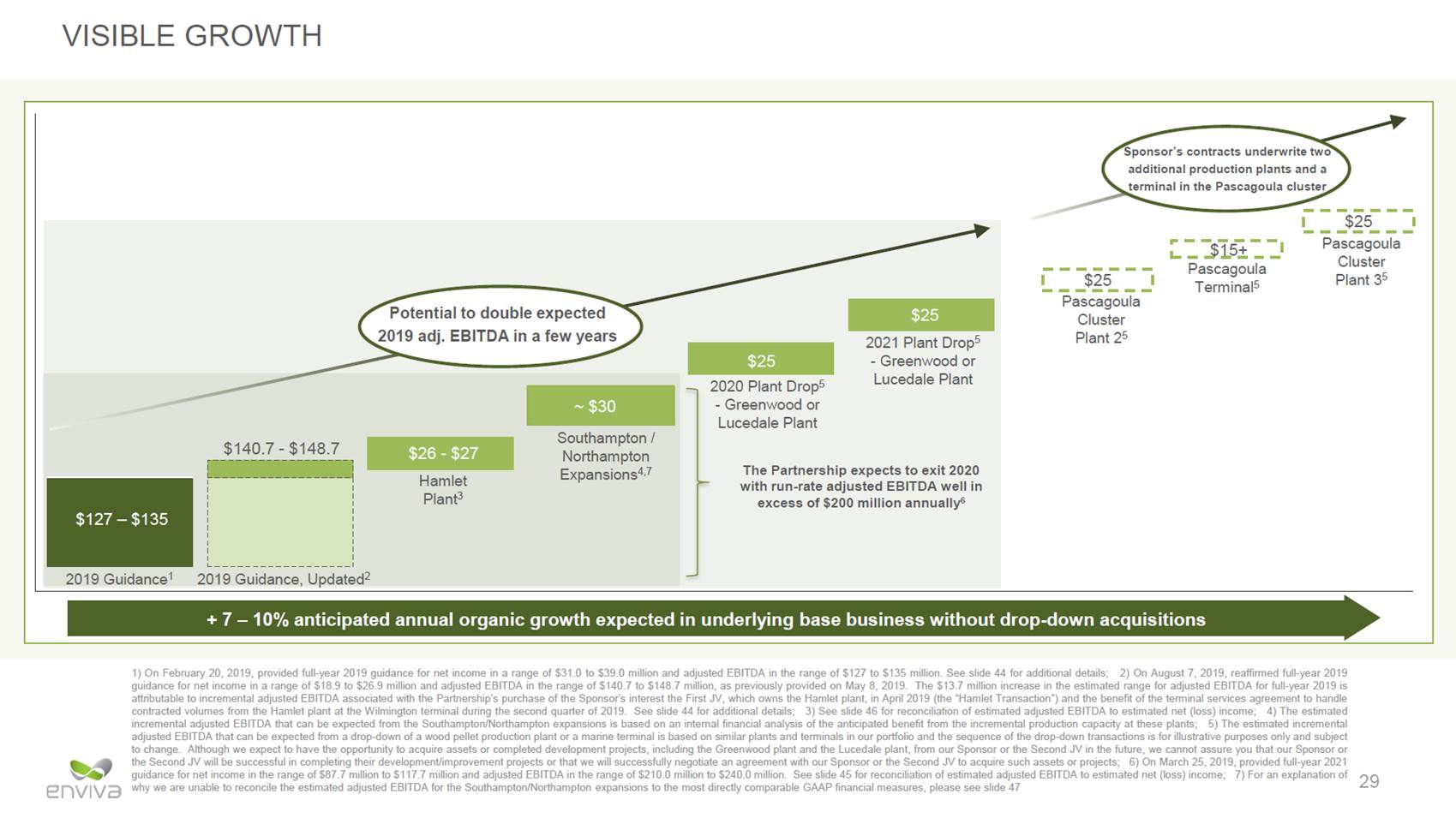
BREAKING THE FIBER LOGISTICS BARRIER UNLOCKS NORTH AMERICAN BASIS DIFFERENTIAL $160 $59 Germany Source: All data except data for Brazil are from RISI World Timber Price Quarterly – December 2018 for the third quarter of 2018. The wood chip price for Latvia is based on CIF Sweden. Data for Brazil is from Forest2Market - the cost of delivered wood chips in Brazil is approximately US$41-$43 per green metric ton. The primary in-country market for these chips is the food production and crop industries, which use chips for heat and drying purposes. However, the average minimum FOB price in Brazil is around US$148 per dry metric ton due to the logistical and administrative costs related to exporting these chips 30 Raw Material (Wood Chip) Price US$ / Dry Ton Latvia $189 $126 Southern US Japan $148 Brazil >$250 Billion Value of annual global trade in wood products Pelletizing fiber breaks logistics barrier and enables worldwide delivery
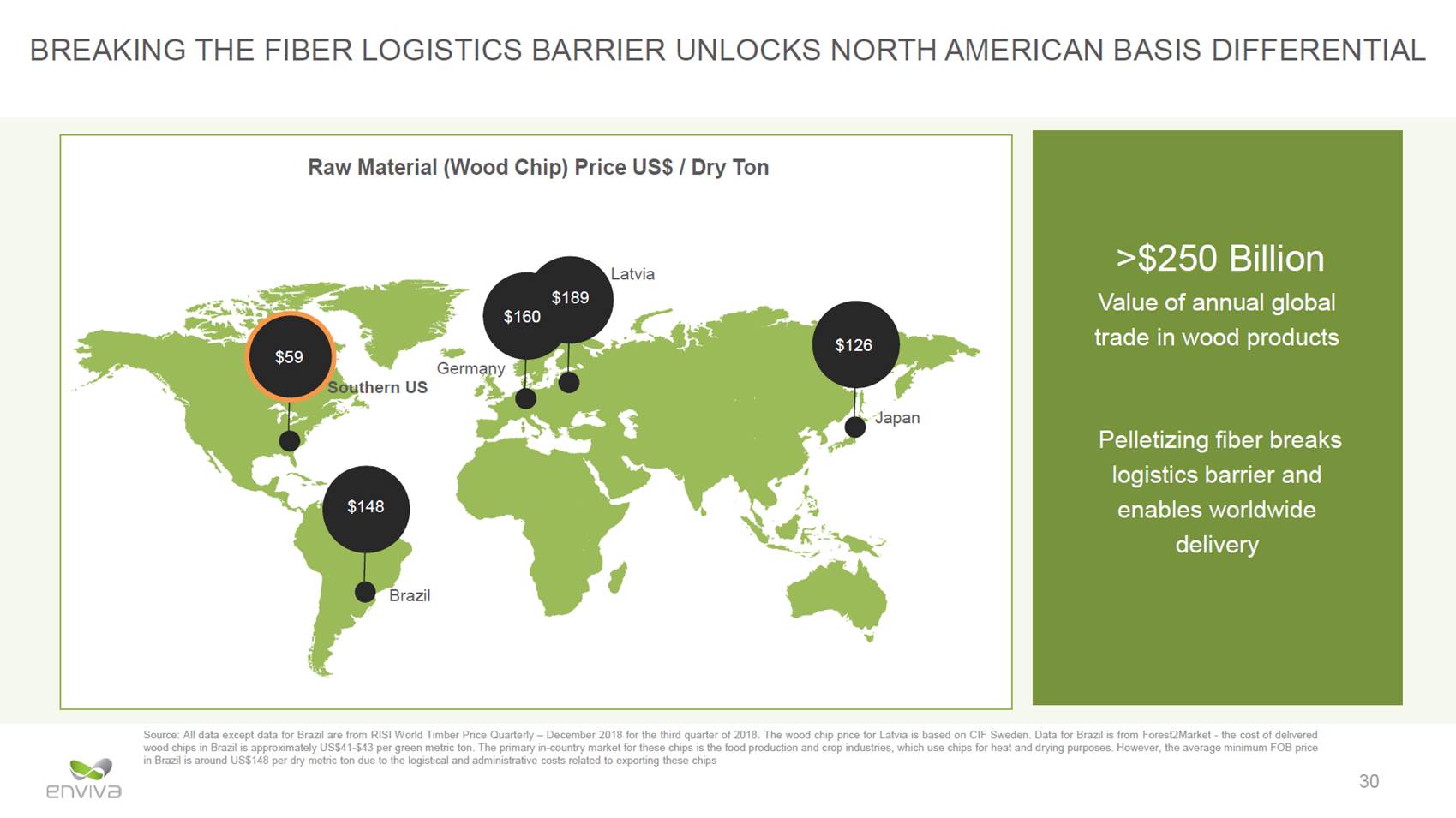
MARKET GROWTH DRIVEN BY APPLICATION DIVERSITY 1)Graph illustrative only 31 Market Driven Policy Driven Price Per Ton Long-term contracted demand for wood pellet displacement of coal has enabled substantial infrastructure investment in processing and logistics assets Resulting global distribution capability for low cost fiber can fulfill emerging demand from other applications for wood pellets Future Market Application and Potential Size1 Chemicals Polymers Bio-Crude Cellulosic (C5 / C6 sugar) Lignin bi-products Industrial Steam District Heating Loops Retail Heating CHP Combined Heat & Power Coal Displacement
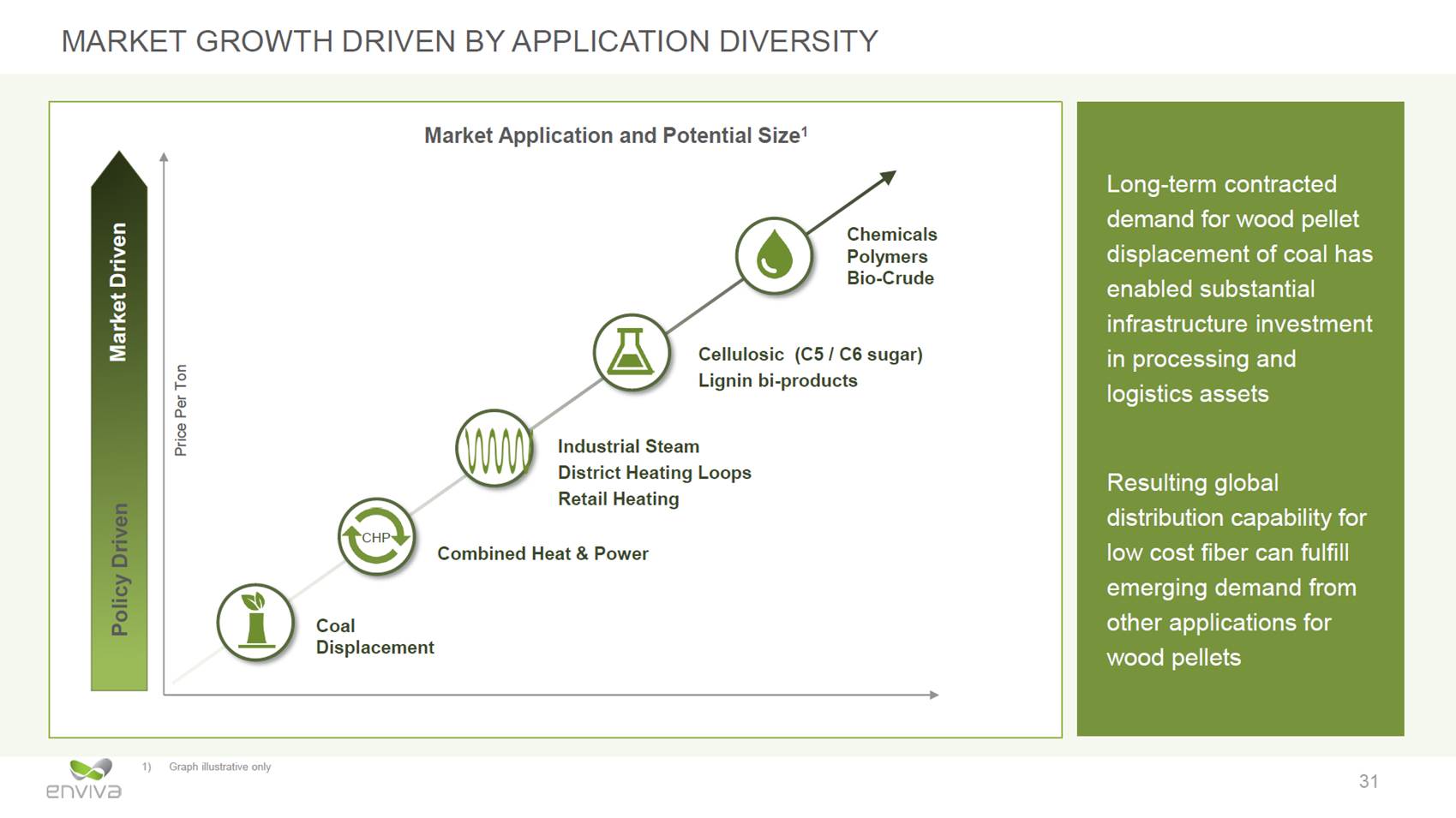
Night Shift at Enviva Pellets Northampton Financial Highlights 32
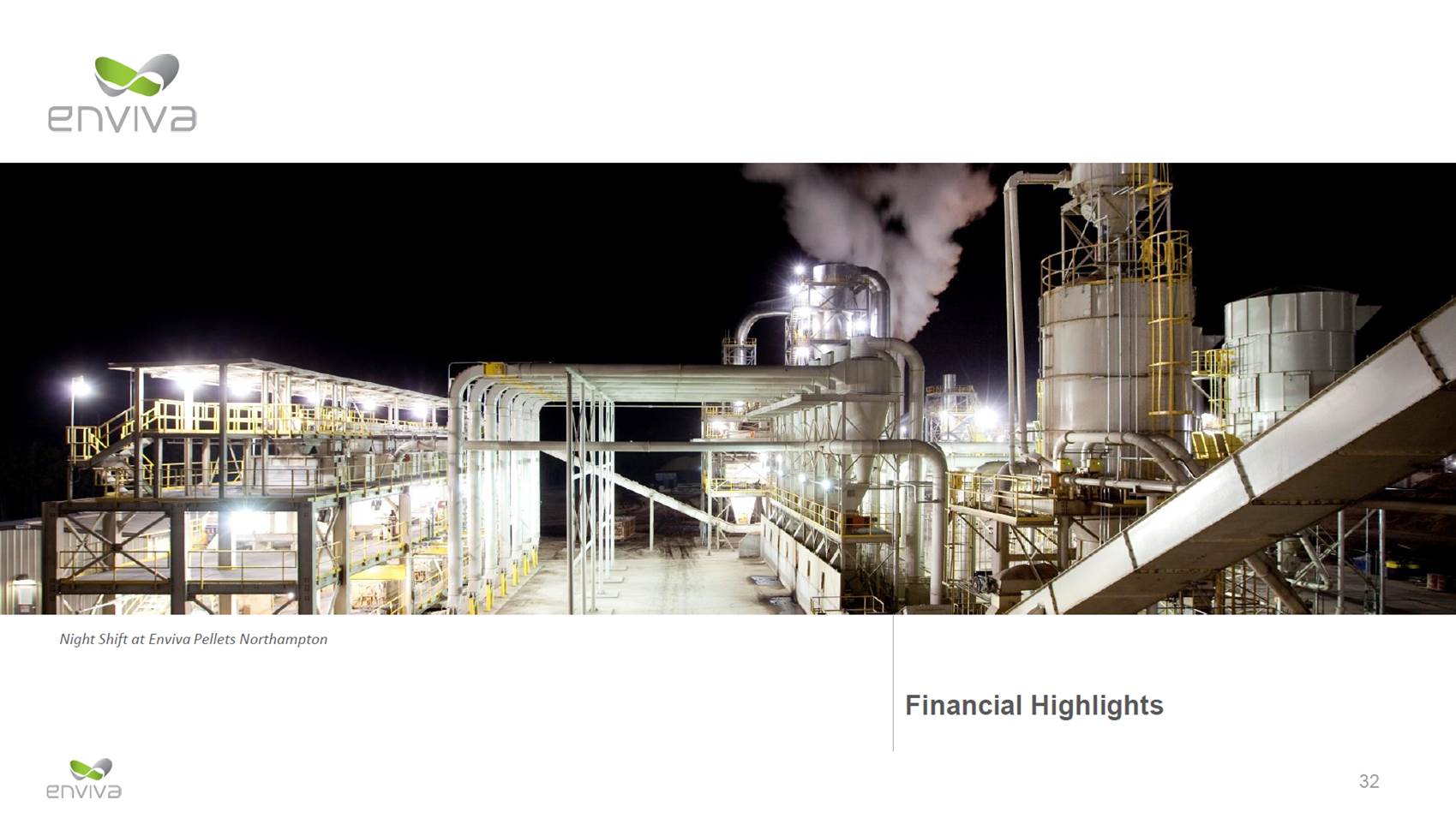
GUIDANCE December 31, 20212 1) 2) 3) Additional details are available as part of our earnings release as of August 7, 2019 Additional details are available as part of our press release as of March 25, 2019 On August 8, 2019, reaffirmed distribution guidance per common unit of at least $2.65 for full-year 2019 and $2.87 to $2.97 for full-year 2020 33 Targeted annual distribution coverage ratio for the full years of 2019 and 2020 is at least 1.20 times, on a forward looking basis2 The Partnership expects to distribute at least $2.65 per common unit for full-year 2019 and $2.87 to $2.97 per common unit for full-year 20203 $ MILLIONS, EXCEPT PER UNIT FIGURE Twelve Months Ending December 31, 20191 Twelve Months Ending NET INCOME $18.9 – 26.9 $87.7 – 117.7 ADJUSTED EBITDA $140.7 – 148.7 $210.0 – 240.0 INTEREST EXPENSE $41.9 - MAINTENANCE CAPEX $6.8 - DISTRIBUTABLE CASH FLOW $92.0 – 100.0 - DISTRIBUTION PER UNIT OF AT LEAST $2.65 -
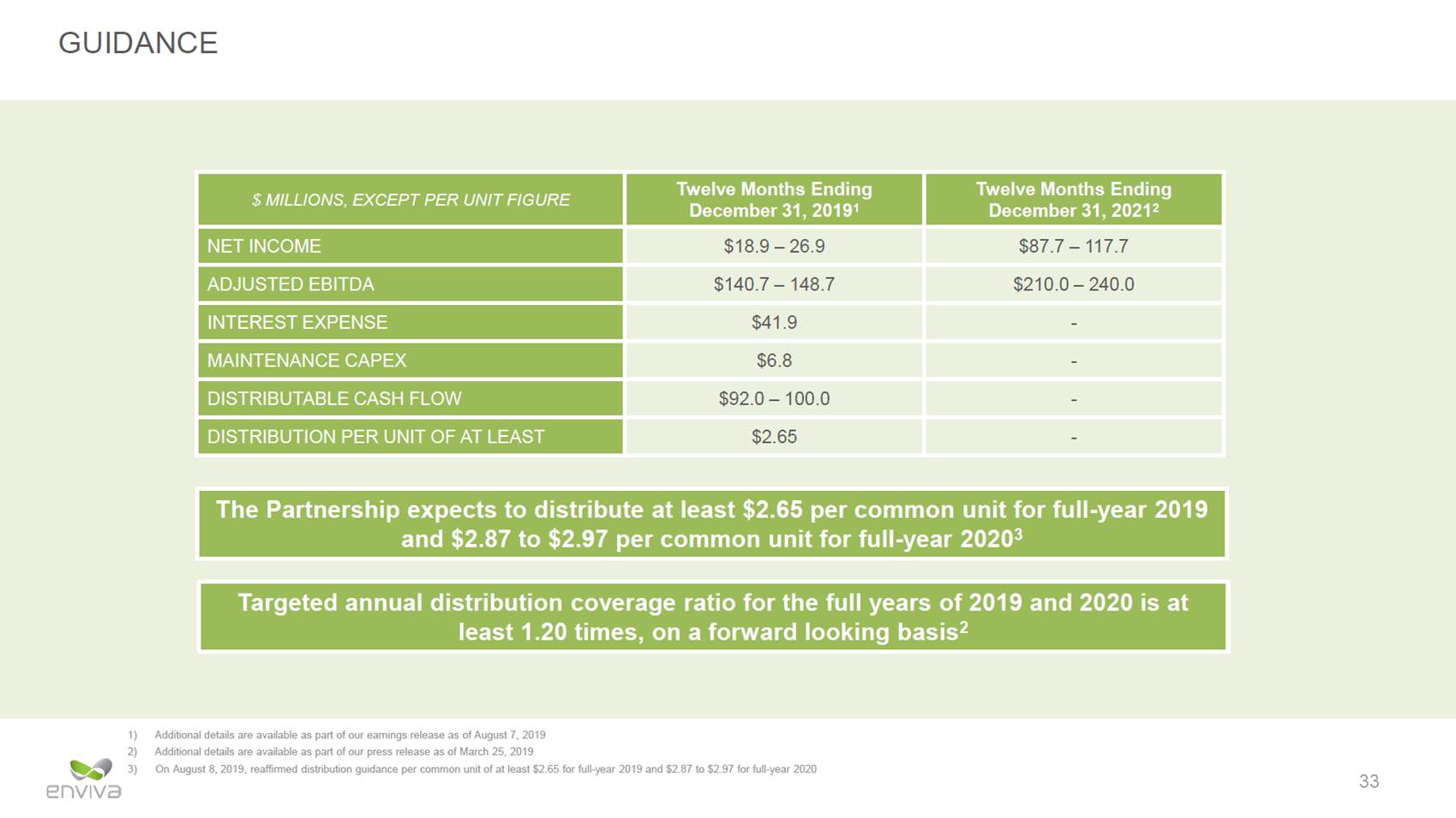
FINANCIAL RESULTS June 30, 2018 1) 2) 3) Prior to any distributions paid to our general partner Per common unit See slides 42 and 43 for Adjusted EBITDA, Adjusted Gross Margin per Metric Ton and Distributable Cash Flow reconciliations 34 Sixteenth consecutive distribution increase since the initial public offering $ MILLIONS, EXCEPT PER METRIC TON AND PER UNIT FIGURE Three Months Ended June 30, 2019 Three Months Ended NET REVENUE $168,079 $135,596 COST OF GOODS SOLD $151,572 $115,785 GROSS MARGIN $16,507 $19,811 AGM PER METRIC TON3 $32.26 $36.63 NET INCOME (LOSS) ($3,801) $3,544 ADJUSTED EBITDA3 $26,962 $21,072 DISTRIBUTABLE CASH FLOW1 $17,229 $11,074 DISTRIBUTION PER UNIT2,3 $0.660 $0.630
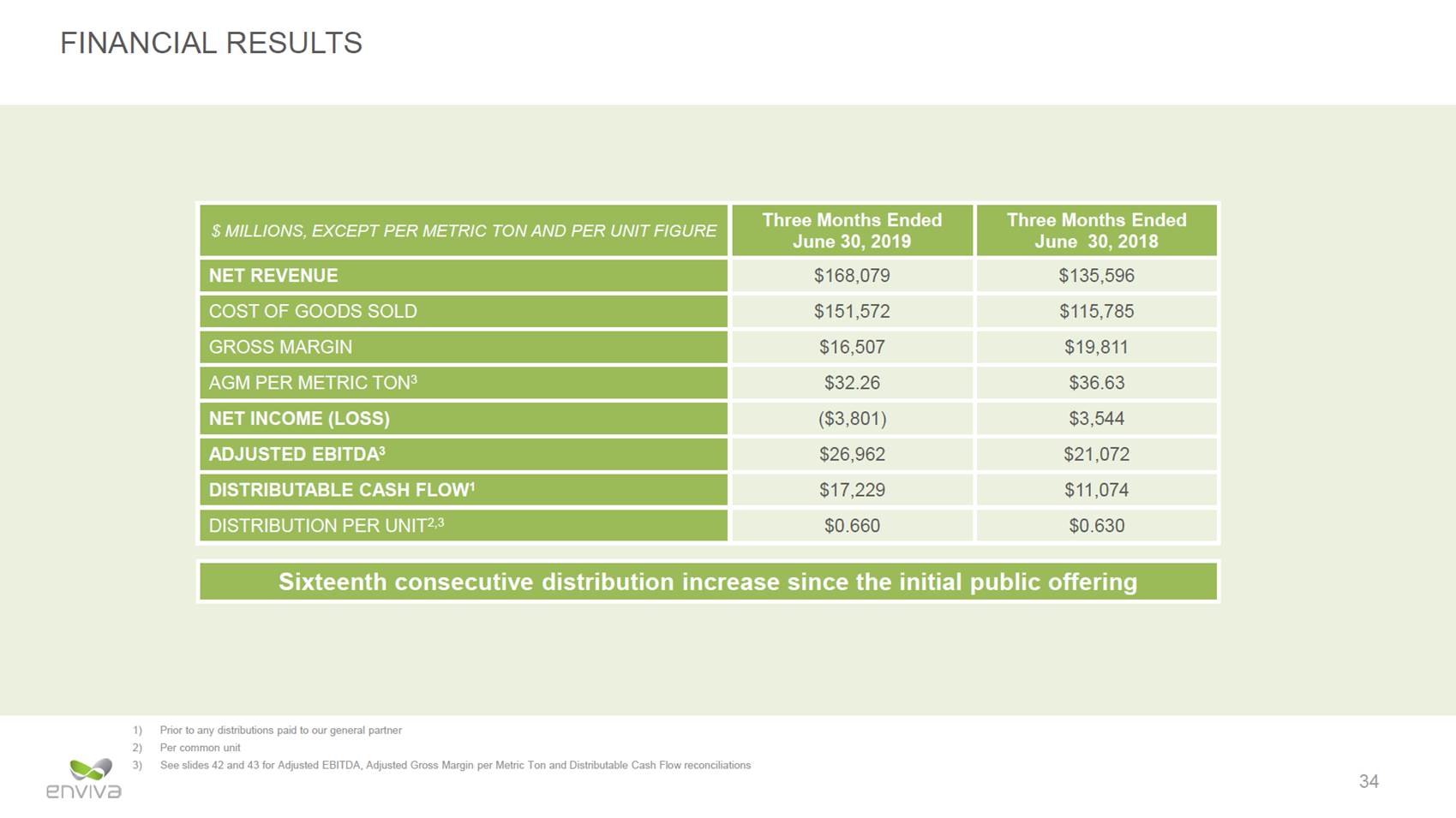
Tool and Die Work at Enviva’s Production Plant in Ahoskie, NC Experienced Team
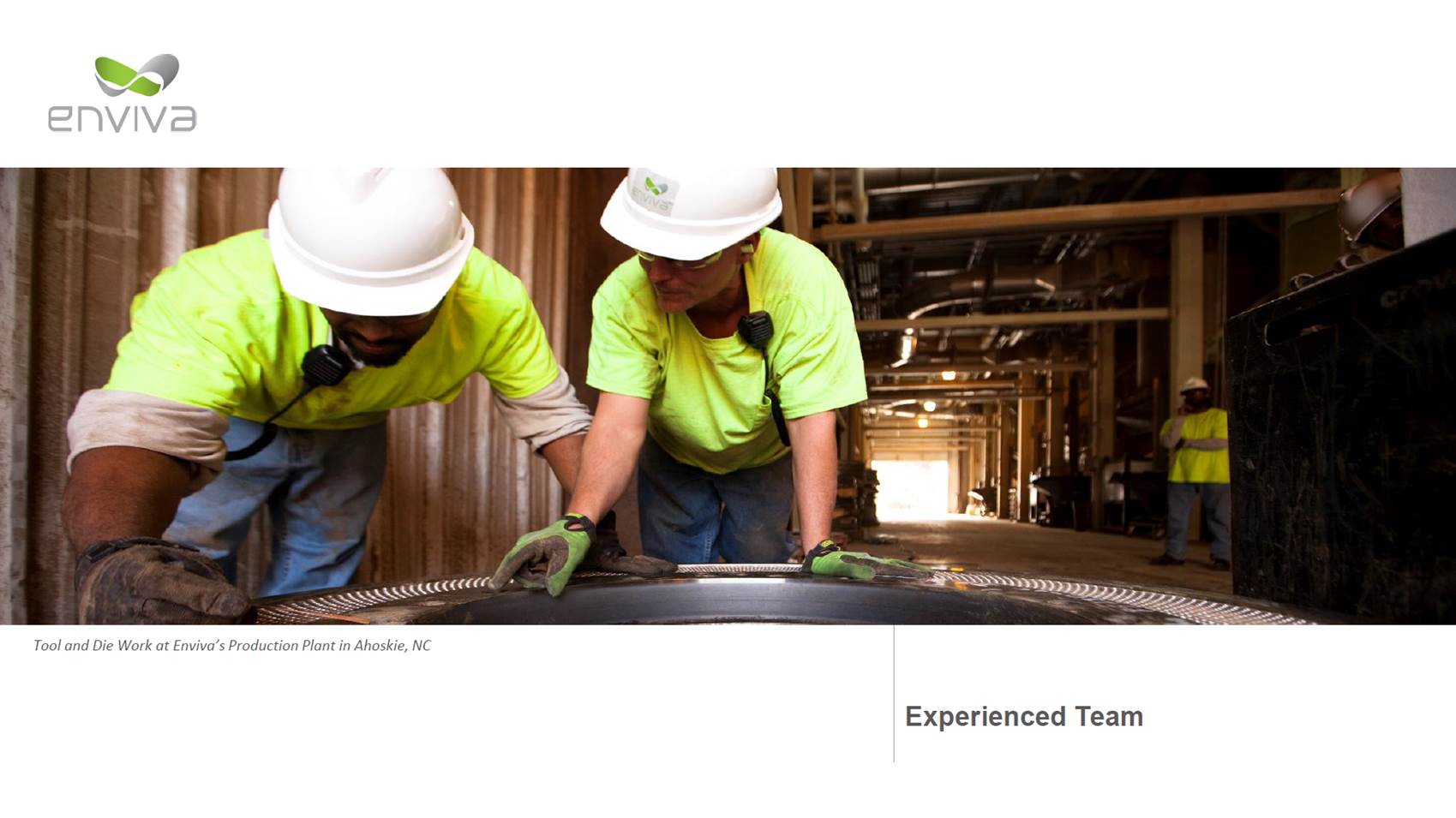
HIGH CALIBER LEADERSHIP BP Williams John Keppler Chairman & CEO John Bumgarner Director (Independent) Shai Even EVP & CFO Bill Reilly Director (Independent) Thomas Meth EVP, Sales & Marketing Gary Whitlock Director (Independent) EPA Exxon Bill Schmidt EVP, Corp. Dev. & GC Janet Wong Director (Independent) Buckeye Alon Royal Smith EVP, Operations Ralph Alexander Director Nic Lane EVP, Human Capital Robin Duggan Director CenterPoint KPMG Ray Kaszuba SVP, Finance & Treasurer Jim Derryberry Director Jim Geraghty VP, Operations Finance Chris Hunt Director GM AES Oscar Young VP, Corporate Controller Carl Williams Director 36 Management Directors Management and Board with Significant Industry Experience
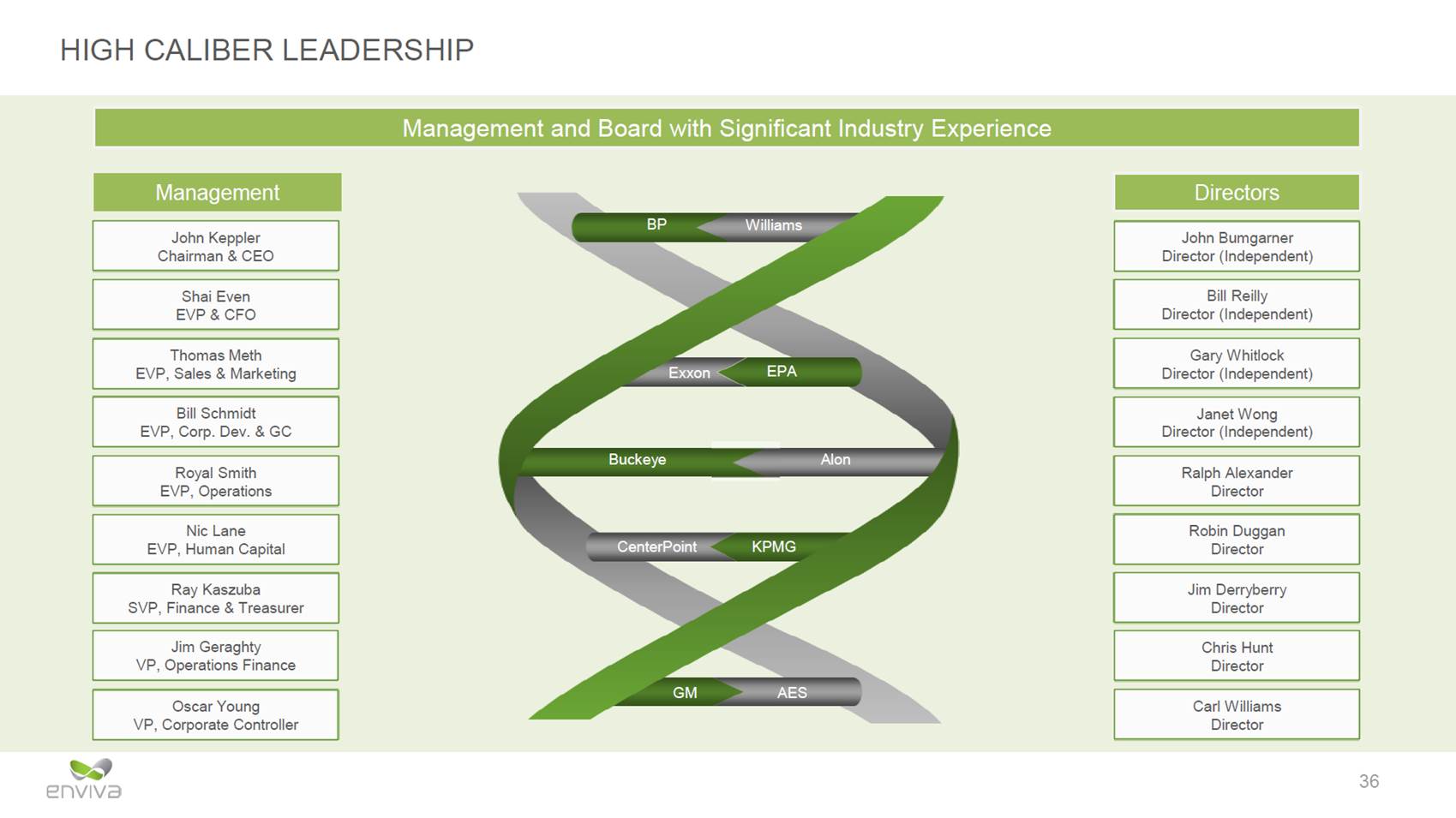
ENVIVA: A COMPELLING STORY Fully Contracted Through 2025 $9.6 billion backlog / 10.4 year weighted-average remaining term1 total return3 since IPO 1) 2) 3) 4) Revenue backlog and weighted-average remaining term of off-take contracts are as of August 5, 2019, excluding volumes under the contracts between long-term off-take customers and our Sponsor and the Second JV On August 8, 2019, reaffirmed distribution guidance per common unit of at least $2.65 for full-year 2019 Per Bloomberg, as of July 31, 2019 Includes all volumes under the firm and contingent off-take contracts held by the Partnership, our Sponsor and the Second JV. The Partnership expects to have the opportunity to acquire these contracts from our Sponsor and the Second JV 37 ~3.5 Million MTPY World’s largest utility-grade wood pellet producer Advantaged Portfolio of plants and ports $2.65 Distribution per Unit2 12.5% compound annual growth rate and 19.4% annualized $17.9 Billion / 13.2 Years Backlog held by the partnership, our Sponsor and its joint venture4 Visible Drop-Down Inventory 3+ million MTPY Sponsor development pipeline
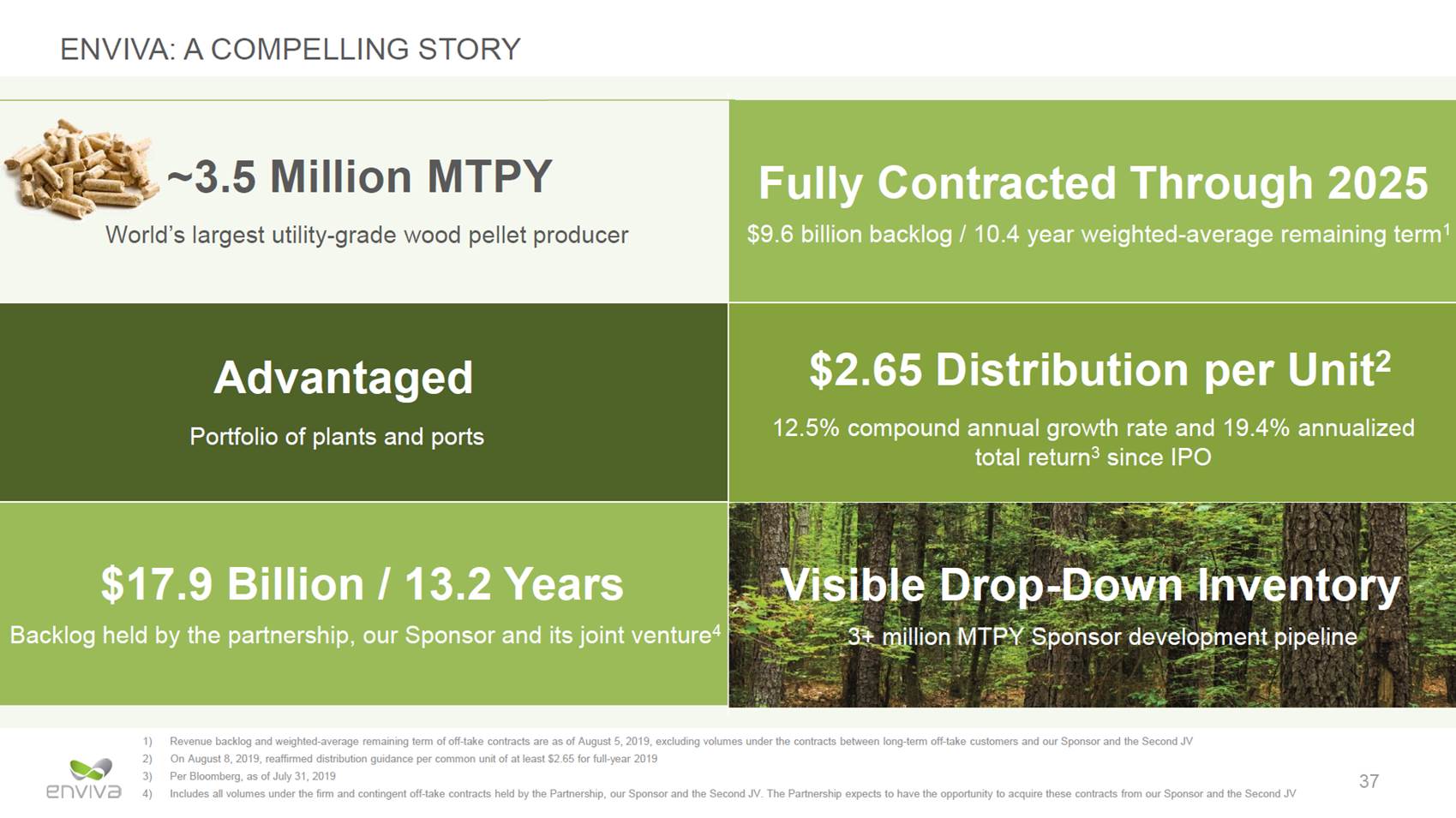
env1va WAY Financial Information & Reg G Reconciliations
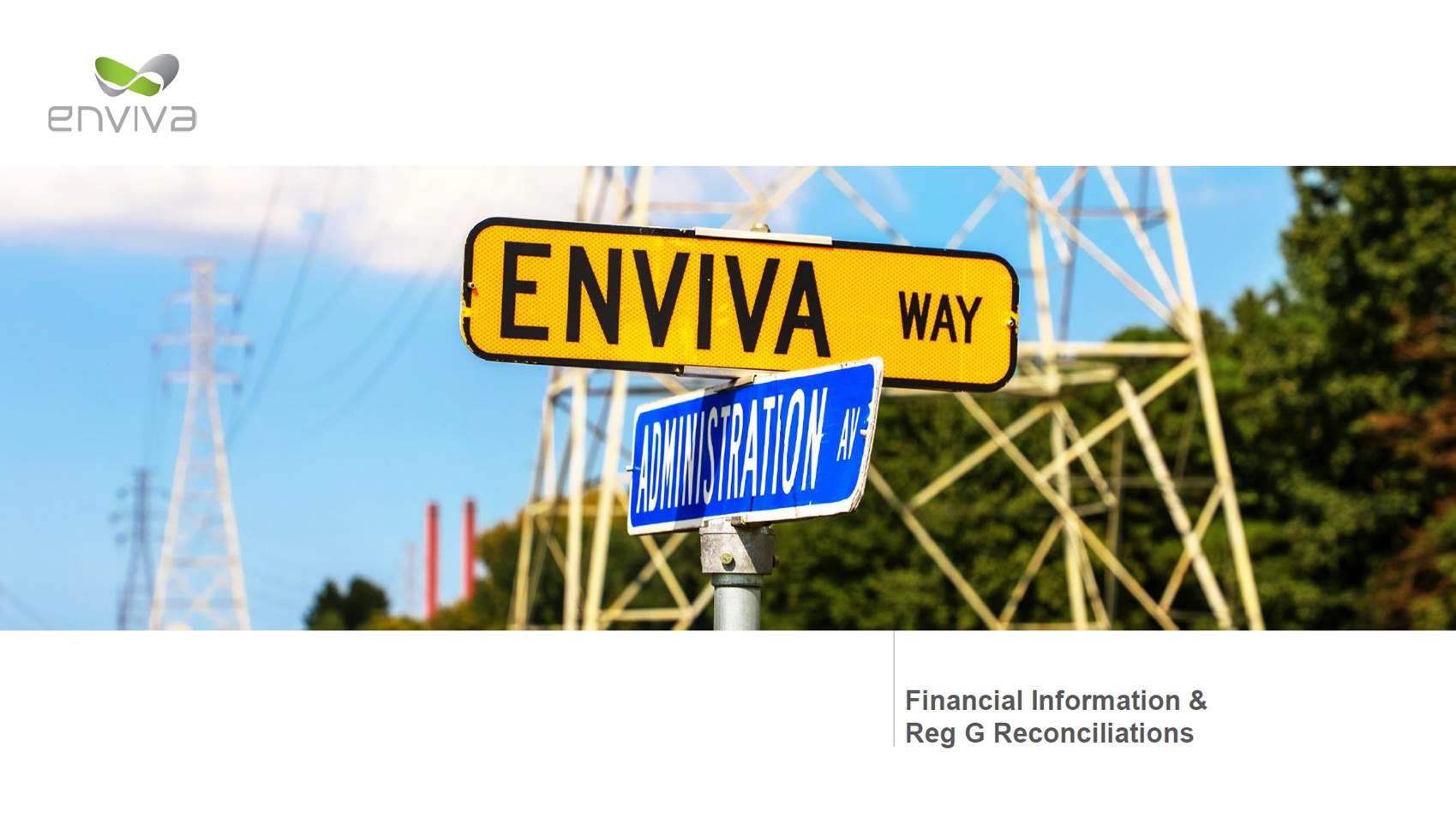
NON-GAAP FINANCIAL MEASURES This presentation contains certain financial measures that are not presented in accordance with GAAP. Although they should not be considered alternatives to the GAAP presentation of the financial results of the Partnership, management views such non-GAAP measures as important to reflect the Partnership’s actual performance during the periods presented. Non-GAAP Financial Measures We use adjusted gross margin per metric ton, adjusted EBITDA, and distributable cash flow to measure our financial performance. Adjusted Gross Margin per Metric Ton We use adjusted gross margin per metric ton to measure our financial performance. We define adjusted gross margin as gross margin excluding asset disposals, depreciation and amortization, changes in unrealized derivative instruments related to hedged items included in gross margin, certain non-cash waivers of fees for management services provided to us by our Sponsor (collectively, “MSA Fee Waivers”), and certain items of income or loss that we characterize as unrepresentative of our ongoing operations, including certain expenses incurred related to the previously reported fire incident at the Partnership’s marine export terminal in Chesapeake, Virginia (the “Chesapeake Incident”), which occurred during the first quarter of 2018, and Hurricanes Florence and Michael (the “Hurricane Events”), which occurred during the second half of 2018, consisting of emergency response expenses, expenses related to the disposal of inventory, and asset disposal and repair costs, offset by insurance recoveries received. We believe adjusted gross margin per metric ton is a meaningful measure because it compares our revenue-generating activities to our operating costs for a view of profitability and performance on a per metric ton basis. Adjusted gross margin per metric ton will primarily be affected by our ability to meet targeted production volumes and to control direct and indirect costs associated with procurement and delivery of wood fiber to our production plants and the production and distribution of wood pellets. Adjusted EBITDA We define adjusted EBITDA as net income or loss excluding depreciation and amortization, interest expense, income tax expense, early retirement of debt obligations, MSA Fee Waivers and unit compensation expense, asset impairments and disposals, changes in unrealized derivative instruments related to hedged items included in gross margin and other income and expense, and certain items of income or loss that we characterize as unrepresentative of our ongoing operations, including certain expenses incurred related to the Chesapeake Incident and Hurricane Events, consisting of emergency response expenses, expenses related to the disposal of inventory, and asset disposal and repair costs, offset by insurance recoveries received. Adjusted EBITDA is a supplemental measure used by our management and other users of our financial statements, such as investors, commercial banks, and research analysts, to assess the financial performance of our assets without regard to financing methods or capital structure. 39
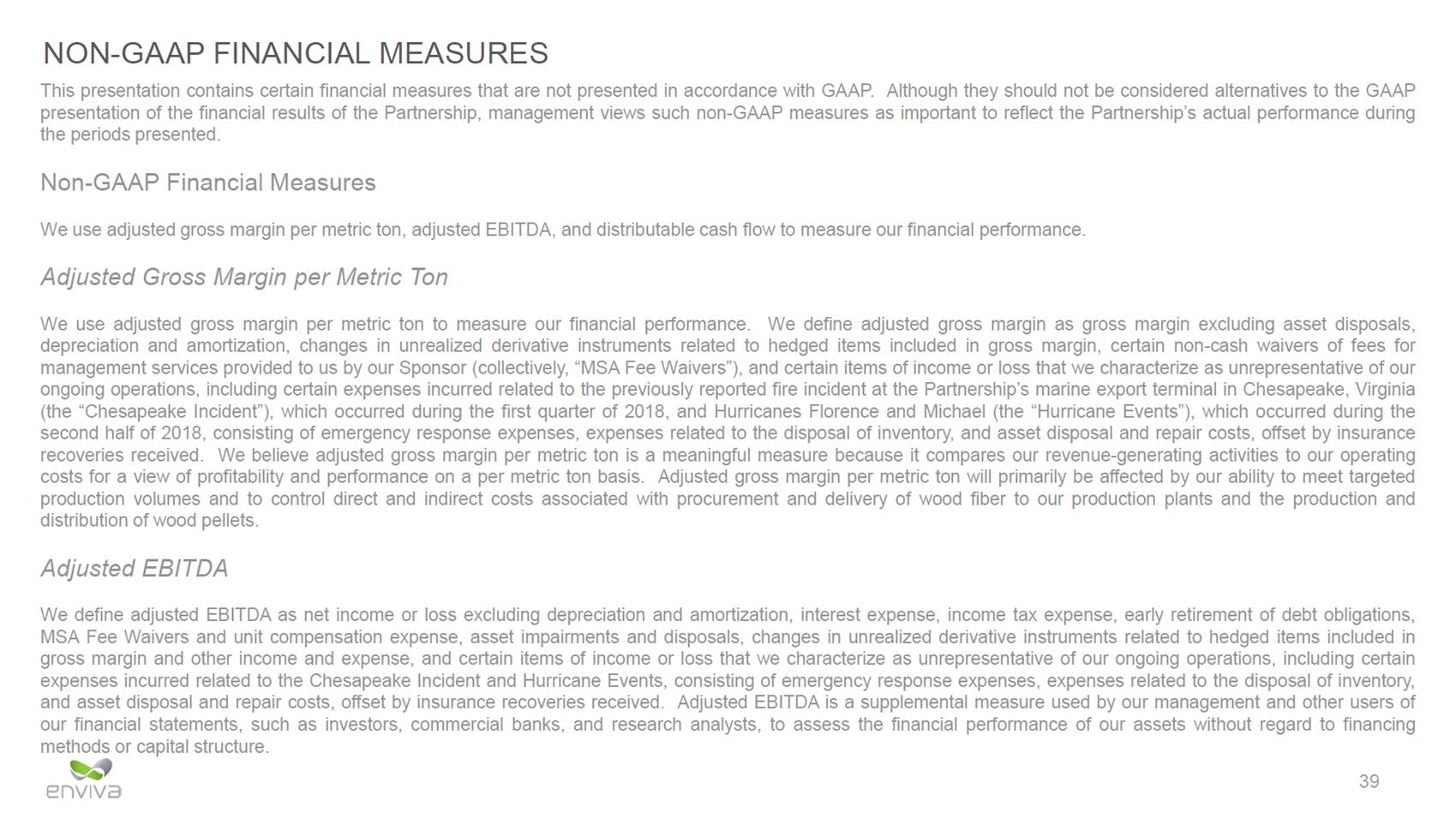
NON-GAAP FINANCIAL MEASURES - Continued Distributable Cash Flow We define distributable cash flow as adjusted EBITDA less maintenance capital expenditures and interest expense net of amortization of debt issuance costs, debt premium, original issue discounts and the impact from incremental borrowings related to the Chesapeake Incident and Hurricane Events. We use distributable cash flow as a performance metric to compare the cash-generating performance of the Partnership from period to period and to compare the cash-generating performance for specific periods to the cash distributions (if any) that are expected to be paid to our unitholders. We do not rely on distributable cash flow as a liquidity measure. Limitations of Non-GAAP Measures Adjusted gross margin per metric ton, adjusted EBITDA, and distributable cash flow are not financial measures presented in accordance with GAAP. We believe that the presentation of these non-GAAP financial measures provides useful information to investors in assessing our financial condition and results of operations. Our non-GAAP financial measures should not be considered as alternatives to the most directly comparable GAAP financial measures. Each of these non-GAAP financial measures has important limitations as an analytical tool because they exclude some, but not all, items that affect the most directly comparable GAAP financial measures. You should not consider adjusted gross margin per metric ton, adjusted EBITDA, or distributable cash flow in isolation or as substitutes for analysis of our results as reported under GAAP. Our definitions of these non-GAAP financial measures may not be comparable to similarly titled measures of other companies, thereby diminishing their utility. 40
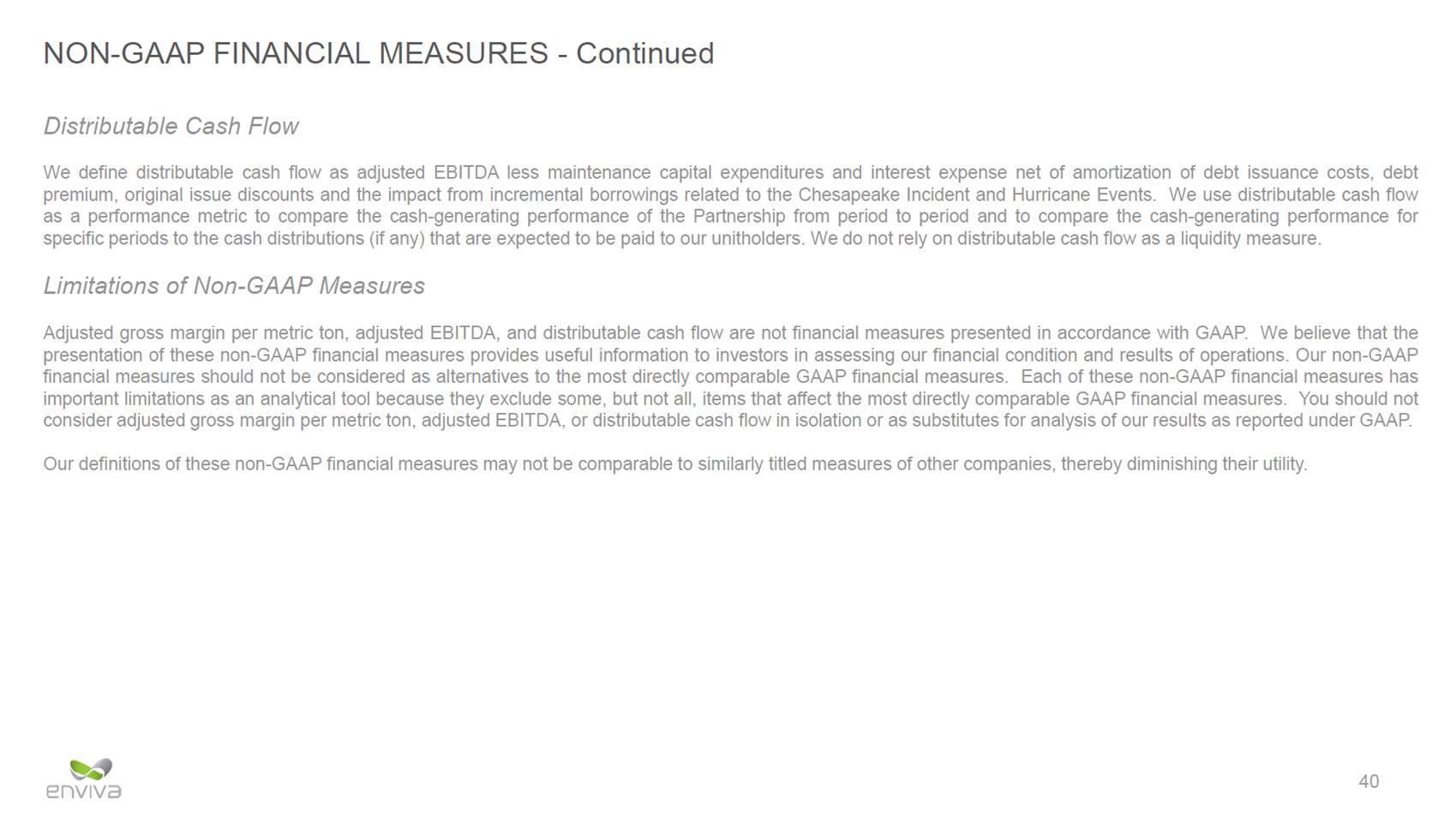
NON-GAAP FINANCIAL MEASURES RECONCILIATION The following table provides a reconciliation of distributable cash flow and adjusted EBITDA to net income (loss): See Note 1 of our financial statements, Description of Business and Basis of Presentation, to our Annual Report on the 10-K and slide 39 and 40 for basis of presentation. NDED DECEM 2017 $6,952 $14,373 $13,463 $40,745 $36,471 $751 $6,229 $40,361 $31,744 $27,735 $16,221 $4,438 $4,230 $5,014 $2,386 ($4,032) $12,951 $178 $102,631 $5,726 $1,565 $12,377 INSTRUMENTS $3,598 $102,381 $827 $79,291 $33,970 $30,297 $14,329 $4,872 $63,789 $5,867 $57,922 $4,353 $67,731 $3,398 $64,333 $5,187 $59,775 $1,077 $58,698 41 LESS: DISTRIBUTABLE CASH FLOW ATTRIBUTABLE TO INCENTIVE DISTRIBUTION RIGHTS DISTRIBUTABLE CASH FLOW ATTRIBUTABLE TO ENVIVA PARTNERS, LP LIMITED PARTNERS DISTRIBUTABLE CASH FLOW ATTRIBUTABLE TO ENVIVA PARTNERS, LP MAINTENANCE CAPITAL EXPENDITURES INTEREST EXPENSE, NET OF AMORTIZATION OF DEBT ISSUANCE COSTS, DEBT PREMIUI'v1, ORIGINAL ISSUE DISCOUNT AND IMPACT FROM INCREMENTAL BORROWINGS RELATED TO CHESAPEAKE INCIDENT LESS: DEPRECIATION AND AMORTIZATION INTEREST EXPENSE EARLY RETIREMENT OF DEBT OBLIGATION NON-CASH UNIT COMPENSATION EXPENSE INCOME TAX EXPENSE ASSET IMPAIRMENTS AND DISPOSALS CHANGES IN THE FAIR VALUE OF DERIVATIVE CHESAPEAKE INCIDENT AND HURRICANE EVENTS TRANSACTION EXPENSES ADJUSTED EBITOA ADD: NET INCOME RECONCILIATION OF DISTRIBUTABLE CASH FLOW AND ADJUSTED EBITDA TO NET INCOME 2016 2016 (RECAST) BER 31, (RECAST) $THOUSANDS YEAR E
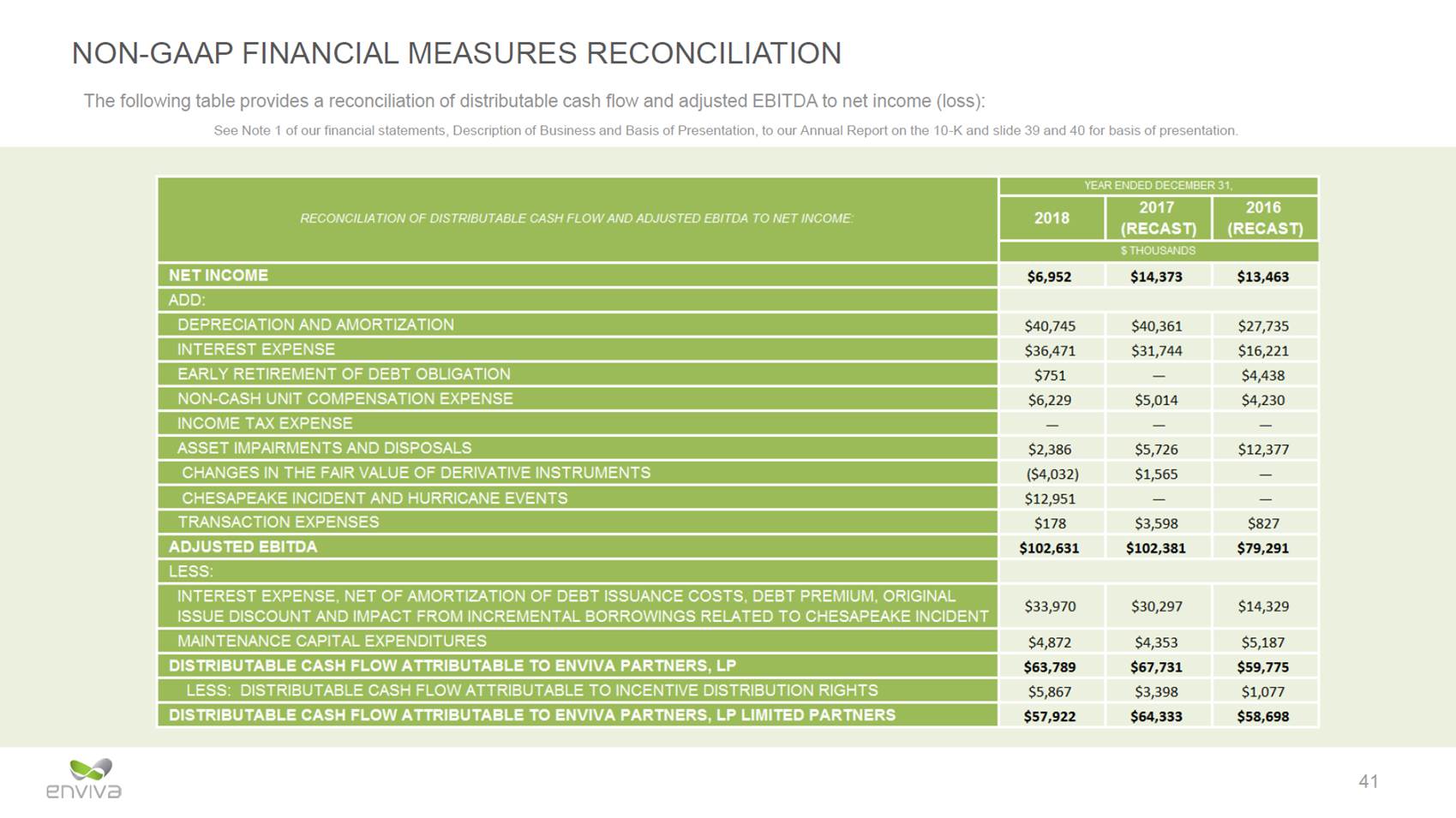
NON-GAAP FINANCIAL MEASURES RECONCILIATION (CONT.) The following table provides a reconciliation of distributable cash flow and adjusted EBITDA to net income (loss): See Note 1 of our financial statements, Description of Business and Basis of Presentation, to our Annual Report on the 10-K and slide 39 and 40 for basis of presentation. fUf!i!ii@if'lmiPJ fii•MI:If"IMI:IMfiiiiil:lE"'MII:I ($3,801) ($8,923) $9,387 $13,356 $3,544 ($19,335) $11,248 $9,196 $11,505 $9,334 $751 $625 $1,486 ($3,282) $3,952 $9,801 $9,445 $10,031 $9,047 $9,408 $8,645 $11,208 $9,633 $1,013 $350 ($2,334) ($281) $11,046 $525 $26,962 $2,472 $1,781 $656 $1,944 ($6,787) $2,480 $244 ($3,463) ($804) $1,343 $2,010 $289 $769 $16,590 1 $4,927 $21,616 $2 $33,760 $30 $30,226 ($7) $21,072 $153 $17,573 · $8,897 $8,848 $8,986 $7,839 $8,772 $8,373 $836 $17,229 $2,773 $14,456 $928 $11,840 $2,042 $9,798 $1,620 $23,154 $1,671 $21,483 $1,638 $20,749 $1,532 $19,217 $1,226 $11,074 $1,400 $9,674 $388 $8,812 $1,264 $7,548 1) Includes a) $10.9 million of MSA Fee Waivers in connection with the Hamlet Transaction where the Sponsor agreed to waive such fees that otherwise would be owed by (i) the First JV until the later of July 1, 2019 or commencement of commercial operations of the Hamlet plant, and (ii) the Partnership until June 30, 2020; b) $2.7 million of MSA Fee Waivers from our Sponsor as consideration for our assignment of two shipping contracts to our Sponsor, and c) $0.9 million of MSA Fee Waivers pursuant to the management services agreement between the First JV and the Sponsor prior to the Hamlet Transaction; 2) Includes $4.2 million of incremental costs incurred during the first quarter of 2019, which are unrepresentative of our ongoing operations, in connection with our evaluation of the potential purchase of a third-party wood pellet production plant (the "Potential Target") When we commenced our review, the Potential Target had recently returned to operations following an extended shutdown during a bankruptcy proceeding with the intent of demonstrating favorable operations prior to conducting an auction sale process; however, the Potential Target had not yet established a logistics chain through a viable export terminal, given that the terminal through which the plant historically had exported was not operational at the time and was not reasonably certain to become operational in the future Accordingly, as part of our diligence of the Potential Target, we developed an alternative logistics chain to bring the Potential Target's wood pellets to market and began purchasing the production of the Potential Target for a trial period. The incremental costs associated with the establishment and evaluation of this new logistics chain primarily consist of barge, freight, trucking, storage, and shiploading services. We have completed our evaluation of the alternative logistics chain and determined it is not viable; consequently, we do not expect to incur additional costs of this nature in the future; 3) Includes $1.2 million in costs incurred during the first and second quarter of 2019 related to the Hamlet Transaction, in addition to the costs described in footnote 2 42 DISTRIBUTABLE CASH FLOW ATTRIBUTABLE TO ENVIVA PARTNERS, LP LIMITED PARTNERS LESS DISTRIBUTABLE CASH FLOW ATTRI BUTABLE TO INCENTI VE DISTRIBUTION RIGHTS DISTRIBUTABLE CASH FLOW ATTRIBUTABLE TO ENVIVA PARTNERS, LP MAINTENANCE CAPITAL EXPENDITURES INTEREST EXPENSE, NET OF AMORTIZATION OF DEBT ISSUANCE COSTS , DEBT PREMIUM , ORIGINAL ISSUE DISCOUNT AND IMPACT FROM INCREMENTAL BORROWINGS RELATED TO CHESAPEAKE INCIDENT AND HURRICANE EVENTS LESS ADJUSTED EBITDA TRANSACTI ON EXPENSES I ACQUISITION COSTS 2 3 MSA FEE WAIVERS CHESAPEAKE INCIDENT AND HURRICANE EVENTS CHANGES IN THE FAIR VALUE OF DERI VATIVE INSTRUMENTS ASSET IMPAIRMENTS AND DISPOSALS NON-CASH UNIT COMPENSATION EXPENSE EARLY RETIREMENT OF DEBT OBLIGATI ON INTEREST EXPENSE DEPRECIATION AND AMORTIZATION NET INCOME (LOSS) S THOUSANDS RECONCIL/AT/ON OF NET INCOME (LOSS) TO ADJUSTED EBITOA AND DISTRIBUTABLE CASH FLOW THREE MONTHS ENDED
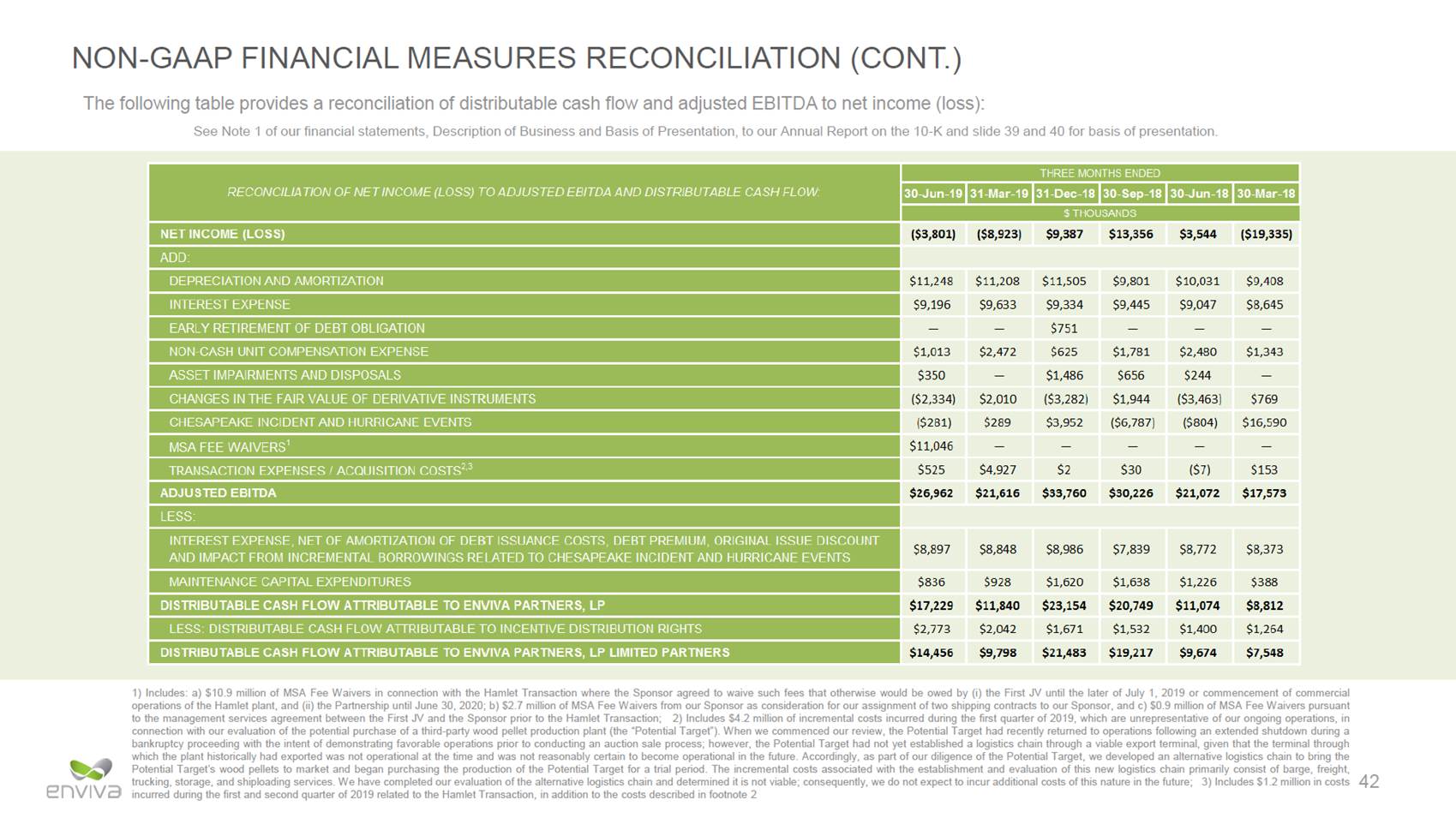
NON-GAAP FINANCIAL MEASURES RECONCILIATION (CONT.) The following table provides a reconciliation of gross margin to adjusted gross margin per metric ton: See Note 1 of our financial statements, Description of Business and Basis of Presentation, to our Annual Report on the 10-K and slide 39 and 40 for basis of presentation. , $16,507 $9,907 $24,529 $30,119 $19,811 ($5,018) $69,441 $78,802 $76,772 $350 $1,486 $656 $244 $2,386 $4,899 $2,386 $11,096 $11,070 $11,379 $9,678 $9,818 $9,304 $40,179 $39,904 $27,700 ($281) ($2,334) $359 $2,010 {$2,446) {$3,282) ($804) ($3,463) $16,590 $769 $7,799 ($4,032) $1,944 1 $4,243 $2,700 $28,038 $27,589 $31,666 $42,397 $25,606 $21,645 $115,773 $123,605 $106,858 869 843 874 762 699 648 2,983 2,724 2,346 $32.26 $32.73 $36.23 $55.64 $36.63 $33.40 $38.81 $45.38 $45.55 $32.26 $32.73 $36.23 $55.64 $36.63 $33.40 $38.81 $42.19 $43.94 1) Includes $4.2 million of incremental costs incurred during the first quarter of 2019, which are unrepresentative of our ongoing operations, in connection with our evaluation of the potential purchase of a third-party wood pellet production plant (the "Potential Target"). When we commenced our review, the Potential Target had recently returned to operations following an extended shutdown during a bankruptcy proceeding with the intent of demonstrating favorable operations prior to conducting an auction sale process; however, the Potential Target had not yet established a logistics chain through a viable export terminal, given that the terminal through which the plant historically had exported was not operational at the time and was not reasonably certain to become operational in the future Accordingly, as part of our diligence of the Potential Target, we developed an alternative logistics chain to bring the Potential Target's wood pellets to market and began purchasing the production of the Potential Target for a trial period. The incremental costs associated with the establishment and evaluation of this new logistics chain primarily consist of barge, freight, trucking, storage, and shiploading services. We have completed our evaluation of the alternative logistics chain and determined it is not viable; consequently, we do not expect to incur additional costs of this nature in the future 43 AGM PER METRIC TON, (Adjusted for ASC 606) ADJUSTED GROSS MARGIN PER METRIC TON METRIC TONS SOLD ADJUSTED GROSS MARGIN MSA FEE WAIVERS TRANSACTION EXPENSES I ACQUISITION COSTS CHANGES IN THE FAIR VALUE OF DERIVATIVE INSTRUMENTS CHESAPEAKE INCIDENT AND HURRICANE EVENTS DEPRECIATION AND AMORTIZATION LOSS ON DISPOSAL OF ASSETS GROSS MARGIN EXCEPT PER METRIC TON S THOUSANDS 30-Jun-19 31-Mar-19 31-Dec-18 30-Sep-18 30-Jun-18 31-Mar-18 31-Dec-18 31-Dec-17 31-Dec-16 RECONCILIATION OF GROSS MARGIN TO ADJUSTED GROSS MARGIN PER METRIC TON TWELVE MONTHS ENDED THREE MONTHS ENDED
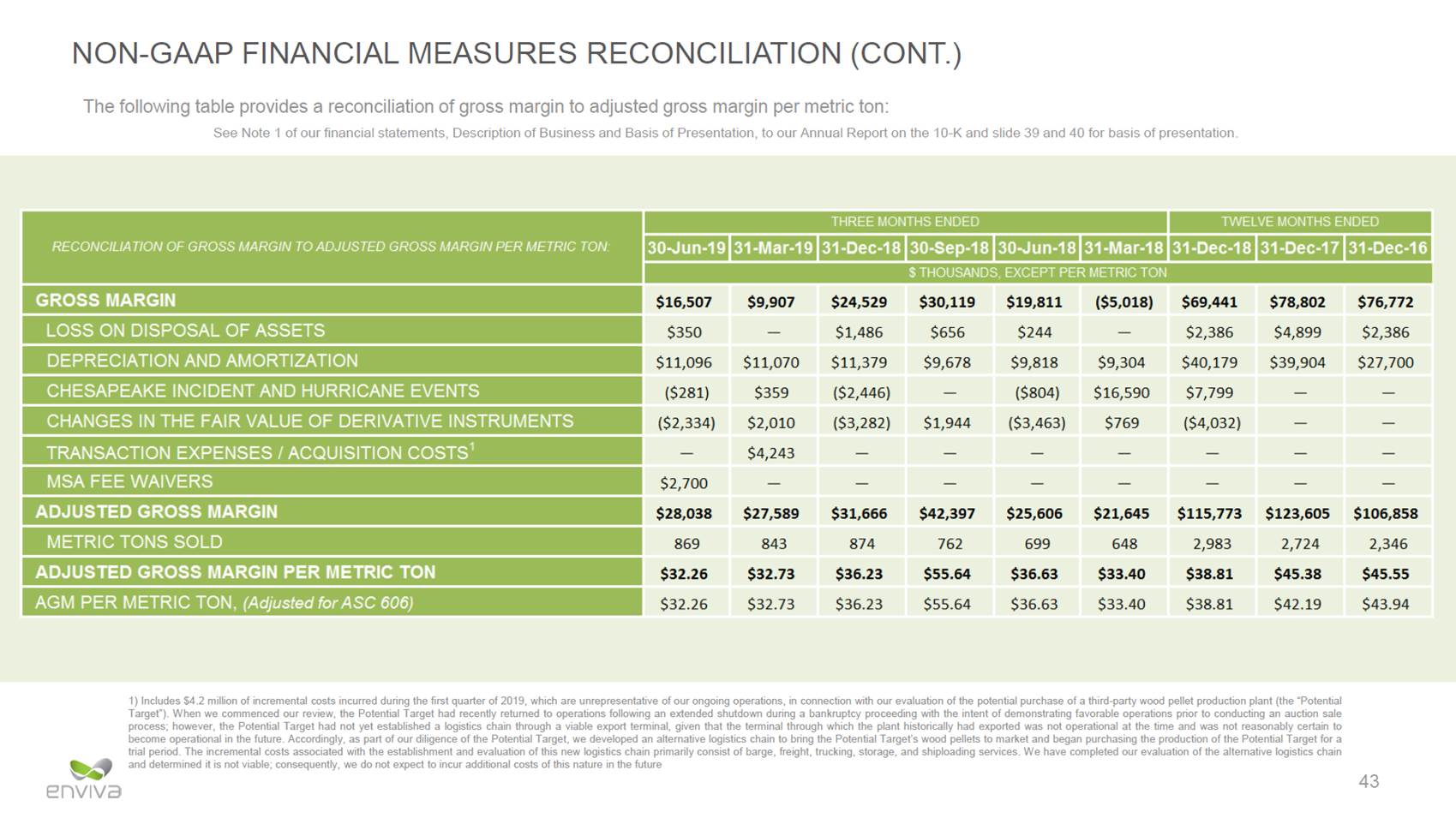
2019 GUIDANCE 1) On February 20, 2019, provided full-year 2019 guidance for net income in a range of $31.0 to $39.0 million and adjusted EBITDA in the range of $127 to $135 million; 2) On August 7, 2019, reaffirmed full-year 2019 guidance for net income in a range of $18.9 to $26.9 million and adjusted EBITDA in the range of $140.7 to $148.7 million, as previously provided on May 8, 2019; 3) Includes $4.2 million of incremental costs incurred during the first quarter of 2019, which are unrepresentative of our ongoing operations, in connection with our evaluation of the potential purchase of a third-party wood pellet production plant (the “Potential Target”). When we commenced our review, the Potential Target had recently returned to operations following an extended shutdown during a bankruptcy proceeding with the intent of demonstrating favorable operations prior to conducting an auction sale process; however, the Potential Target had not yet established a logistics chain through a viable export terminal, given that the terminal through which the plant historically had exported was not operational at the time and was not reasonably certain to become operational in the future. Accordingly, as part of our diligence of the Potential Target, we developed an alternative logistics chain to bring the Potential Target’s wood pellets to market and began purchasing the production of the Potential Target for a trial period. The incremental costs associated with the establishment and evaluation of this new logistics chain primarily consist of barge, freight, trucking, storage, and shiploading services. We have completed our evaluation of the alternative logistics chain and determined it is not viable; consequently, we do not expect to incur additional costs of this nature in the future; 4) Includes $1.2 million in costs incurred during the first and second quarter of 2019 related to the Hamlet Transaction, in addition to the costs described in footnote 3; 5) Includes: a) $10.9 million of MSA Fee Waivers in connection with the Hamlet Transaction where the Sponsor agreed to waive such fees that otherwise would be owed by (i) the First JV until the later of July 1, 2019 or commencement of commercial operations of the Hamlet plant, and (ii) the Partnership until June 30, 2020; b) $2.7 million of MSA Fee Waivers from our Sponsor as consideration for our assignment of two shipping contracts to our Sponsor, and c) $0.9 million of MSA Fee Waivers pursuant to the management services agreement between the First JV and the Sponsor prior to the Hamlet Transaction 44

NON-GAAP FINANCIAL MEASURES RECONCILIATION (CONT.) The following table provides a reconciliation of the estimated range of adjusted EBITDA to the estimated range of net income, in each case for the twelve months ending December 31, 2021 (in millions): I $87.7-117.7 $61.0 $47.8 $10.5 $3.0 $210-$240 1)Additional details are available as part of our press release as of March 25, 2019 45 ESTIMATED ADJUSTED EBITDA OTHER NON-CASH EXPENSES NON-CASH UNIT COMPENSATION EXPENSE INTEREST EXPENSE DEPRECIATION AND AMORTIZATION ADD: ESTIMATED NET INCOME $MILLIONS TWELVE MONTHS END NG DECEMBER 31 I 2021 1
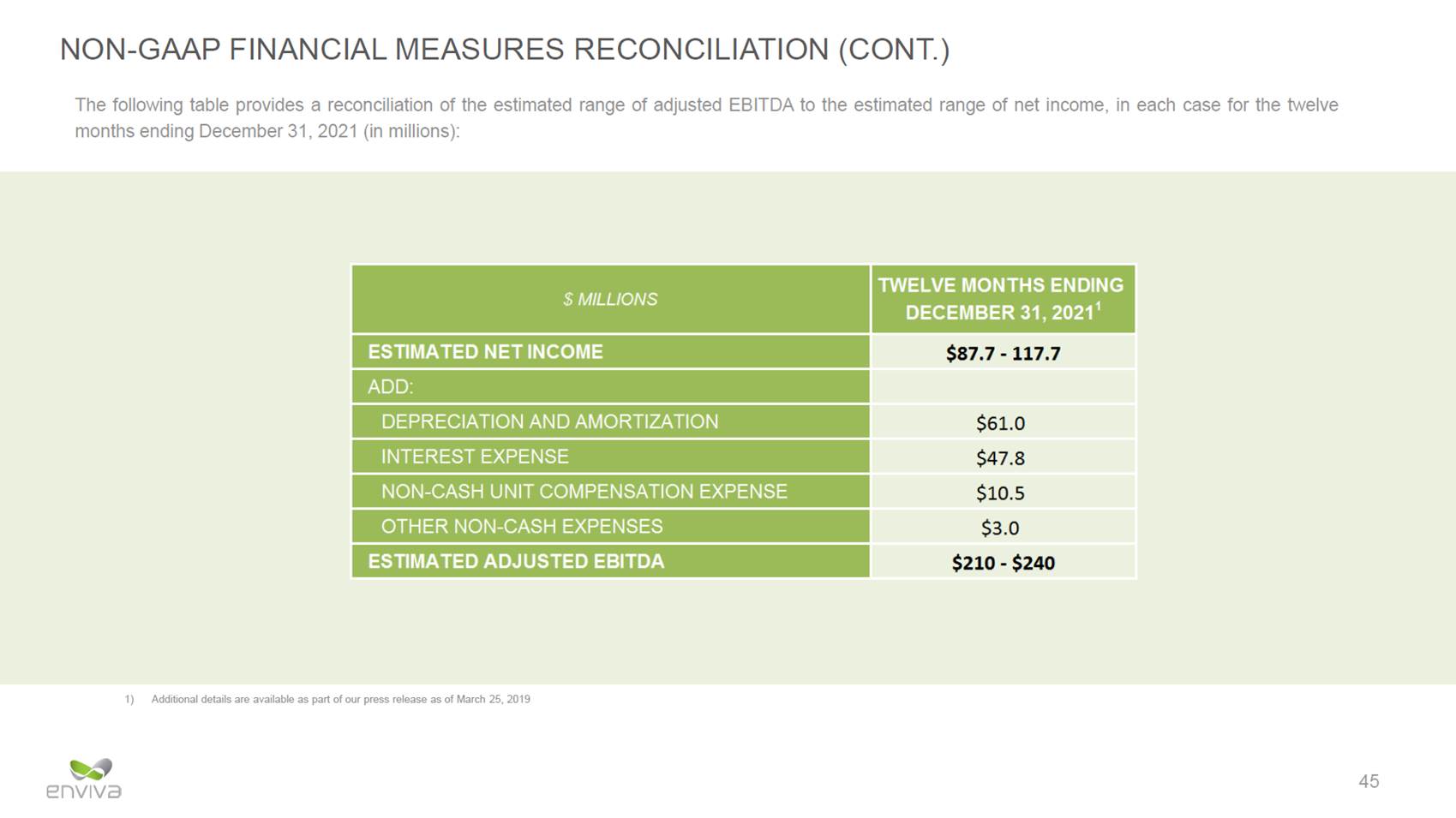
NON-GAAP FINANCIAL MEASURES RECONCILIATION (CONT.) The following table provides a reconciliation of the estimated adjusted EBITDA to the estimated net income associated with the Hamlet Transaction for the twelve months ending December 31, 2021 (in millions): 1) Additional details are available as part of our press release on March 25, 2019 46

NON-GAAP FINANCIAL MEASURES RECONCILIATION (CONT.) Our Sponsor’s estimates of incremental adjusted EBITDA for the Hamlet plant is based on numerous assumptions that are subject to significant risks and uncertainties. The assumptions underlying our Sponsor’s estimates of incremental adjusted EBITDA generated by certain of its assets are inherently uncertain and subject to significant business, economic, financial, regulatory, and competitive risks and uncertainties that could cause actual results and amounts to differ materially from those estimates. For more information about such significant risks and uncertainties, please see the risk factors discussed or referenced in our filings with the Securities and Exchange Commission (the “SEC”), including the Annual Report on Form 10-K and the Quarterly Reports on Form 10-Q most recently filed with the SEC. Presentation of net income and reconciliations of estimate of incremental adjusted EBITDA for potential drop-downs of wood pellet production plant(s) and marine terminal(s) are not provided because the GAAP net income to be generated by the potential drop-downs of wood pellet production plant(s) or marine terminal(s) is not available without unreasonable effort, in part because the amount of estimated incremental interest expense related to the financing of the potential drop-downs of wood pellet production plant(s) is not available at this time. Our estimate of incremental adjusted EBITDA from the planned expansions at Southampton and Northampton production plants (the “Mid-Atlantic Expansions”) is based on numerous assumptions that are subject to significant risks and uncertainties. Those assumptions are inherently uncertain and subject to significant business, economic, financial, regulatory, and competitive risks and uncertainties that could cause actual results and amounts to differ materially from such estimate. A presentation of net income and a reconciliation of the estimated incremental adjusted EBITDA expected to be generated by the Mid-Atlantic Expansions to the closest GAAP financial measure, net income, are not provided because net income expected to be generated by the expansions is not available without unreasonable effort, in part because the amount of estimated incremental interest expense related to the financing of the expansions and depreciation are not available at this time. 47
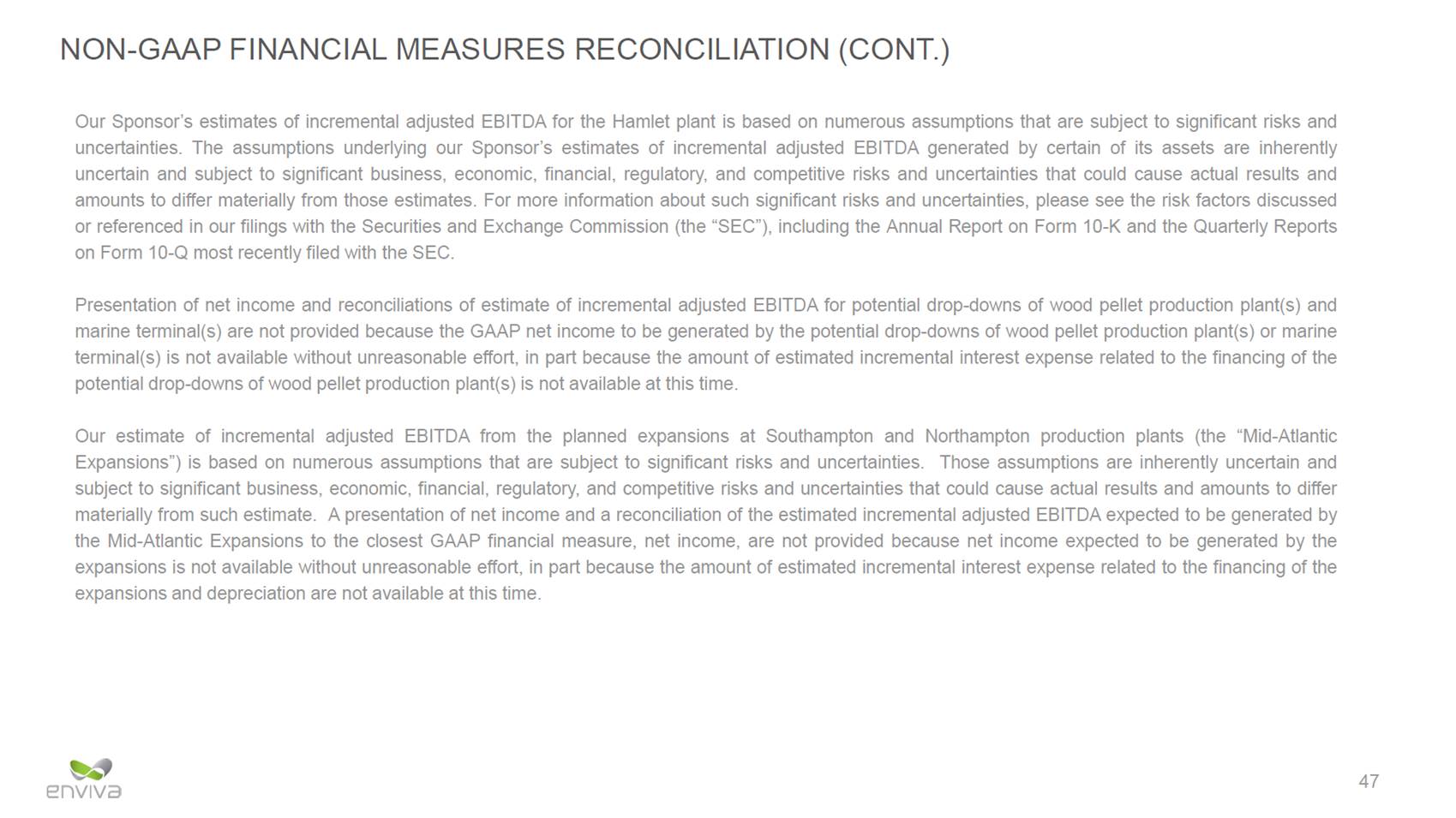
env1va Contact: Ray Kaszuba Senior Vice President,Finance and Treasurer +1240-482-3856 ir@envivapartners.com
